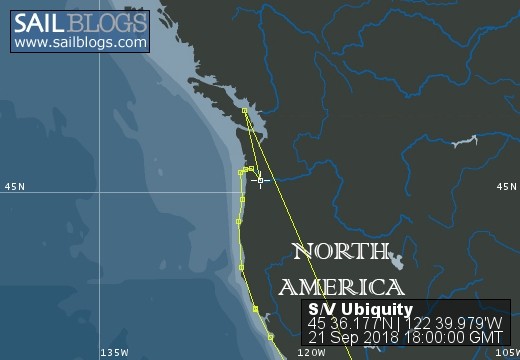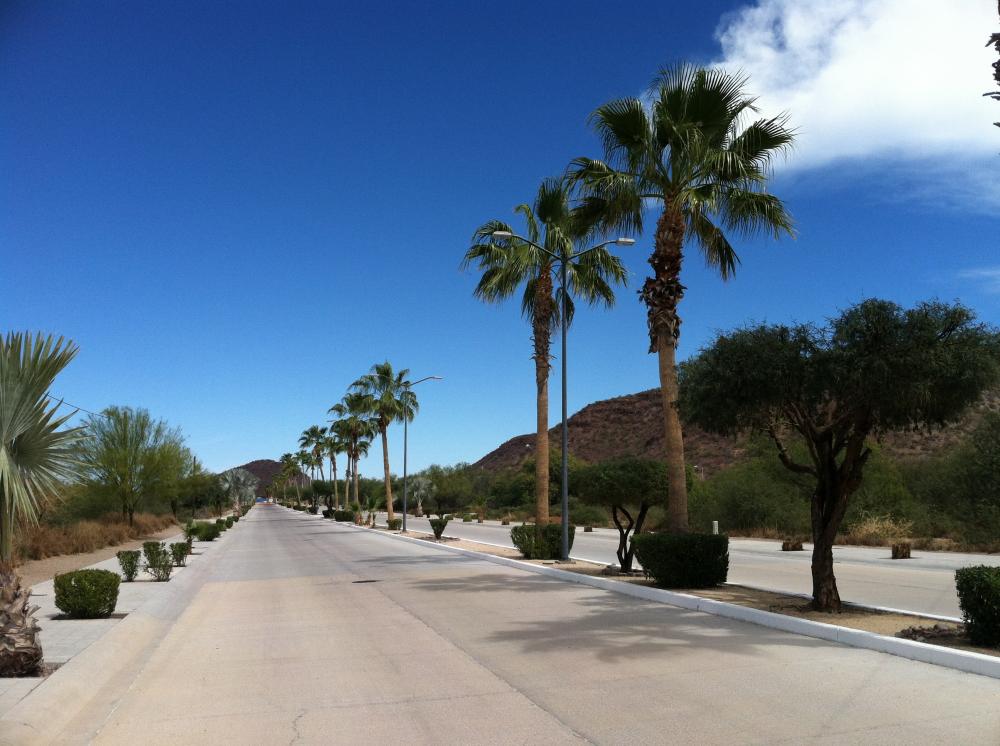

List of Recent Blog Posts
S/V Ubiquity Information, Cruising Photos and Videos, Current Positon:
26 June 2023 | Portland, Oregon
24 August 2021 | Newport, Oregon
22 August 2021 | Warrenton, Oregon
01 February 2020 | Portland, Oregon
20 October 2019 | Portland, Oregon
02 October 2019 | Sandy Airport, Oregon
28 July 2019 | Portland, Oregon
04 November 2018 | Portland, Oregon
03 November 2018 | Portland, Oregon
30 October 2018 | Portland, Oregon
29 September 2018 | Portland, Oregon
15 September 2018 | Port Angeles, Washington
12 June 2018 | Portland, Oregon
02 June 2018 | Victoria, Canada
30 May 2018 | Ganges, Saltspring Island, Canada
27 May 2018 | Nanaimo, Canada
20 May 2018 | Portland, Oregon
20 May 2018 | Portland, Oregon
18 May 2018 | Portland, Oregon
Hero Shots!
26 June 2023 | Portland, Oregon
Brian Stipak
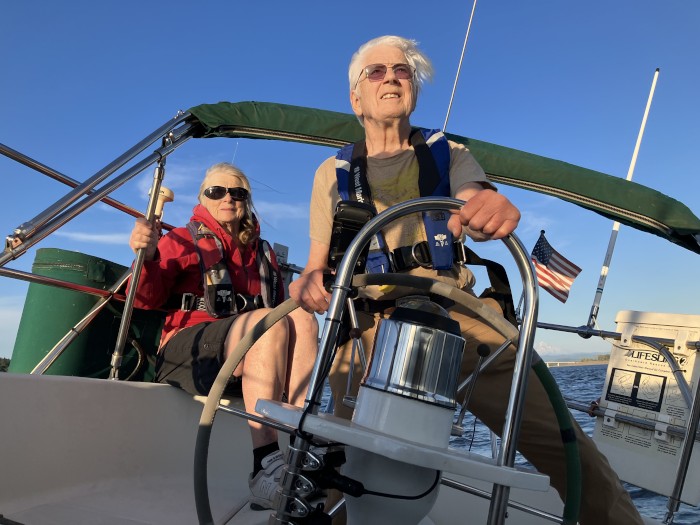
Hero shots, photos, do you like them? You know, photos that just make you or someone else look like a hero. If it's a hero shot of yourself, who could not like it - not me!
Here is a hero shot I took of my friend Jim at the helm of S/V Ubiquity, my Pacific Seacraft 34. Yesterday my friends Jim and Leslie joined me for sailing on the Columbia River in Portland, Oregon. I took a number of photos, trying to get a good one. And one, only one, came out I thought great, a true hero shot!
All three of us are either in our late 70's or early 80's, so getting any hero shots of any of us we do not expect, but we highly appreciate if it happens.
Here is a hero shot I took of my friend Jim at the helm of S/V Ubiquity, my Pacific Seacraft 34. Yesterday my friends Jim and Leslie joined me for sailing on the Columbia River in Portland, Oregon. I took a number of photos, trying to get a good one. And one, only one, came out I thought great, a true hero shot!
All three of us are either in our late 70's or early 80's, so getting any hero shots of any of us we do not expect, but we highly appreciate if it happens.
Tres Amigos Update
24 August 2021 | Newport, Oregon
Brian Stipak
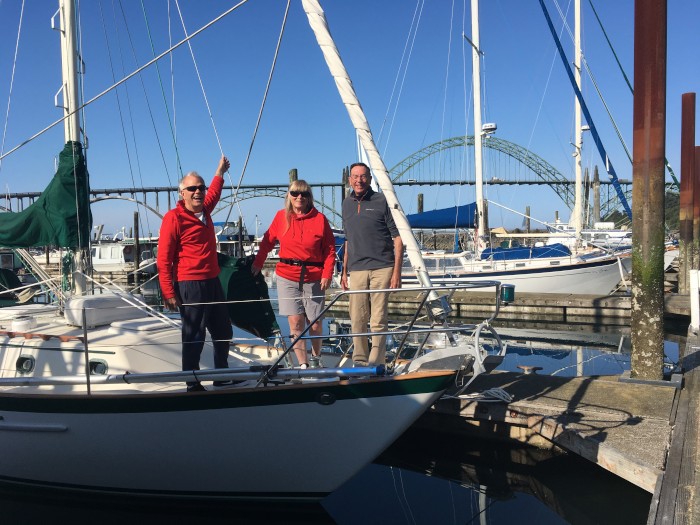
My last post posed the question, “Can three septuagenarians defeat the cruel diminishments and ravages of Father Time and his attendant cruel maladies? Are they just throwing themselves to their demise for the vanity of pretense that they still are what they are no longer, for not willing to admit to their septuagenerian disfunction?”
The accompanying photo gives you the answer. The photo shows the Tres Amigos standing on the bow of S/V Ubiquity, with the iconic Yaquina Bay Bridge (in Newport) in the background.
So yes, the Tres Amigos won, this time, their battle against Father Time.
Tres Amigos has diminished to Dos Amigos for the return trip to the Columbia River. The question now is, can these two septuagenarians again succeed, defeat again Father Time, and cross safely the “Graveyard of the Pacific” (the Columbia River Bar) and reach eventually the safety of their home port in Portland?
The accompanying photo gives you the answer. The photo shows the Tres Amigos standing on the bow of S/V Ubiquity, with the iconic Yaquina Bay Bridge (in Newport) in the background.
So yes, the Tres Amigos won, this time, their battle against Father Time.
Tres Amigos has diminished to Dos Amigos for the return trip to the Columbia River. The question now is, can these two septuagenarians again succeed, defeat again Father Time, and cross safely the “Graveyard of the Pacific” (the Columbia River Bar) and reach eventually the safety of their home port in Portland?
Tres Amigos - 221 years of life experience, but can they still sail a sailboat on the ocean?
22 August 2021 | Warrenton, Oregon
Brian Stipak
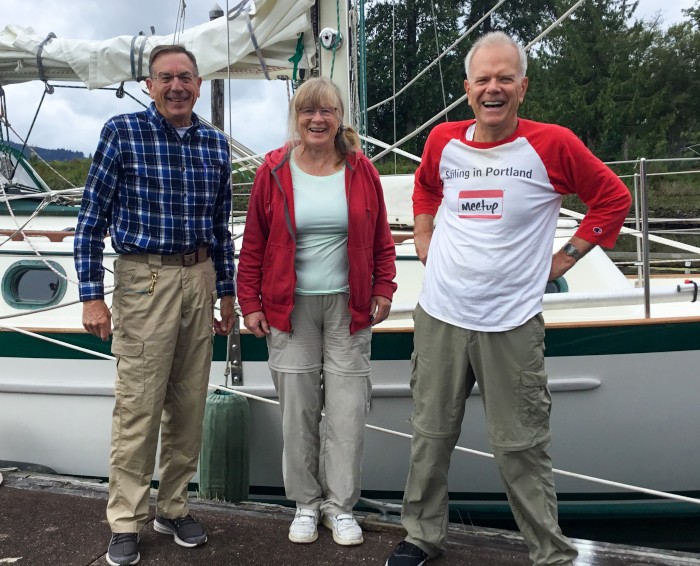
Yes, 221 years of combined (73+74+74) life experience. But we all know that longevity does not guarantee sagacity. Plus we know that capabilities can diminish with age, and 221 years certainly gives plenty of time for diminishment. Plus look at the reality of what they are: 2 of them are on beta blockers, one had part of the quadriceps muscles removed and a metal rod placed in the femur, two of them have had cancer, one of them had heart failure and had heart surgery, plus more.
So WHAT are these ancient testaments to lost youth trying to do, anyway?
Well, they are all experienced and skilled sailors (or perhaps WERE), but one of them, Gary, has never sailed offshore. For Gary that is on his bucket list. Over several years Brian and Gary have talked about some big possible offshore trips, but those trips never happened. So this year Brian proposed to make an offshore trip together while they still can, and do a short one that they can do now.
So Brian, Gary, and Leslie are now - as I write this - overnighting in Brian's Pacific Seacraft 34 sailboat at the marina in Warrenton, Oregon, only a few miles from the Columbia River Bar. Early in the morning they will depart Warrenton to cross the bar, then turn south for an overnight sail to Newport, Oregon. After a rest day to recover, they intend to beat their way back up the coast, sailing against the prevailing winds and seas. They expect that return to take two nights.
But can they do it? Can three septuagenarians defeat the cruel diminishments and ravages of Father Time and his attendant cruel maladies? Are they just throwing themselves to their demise for the vanity of pretense that they still are what they are no longer, for not willing to admit to their septuagenerian disfunction?
If you want to learn the answer, can these septuagenarians prevail or not, then read my follow-up post. Or perhaps you will read my obituary instead. Either way, you will get your answer.
So WHAT are these ancient testaments to lost youth trying to do, anyway?
Well, they are all experienced and skilled sailors (or perhaps WERE), but one of them, Gary, has never sailed offshore. For Gary that is on his bucket list. Over several years Brian and Gary have talked about some big possible offshore trips, but those trips never happened. So this year Brian proposed to make an offshore trip together while they still can, and do a short one that they can do now.
So Brian, Gary, and Leslie are now - as I write this - overnighting in Brian's Pacific Seacraft 34 sailboat at the marina in Warrenton, Oregon, only a few miles from the Columbia River Bar. Early in the morning they will depart Warrenton to cross the bar, then turn south for an overnight sail to Newport, Oregon. After a rest day to recover, they intend to beat their way back up the coast, sailing against the prevailing winds and seas. They expect that return to take two nights.
But can they do it? Can three septuagenarians defeat the cruel diminishments and ravages of Father Time and his attendant cruel maladies? Are they just throwing themselves to their demise for the vanity of pretense that they still are what they are no longer, for not willing to admit to their septuagenerian disfunction?
If you want to learn the answer, can these septuagenarians prevail or not, then read my follow-up post. Or perhaps you will read my obituary instead. Either way, you will get your answer.
Debate within a Democracy: Do You Believe in Our Democracy?
18 June 2020
Brian Stipak

All of us living in the United States gain some of the benefits of living in a country structured governmentally as a constitutional democracy. But observing our country today I conclude that many beneficiaries (i.e. all Americans) of that structure do not understand, or even believe in, that structure.
The essence of that structure is the protection of different groups and the provision of political means for the competition of divergent political ideas. If you believe in this, believe in democracy, that means you believe in the protection of people and beliefs different from you.
So if you are a liberal by your political beliefs, and if you believe in democracy, then you must cherish the protections our democratic system gives to those of conservative political ideas. If you are a conservative by your political beliefs, and if you believe in democracy, then you must cherish the protections our democratic system gives to those of liberal political ideas.
A democratic structure facilitates diversity of beliefs to compete in the democratic process. This contrasts to authoritarian states, typically one-party (i.e. National Socialist Party, Communist Party) in which orthodoxy becomes state-sanctioned.
YOUR TEST:
So let me give you a test so you can see if you actually believe in and participate in the benefits our constitutional democracy offers you. Here is the test: Think of current political columnists, commentators, and writers who you find insightful. Name 2 conservatives, 2 liberals, and 1 middle-of-the-roader who you find insightful or stimulating.
If you are a liberal and can not name any conservatives, or if you are a conservative and can not name any liberals, then you fail this test.
MY ANSWERS:
I will take the test also, and here are my answers for some of my favorite columnists, commentators, and writers:
Conservative: George Will, William Kristol
Liberal: Mark Shields, Noam Chomsky
Middle-Of-The-Road: David Brooks
(If inclined, put your answers below in comments.)
The essence of that structure is the protection of different groups and the provision of political means for the competition of divergent political ideas. If you believe in this, believe in democracy, that means you believe in the protection of people and beliefs different from you.
So if you are a liberal by your political beliefs, and if you believe in democracy, then you must cherish the protections our democratic system gives to those of conservative political ideas. If you are a conservative by your political beliefs, and if you believe in democracy, then you must cherish the protections our democratic system gives to those of liberal political ideas.
A democratic structure facilitates diversity of beliefs to compete in the democratic process. This contrasts to authoritarian states, typically one-party (i.e. National Socialist Party, Communist Party) in which orthodoxy becomes state-sanctioned.
YOUR TEST:
So let me give you a test so you can see if you actually believe in and participate in the benefits our constitutional democracy offers you. Here is the test: Think of current political columnists, commentators, and writers who you find insightful. Name 2 conservatives, 2 liberals, and 1 middle-of-the-roader who you find insightful or stimulating.
If you are a liberal and can not name any conservatives, or if you are a conservative and can not name any liberals, then you fail this test.
MY ANSWERS:
I will take the test also, and here are my answers for some of my favorite columnists, commentators, and writers:
Conservative: George Will, William Kristol
Liberal: Mark Shields, Noam Chomsky
Middle-Of-The-Road: David Brooks
(If inclined, put your answers below in comments.)
Charitable Contributions: Giving Money, Giving Time
01 February 2020 | Portland, Oregon
Brian Stipak

U.S. income tax law encourages charitable giving, since charitable contributions are deductible for taxpayers who itemize. For that reason, and for a desire to help worthy causes and those less fortunate, I have always made some monetary contributions to charities. Like many, when working I had monthly charitable payroll deductions taken from my salary. Recently, at an old age I have increased my charitable monetary giving.
But recently I have also tried giving some time, as well as money. To be sure, when younger I did give some of my time to charitable causes as a big brother for the Big Brothers Big Sisters organization, and as a volunteer for the Children's Cancer Association. But I had not donated time for a while until last year when I started helping some nights at a homeless shelter.
My activities at the homeless shelter included serving food, greeting the clients, cleaning up, and spending the night as potential support for the paid overnight supervisor (Lisa, my girlfriend, who was the person who got me involved in the shelter). Serving food and greeting the clients was the most fun, because everyone likes you when you are giving them food. I ate the food too; it was homemade and good. The overnight stays in the shelter were punctuated by some tense moments when yelling would break out and I had to be ready to help the supervisor.
Dealing with the clients I saw some things that I expected. This shelter is a "low-barrier" shelter, which means that it lets clients over-night in the shelter who have mental health problems and who are under the influence of drugs. Plus there are families with children and people with dogs. Not surprisingly, I had more contact than I had before in my life with people who were seriously mentally ill, people who were under the influence of drugs, and people who suffered from both mental illness and drug addiction.
But I did not expect to see as many clients (Maybe a third of the clients) who had no mental or drug problems but rather seemed to be there for bad-luck and circumstantial reasons. Some had lost their jobs. Some had gotten divorced and lost their homes. Some families had a family member working but did not have enough resources to rent a place to stay, so they had to sleep in their car or in the shelter.
Lucky for all of these clients, during the cold winter months the shelter gave them an option for a safe and warm place to stay at night.
Something else I did not expect was the high level of conversation of some of the clients. Some were obviously quite educated and thoughtful. I noted when one client used the word "narcissistic" in conversation, and when another used the word "hubris".
The shelter I have volunteered at, and also contributed money to, is part of Silverton Sheltering Services. Besides the overnight warming shelter, the services include a day center and the provision of services to help clients transition out of homelessness.
But recently I have also tried giving some time, as well as money. To be sure, when younger I did give some of my time to charitable causes as a big brother for the Big Brothers Big Sisters organization, and as a volunteer for the Children's Cancer Association. But I had not donated time for a while until last year when I started helping some nights at a homeless shelter.
My activities at the homeless shelter included serving food, greeting the clients, cleaning up, and spending the night as potential support for the paid overnight supervisor (Lisa, my girlfriend, who was the person who got me involved in the shelter). Serving food and greeting the clients was the most fun, because everyone likes you when you are giving them food. I ate the food too; it was homemade and good. The overnight stays in the shelter were punctuated by some tense moments when yelling would break out and I had to be ready to help the supervisor.
Dealing with the clients I saw some things that I expected. This shelter is a "low-barrier" shelter, which means that it lets clients over-night in the shelter who have mental health problems and who are under the influence of drugs. Plus there are families with children and people with dogs. Not surprisingly, I had more contact than I had before in my life with people who were seriously mentally ill, people who were under the influence of drugs, and people who suffered from both mental illness and drug addiction.
But I did not expect to see as many clients (Maybe a third of the clients) who had no mental or drug problems but rather seemed to be there for bad-luck and circumstantial reasons. Some had lost their jobs. Some had gotten divorced and lost their homes. Some families had a family member working but did not have enough resources to rent a place to stay, so they had to sleep in their car or in the shelter.
Lucky for all of these clients, during the cold winter months the shelter gave them an option for a safe and warm place to stay at night.
Something else I did not expect was the high level of conversation of some of the clients. Some were obviously quite educated and thoughtful. I noted when one client used the word "narcissistic" in conversation, and when another used the word "hubris".
The shelter I have volunteered at, and also contributed money to, is part of Silverton Sheltering Services. Besides the overnight warming shelter, the services include a day center and the provision of services to help clients transition out of homelessness.
A Twisty Road to Nowhere
20 October 2019 | Portland, Oregon
Brian Stipak
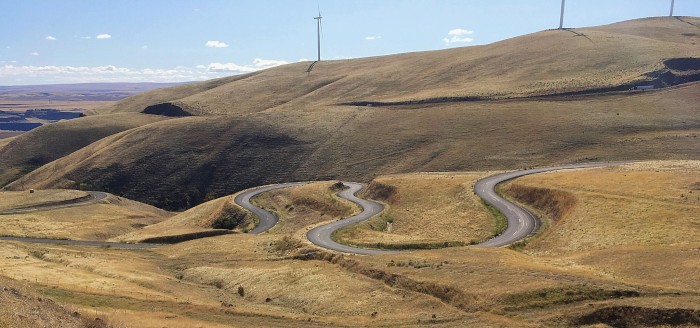
This photo shows a twisty road with hairpin turns, a road to nowhere. The road ascends from the Columbia River about 1000 feet in about 4 miles, and is open to motor vehicle traffic only two days each year. Although now a dead-end road, it once was a functioning highway connecting the north side of the Columbia River to Goldendale, Washington.
Why is that road there? Sam Hill built that road over 100 years ago. Maryhill Museum of Art founder Sam Hill was a vocal advocate for modern roads in the Pacific Northwest. In 1913 he convinced the Oregon governor and legislature to visit Maryhill and see the 10 miles of demonstration roads he had constructed using new construction and paving methods. This led to funding and building the historic Columbia River Highway.
I took this photo after driving my Miata to the top of the road on one of the two days each year that the road is open.
More information about this road and about the legacy of Sam Hill is available on-line.
Why is that road there? Sam Hill built that road over 100 years ago. Maryhill Museum of Art founder Sam Hill was a vocal advocate for modern roads in the Pacific Northwest. In 1913 he convinced the Oregon governor and legislature to visit Maryhill and see the 10 miles of demonstration roads he had constructed using new construction and paving methods. This led to funding and building the historic Columbia River Highway.
I took this photo after driving my Miata to the top of the road on one of the two days each year that the road is open.
More information about this road and about the legacy of Sam Hill is available on-line.
The Gold Rush Reality TV Show Becomes My Reality Too
02 October 2019 | Sandy Airport, Oregon
Brian Stipak
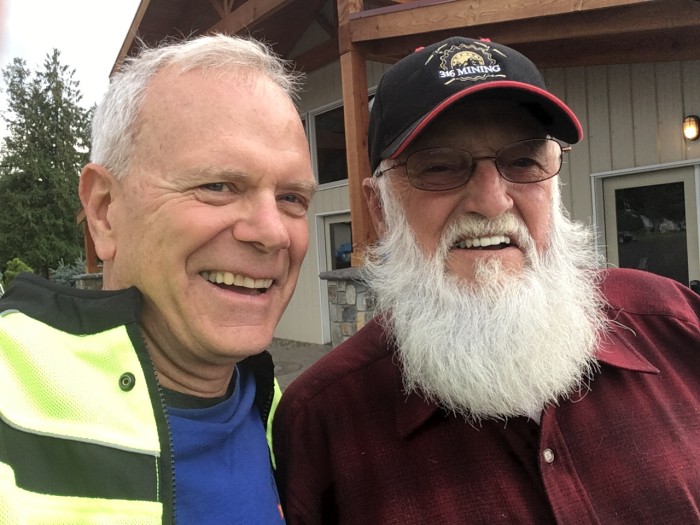
If you know me, then you will recognize me on the left in this photo.
If you watch the reality TV show Gold Rush on the Discovery Channel, then you will recognize Jack Hoffman on the right in this photo.
I got the chance to shoot this selfie with Jack Hoffman when I ran into him at the Sandy airport, when I was on a motorcycle ride. I had forgotten that the Hoffmans owned that airport, and when I saw him there at first I thought I recognized him because I knew him, and then it clicked who he was. Jack was gracious to agree to a selfie and to answer my questions, and he came across as friendly and unpretentious, just as he appears on the Gold Rush show.
It was fun to run into and talk with Jack Hoffman.
If you watch the reality TV show Gold Rush on the Discovery Channel, then you will recognize Jack Hoffman on the right in this photo.
I got the chance to shoot this selfie with Jack Hoffman when I ran into him at the Sandy airport, when I was on a motorcycle ride. I had forgotten that the Hoffmans owned that airport, and when I saw him there at first I thought I recognized him because I knew him, and then it clicked who he was. Jack was gracious to agree to a selfie and to answer my questions, and he came across as friendly and unpretentious, just as he appears on the Gold Rush show.
It was fun to run into and talk with Jack Hoffman.
Drive It Like You Just Stole It!
28 July 2019 | Portland, Oregon
Brian Stipak
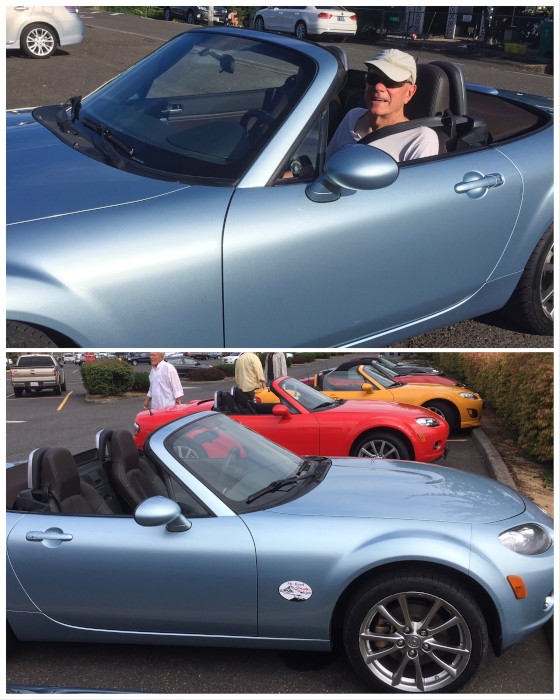
“Drive it like you just stole it!”
- Advice to a new Miata owner
The top photo above shows me seated in my new Miata sports car. For Miata aficionados it is a 2008 NC1 Special Edition, mainly in original condition.
The bottom photo shows my Miata enjoying companionship of other Miatas from the Mount Hood Miata Club. Today I enjoyed a club ride to Vernonia, Oregon. Following closely behind some of the experienced members leading our pack of Miatas on a twisty mountain road, with the top down and listening to high-energy music, was a lot of fun and helped me with my driving skills. Our lead pack took the turns posted 25 mph at 45 mph, and the 20 mph turns at 40 mph, and driving a Miata makes that easy.
How do you drive a Miata? The best advice I heard today was “Drive it like you just stole it!”
- Advice to a new Miata owner
The top photo above shows me seated in my new Miata sports car. For Miata aficionados it is a 2008 NC1 Special Edition, mainly in original condition.
The bottom photo shows my Miata enjoying companionship of other Miatas from the Mount Hood Miata Club. Today I enjoyed a club ride to Vernonia, Oregon. Following closely behind some of the experienced members leading our pack of Miatas on a twisty mountain road, with the top down and listening to high-energy music, was a lot of fun and helped me with my driving skills. Our lead pack took the turns posted 25 mph at 45 mph, and the 20 mph turns at 40 mph, and driving a Miata makes that easy.
How do you drive a Miata? The best advice I heard today was “Drive it like you just stole it!”
Second Childhood? Or Gathering More Rose Buds?
04 November 2018 | Portland, Oregon
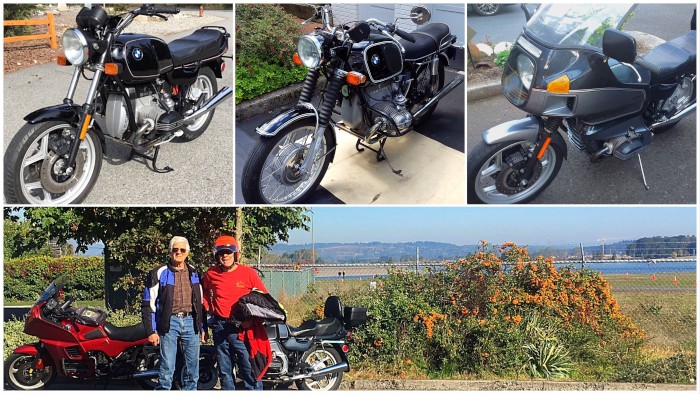
"I am just making up for being far too sensible when I was young."
― Robert Black
I think I am gathering more rose buds, but my friends think I am going through a second childhood. Why? Well, after my heart surgery I bought two motorcycles.
Let me explain....
My heart surgery confronted me emotionally with my mortality and my limited time left. So I did some sensible things like review distribution of my finances when I die. But I also took some actions you may not find sensible, even though for me I am just gathering more rose buds.
In 1982 I sold my last motorcycle (until the two I just bought). I was sensible. I knew I could kill myself and lose the rest of my life, most of which was still ahead of me. But thirty-six years later most of my life is now behind me. What was not sensible for me at age 35 is not the same at age 70.
In the hospital post-surgery I thought about the BMW R75/5 that I sold in 1982. I loved that bike. It was a classic. I rode that bike through the mountains of Pennsylvania and Virginia. And that bike today is still as pristine as when I sold it, which I know from an email and photo I received recently from the owner, the same person I sold my bike to in 1982.
So when I had recovered enough I went in search of my beloved BMW. I found her. She is an updated, thirty-two year old version of my R75/5, an R80, and she is pristine. Look at the two top photos above on the left. The two bikes look so close that I need to tell you which is my old bike and which is my new bike - the R80 is on the left.
After buying the R80 I decided I needed another bike set up for touring, which would be even better than my old bike for touring the roads of eastern Oregon. So I bought an R100RT from 1995, the last year that BMW made these old style motorbikes. The R100RT has a built-in fairing (wind protector), a back locker, and two panniers (saddlebags) that are like little suitcases that clip to the sides. You can see my R100RT above and to the right.
The lower photo above shows me (with red helmet), my R100RT (on right) in St. Helens, Oregon. We were touring along the Columbia River and on Sauvie Island on a beautiful October day. I am with my friend Jim (75 years old and going strong bicycling and riding his old BMW motorcycle). My girlfriend Lisa took the photo, and she was brave enough (crazy enough?) to ride two-up with me on the R100RT.
So if I convinced you, then you know that I am gathering more rose buds. But maybe you too think that I am having a second childhood.
― Robert Black
I think I am gathering more rose buds, but my friends think I am going through a second childhood. Why? Well, after my heart surgery I bought two motorcycles.
Let me explain....
My heart surgery confronted me emotionally with my mortality and my limited time left. So I did some sensible things like review distribution of my finances when I die. But I also took some actions you may not find sensible, even though for me I am just gathering more rose buds.
In 1982 I sold my last motorcycle (until the two I just bought). I was sensible. I knew I could kill myself and lose the rest of my life, most of which was still ahead of me. But thirty-six years later most of my life is now behind me. What was not sensible for me at age 35 is not the same at age 70.
In the hospital post-surgery I thought about the BMW R75/5 that I sold in 1982. I loved that bike. It was a classic. I rode that bike through the mountains of Pennsylvania and Virginia. And that bike today is still as pristine as when I sold it, which I know from an email and photo I received recently from the owner, the same person I sold my bike to in 1982.
So when I had recovered enough I went in search of my beloved BMW. I found her. She is an updated, thirty-two year old version of my R75/5, an R80, and she is pristine. Look at the two top photos above on the left. The two bikes look so close that I need to tell you which is my old bike and which is my new bike - the R80 is on the left.
After buying the R80 I decided I needed another bike set up for touring, which would be even better than my old bike for touring the roads of eastern Oregon. So I bought an R100RT from 1995, the last year that BMW made these old style motorbikes. The R100RT has a built-in fairing (wind protector), a back locker, and two panniers (saddlebags) that are like little suitcases that clip to the sides. You can see my R100RT above and to the right.
The lower photo above shows me (with red helmet), my R100RT (on right) in St. Helens, Oregon. We were touring along the Columbia River and on Sauvie Island on a beautiful October day. I am with my friend Jim (75 years old and going strong bicycling and riding his old BMW motorcycle). My girlfriend Lisa took the photo, and she was brave enough (crazy enough?) to ride two-up with me on the R100RT.
So if I convinced you, then you know that I am gathering more rose buds. But maybe you too think that I am having a second childhood.
Fall Backpacking - Gathering More Rose Buds
03 November 2018 | Portland, Oregon
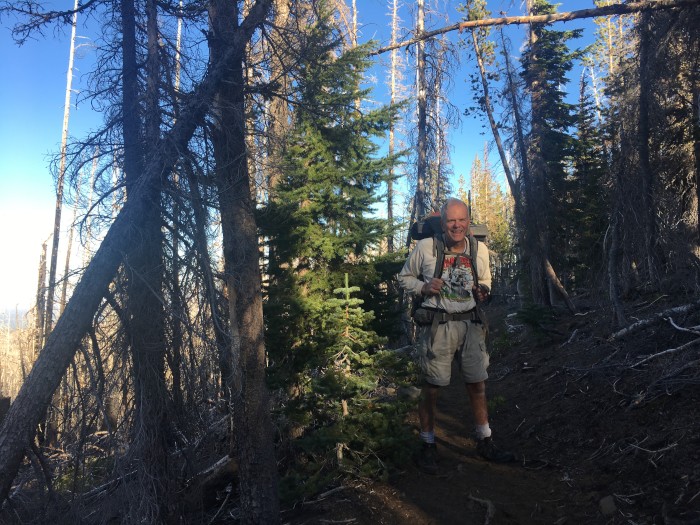
"Gather ye rosebuds while ye may,
Old Time is still a-flying;
And this same flower that smiles today
Tomorrow will be dying."
- Robert Herrick
Above photo shows me in October backpacking in the Three Sisters Wilderness. One of my close friends, who has also had heart surgery, warned me not to do it so close to my heart surgery. But I thought I could do it and I did do it.
Well, I sort of did it. I did carry a full pack, although not super heavy. I did hike some miles on trails and a little cross-country, although not always as fast as I would have in the past.
But a backpack trip should probably be defined as staying out overnight, right? And that is where my claim to backpacking is weak.
My plan was to hike cross-country to the east side of the base of North Sister, near the Soap Creek headwaters. This is a delightful cross-country trip that I have done probably over a dozen times in all times of the year, in all types of conditions. Usually I have skied into there in the Spring. So it is one of my favorite wilderness trips and I wanted to repeat it.
What happened? In 2012 the Pole Creek forest fire devastated part of this area. I knew about the fire of course, and in fact I had hided through part of the burned area in 2012 and witnessed the total devastation. When I hiked this year through the burned area it was uplifting to see the process of life returning. However, the downed timber from the fire precluded hiking cross-country through the forest like I had done before, and my attempt to find an alternative route that avoided the downed timber failed.
So on my post-surgery, October backpack trip we hiked back to the trailhead at sunset, having failed at finding a feasible hiking route to our destination.
Did I really do a backpack trip or not? You decide.
But I did carry the full backpack a number of miles on trails and on some cross-country hiking. That I was able to do that post heart surgery, I feel grateful. Even though my planned trip failed, I still feel that I gathered more rose buds.
Old Time is still a-flying;
And this same flower that smiles today
Tomorrow will be dying."
- Robert Herrick
Above photo shows me in October backpacking in the Three Sisters Wilderness. One of my close friends, who has also had heart surgery, warned me not to do it so close to my heart surgery. But I thought I could do it and I did do it.
Well, I sort of did it. I did carry a full pack, although not super heavy. I did hike some miles on trails and a little cross-country, although not always as fast as I would have in the past.
But a backpack trip should probably be defined as staying out overnight, right? And that is where my claim to backpacking is weak.
My plan was to hike cross-country to the east side of the base of North Sister, near the Soap Creek headwaters. This is a delightful cross-country trip that I have done probably over a dozen times in all times of the year, in all types of conditions. Usually I have skied into there in the Spring. So it is one of my favorite wilderness trips and I wanted to repeat it.
What happened? In 2012 the Pole Creek forest fire devastated part of this area. I knew about the fire of course, and in fact I had hided through part of the burned area in 2012 and witnessed the total devastation. When I hiked this year through the burned area it was uplifting to see the process of life returning. However, the downed timber from the fire precluded hiking cross-country through the forest like I had done before, and my attempt to find an alternative route that avoided the downed timber failed.
So on my post-surgery, October backpack trip we hiked back to the trailhead at sunset, having failed at finding a feasible hiking route to our destination.
Did I really do a backpack trip or not? You decide.
But I did carry the full backpack a number of miles on trails and on some cross-country hiking. That I was able to do that post heart surgery, I feel grateful. Even though my planned trip failed, I still feel that I gathered more rose buds.
Fall Bicycling - Gathering More Rose Buds
30 October 2018 | Portland, Oregon
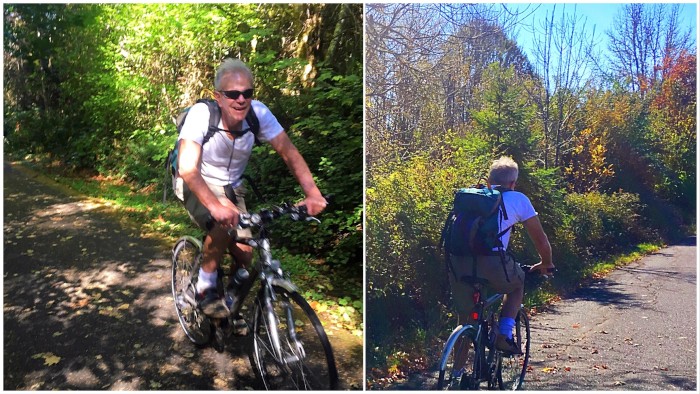
“Gather ye rosebuds while ye may,
Old Time is still a-flying;
And this same flower that smiles today
Tomorrow will be dying.”
- Robert Herrick
Above photos show see me on an October bike ride this month in beautiful Fall weather. This trail is a state bicycle trail between Banks, Oregon, and Vernonia, Oregon, and is a beautiful ride.
So after my setback, my health scare, this past summer, I am now back to gathering rosebuds.
Old Time is still a-flying;
And this same flower that smiles today
Tomorrow will be dying.”
- Robert Herrick
Above photos show see me on an October bike ride this month in beautiful Fall weather. This trail is a state bicycle trail between Banks, Oregon, and Vernonia, Oregon, and is a beautiful ride.
So after my setback, my health scare, this past summer, I am now back to gathering rosebuds.
Success, Sweet Success
29 September 2018 | Portland, Oregon
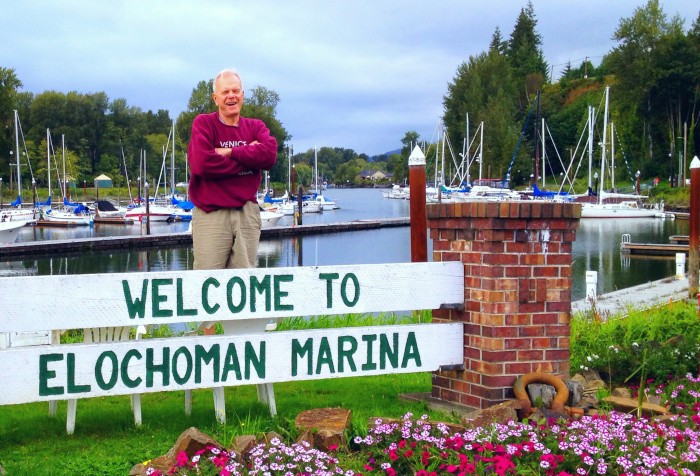
"God looks out for fools and babies."
- Meshell Ndegeocello
Above photo shows me in Cathlamet, Washington, after successfully bringing S/V Ubiquity down the Washington coast. Ubiquity lies now in Portland, safely tucked into her slip that she left two years ago to sail to Mexico.
We motored out the Strait of Juan de Fuca in mild conditions, and started motoring south down the Washington coast before getting a good sailing wind that blew us to the Columbia River Bar and to Astoria. It was great to be sailing, "back in the saddle", again after the health interruptions of this past summer.
My usual offshore crew member, Leslie, was not able to sail with me on this trip because she had broken her arm falling off of a bicycle, so she had to settle for driving us to Port Angeles and seeing us off. Instead, I had my girlfriend Lisa and her daughter (grown-up) Sierra as crew. This was brave for Lisa, because in the past she had gotten terribly seasick sailing offshore, although she does fine in more protected waters like the San Juans. History repeated itself and Lisa suffered from Mal de Mer all the way down the Washington coast, confined to a berth below. Luckily, Sierra was able to share with me the watch-keeping duties.
To be honest with my readers, I should confess an error I made when on watch at night approaching the Columbia River Bar. I was tired, and was using the method of setting an alarm for twenty minutes, catching a nap in the quarter berth, then getting up with the alarm to scan visually for traffic and to check for AIS targets. Well, I forgot to push the button on the timer when getting into the quarter berth at about two hours before sunrise. I woke up to sunlight and quickly scampered top-side to see the Columbia River Bar entrance buoy in sight. We had almost sailed past where we needed to turn. We were almost like that airplane in which both pilots went to sleep and woke up to see that they had over-flown their destination airport by one hundred miles.
The pilots of that airliner got fired. As the captain of S/V Ubiquity no one could fire me, although I certainly deserved it. But we survived nonetheless sailing at hull speed for two hours headed for the Columbia River Bar entrance with no one in control. Luckily, the Ndegeocello quote above proved true.
So safely back in her Portland berth after two years in Mexico, S/V Ubiquity awaits her next big adventure. That may be another circumnavigation of Vancouver Island, a great trip that Ubiquity and I have done twice. In 2019 I may do that trip with my friend Gary Lindstrom, who will be sailing his Pacific Seacraft Dana, S/V Kestrel.
- Meshell Ndegeocello
Above photo shows me in Cathlamet, Washington, after successfully bringing S/V Ubiquity down the Washington coast. Ubiquity lies now in Portland, safely tucked into her slip that she left two years ago to sail to Mexico.
We motored out the Strait of Juan de Fuca in mild conditions, and started motoring south down the Washington coast before getting a good sailing wind that blew us to the Columbia River Bar and to Astoria. It was great to be sailing, "back in the saddle", again after the health interruptions of this past summer.
My usual offshore crew member, Leslie, was not able to sail with me on this trip because she had broken her arm falling off of a bicycle, so she had to settle for driving us to Port Angeles and seeing us off. Instead, I had my girlfriend Lisa and her daughter (grown-up) Sierra as crew. This was brave for Lisa, because in the past she had gotten terribly seasick sailing offshore, although she does fine in more protected waters like the San Juans. History repeated itself and Lisa suffered from Mal de Mer all the way down the Washington coast, confined to a berth below. Luckily, Sierra was able to share with me the watch-keeping duties.
To be honest with my readers, I should confess an error I made when on watch at night approaching the Columbia River Bar. I was tired, and was using the method of setting an alarm for twenty minutes, catching a nap in the quarter berth, then getting up with the alarm to scan visually for traffic and to check for AIS targets. Well, I forgot to push the button on the timer when getting into the quarter berth at about two hours before sunrise. I woke up to sunlight and quickly scampered top-side to see the Columbia River Bar entrance buoy in sight. We had almost sailed past where we needed to turn. We were almost like that airplane in which both pilots went to sleep and woke up to see that they had over-flown their destination airport by one hundred miles.
The pilots of that airliner got fired. As the captain of S/V Ubiquity no one could fire me, although I certainly deserved it. But we survived nonetheless sailing at hull speed for two hours headed for the Columbia River Bar entrance with no one in control. Luckily, the Ndegeocello quote above proved true.
So safely back in her Portland berth after two years in Mexico, S/V Ubiquity awaits her next big adventure. That may be another circumnavigation of Vancouver Island, a great trip that Ubiquity and I have done twice. In 2019 I may do that trip with my friend Gary Lindstrom, who will be sailing his Pacific Seacraft Dana, S/V Kestrel.
Back in the Saddle Again
15 September 2018 | Port Angeles, Washington
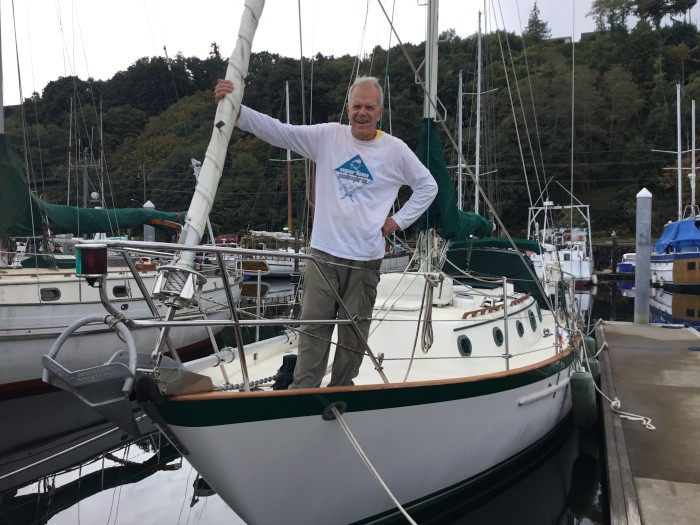
Back in the Saddle Again
“I`m back in the saddle again
Out where a friend is a friend
Where the longhorn cattle feed
On the lowly gypsum weed
Back in the saddle again
Ridin` the range once more
Totin` my old .44
Where you sleep out every night
And the only law is right
Back in the saddle again”
- Gene Autry
Gene Autry’s lyrics above capture my feelings, albeit the circumstances he describes do not fit exactly. Instead of back in the saddle, I am back on my sailboat, as the photo taken above of me today shows. Instead of longhorn cattle, I have the creatures of the sea. Instead of a .44 I have winches and a plethora of other sailboat hardware.
But there are similarities also. Just like for the cowboy on the wild range, we sailors a wild ocean value our friends. A friend is a friend both places, and we depend on our friends for survival.
So I am taking up where I left off, after a summer of unwelcome interruption. That interruption was not my desire, but rather was forced on me by my body’s sudden need for medical help. But after an operation, three hospital stays, many prescribed medications, a regimen of supervised cardio-rehabilitation exercise, and now attending my regular gym, I am ready. Ready to take up where I left off.
Where did I leave off? You may recall that after getting ill and going to the hospital in Victoria, I sailed S/V Ubiquity across the Strait of Juan de Fuca to Port Angeles, Washington. Ubiquity has waited for me in Port Angeles for over three months. But now I am recovered and re-joined her today.
After driving to Port Angeles today, I have lavished attention on Ubiquity to make up for the hiatus. She is now clean again, with sails once again hoisted. She is ready to depart tomorrow, September 16, with the destination of Astoria, Oregon, on the Columbia River. After that, I will bring her up-river to her old slip in Portland.
The weather forecasts suggest the trip out the Strait of Juan de Fuca will be calm, and mainly motoring. But coming down the Washington coast we should get some good sailing as the northwest winds increase. We expect to cross the Columbia River Bar and arrive in Astoria on Tuesday. Anyone wishing to follow our progress can do so here. You can probably follow us all the way in real-time using VesselFinder or MarineTraffic.
So I am back in the saddle again. It feels good.
“I`m back in the saddle again
Out where a friend is a friend
Where the longhorn cattle feed
On the lowly gypsum weed
Back in the saddle again
Ridin` the range once more
Totin` my old .44
Where you sleep out every night
And the only law is right
Back in the saddle again”
- Gene Autry
Gene Autry’s lyrics above capture my feelings, albeit the circumstances he describes do not fit exactly. Instead of back in the saddle, I am back on my sailboat, as the photo taken above of me today shows. Instead of longhorn cattle, I have the creatures of the sea. Instead of a .44 I have winches and a plethora of other sailboat hardware.
But there are similarities also. Just like for the cowboy on the wild range, we sailors a wild ocean value our friends. A friend is a friend both places, and we depend on our friends for survival.
So I am taking up where I left off, after a summer of unwelcome interruption. That interruption was not my desire, but rather was forced on me by my body’s sudden need for medical help. But after an operation, three hospital stays, many prescribed medications, a regimen of supervised cardio-rehabilitation exercise, and now attending my regular gym, I am ready. Ready to take up where I left off.
Where did I leave off? You may recall that after getting ill and going to the hospital in Victoria, I sailed S/V Ubiquity across the Strait of Juan de Fuca to Port Angeles, Washington. Ubiquity has waited for me in Port Angeles for over three months. But now I am recovered and re-joined her today.
After driving to Port Angeles today, I have lavished attention on Ubiquity to make up for the hiatus. She is now clean again, with sails once again hoisted. She is ready to depart tomorrow, September 16, with the destination of Astoria, Oregon, on the Columbia River. After that, I will bring her up-river to her old slip in Portland.
The weather forecasts suggest the trip out the Strait of Juan de Fuca will be calm, and mainly motoring. But coming down the Washington coast we should get some good sailing as the northwest winds increase. We expect to cross the Columbia River Bar and arrive in Astoria on Tuesday. Anyone wishing to follow our progress can do so here. You can probably follow us all the way in real-time using VesselFinder or MarineTraffic.
So I am back in the saddle again. It feels good.
Carpe Diem
12 June 2018 | Portland, Oregon

Yes, seize the day, enjoy the moment for we never know what comes next.
I try to practice Carpe Diem. I think I did on my trip to Mexico, and recently in Nanaimo and sailing with my friends Jill and Leslie from Nanaimo to Victoria.
On Thursday after arriving in Victoria I ran up the ramps for my daily aerobic workout (run up, walk down, for 20 minutes). But on Friday, when I climbed the mast of S/V Ubiquity, instead of climbing up 50' at once easily, I stopped repeatedly and panted. And then I could not walk up the ramps without stopping and panting, a day after I had been running up the ramps. Something was wrong.
After a night in a Victoria emergency room they discharged me stable enough and with enough meds to travel home for medical care. But first I sailed S/V Ubiquity across the Strait of Juan de Fuca and put her to bed in a slip at Port Angeles, Washington.
When I finally made it to Portland and saw the cardiologists I first got bad news, but followed by good news. I was in heart failure. A badly leaking value and an arrhythmia had lowered my ventricular output down to 25%. But they could repair the valve (better than replacing it). The cardiac arteries were clear (no bypasses needed) - see my pictures above! Believe me, the diagnosis of clear arteries was very welcome. And they could probably get rid of the arrhythmia also.
You could say I was lucky: My heart could have crashed 100 miles off the Baja coast instead of in Victoria. I could have crashed a year ago and not have experienced the joys I did in Mexico. So luck let me enjoy a great adventure.
And I am lucky to have a malady that current medicine can fix. And then I hope to enjoy some more time here on this world, some more adventures. By Fall I should be ready to sail S/V Ubiquity down the Washington coast to Portland. So my adventures on that boat are not yet over.
Carpe Diem is a daily philosophy, regardless of your condition. Yesterday I had friends over and enjoyed the moment. And I will continue to enjoy the moment and my friends until surgery next week. And I look forward then to working hard at a quick recovery, enjoying each step forward.
Carpe Diem!
I try to practice Carpe Diem. I think I did on my trip to Mexico, and recently in Nanaimo and sailing with my friends Jill and Leslie from Nanaimo to Victoria.
On Thursday after arriving in Victoria I ran up the ramps for my daily aerobic workout (run up, walk down, for 20 minutes). But on Friday, when I climbed the mast of S/V Ubiquity, instead of climbing up 50' at once easily, I stopped repeatedly and panted. And then I could not walk up the ramps without stopping and panting, a day after I had been running up the ramps. Something was wrong.
After a night in a Victoria emergency room they discharged me stable enough and with enough meds to travel home for medical care. But first I sailed S/V Ubiquity across the Strait of Juan de Fuca and put her to bed in a slip at Port Angeles, Washington.
When I finally made it to Portland and saw the cardiologists I first got bad news, but followed by good news. I was in heart failure. A badly leaking value and an arrhythmia had lowered my ventricular output down to 25%. But they could repair the valve (better than replacing it). The cardiac arteries were clear (no bypasses needed) - see my pictures above! Believe me, the diagnosis of clear arteries was very welcome. And they could probably get rid of the arrhythmia also.
You could say I was lucky: My heart could have crashed 100 miles off the Baja coast instead of in Victoria. I could have crashed a year ago and not have experienced the joys I did in Mexico. So luck let me enjoy a great adventure.
And I am lucky to have a malady that current medicine can fix. And then I hope to enjoy some more time here on this world, some more adventures. By Fall I should be ready to sail S/V Ubiquity down the Washington coast to Portland. So my adventures on that boat are not yet over.
Carpe Diem is a daily philosophy, regardless of your condition. Yesterday I had friends over and enjoyed the moment. And I will continue to enjoy the moment and my friends until surgery next week. And I look forward then to working hard at a quick recovery, enjoying each step forward.
Carpe Diem!
The Searchers
02 June 2018 | Victoria, Canada
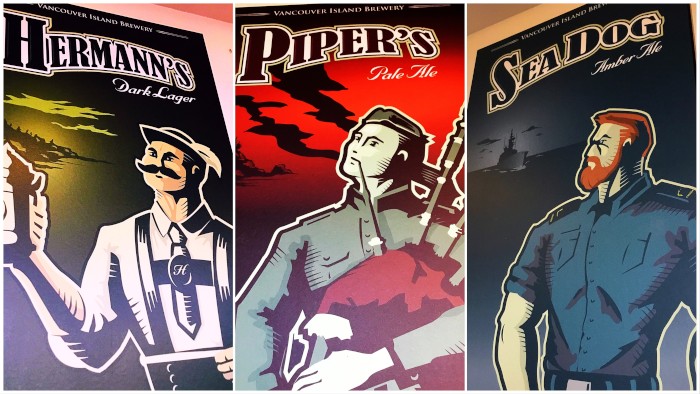
No. I am not referring to the epic western film titled "The Searchers". Rather, I refer to the captain and crew of S/V Ubiquity searching in Victoria for craft beer.
The craft brewing industry in Victoria is robust, but captain and crew searched in vain for craft beers they especially liked. Granted, Ubiquity's captain harbors beer predilections hard to satisfy - strong barrel-aged dark beers, classic true Scotch ales - and fits not well with today's dominant IPA crowd. The captain stopped at Swan's Brewery, where he has in the past so much enjoyed their authentic Scottish ale, but found this time the Scottish ale was not on tap and the old brewmaster who brewed it was gone. So the captain's search failed.
But the search was not fruitless. The captain enjoyed the people he met and his conversations with them, and seeing new parts of Victoria. It appears for him harder to find a beer than a person that he really likes.
The craft brewing industry in Victoria is robust, but captain and crew searched in vain for craft beers they especially liked. Granted, Ubiquity's captain harbors beer predilections hard to satisfy - strong barrel-aged dark beers, classic true Scotch ales - and fits not well with today's dominant IPA crowd. The captain stopped at Swan's Brewery, where he has in the past so much enjoyed their authentic Scottish ale, but found this time the Scottish ale was not on tap and the old brewmaster who brewed it was gone. So the captain's search failed.
But the search was not fruitless. The captain enjoyed the people he met and his conversations with them, and seeing new parts of Victoria. It appears for him harder to find a beer than a person that he really likes.
Vive la Différence!
30 May 2018 | Ganges, Saltspring Island, Canada

What a difference the cruising grounds make. Sailing the Sea of Cortez with its open vistas and grand desert islands was beautiful. But so is sailing the Pacific Northwest, with beautiful lush scenery and greenery.
Which of the two types of cruising do the above photos show? It's not hard to tell from how warmly my crew is dressed (on right), or the tree-covered islands (on left).
Yes, S/V Ubiquity is now back in the Pacific Northwest and is currently cruising in the Canadian Gulf Islands.
Vive la différence!
Which of the two types of cruising do the above photos show? It's not hard to tell from how warmly my crew is dressed (on right), or the tree-covered islands (on left).
Yes, S/V Ubiquity is now back in the Pacific Northwest and is currently cruising in the Canadian Gulf Islands.
Vive la différence!
S/V Ubiquity Splashes in Nanaimo, Canada
27 May 2018 | Nanaimo, Canada

Twelve days after loading S/V Ubiquity on a freighter in La Paz, Ubiquity splashed in Nanaimo, Canada. She was dirty, but without damage from the trip from Mexico to Canada.
The photo above shows on the left boats on the freighter docked in Nanaimo. On the right the photo shows Ubiquity suspended by a crane about to lower her into the water.
So the freighter transport option proved an easy way to disappear magically from Mexico, with daytime temperatures now about 95 degrees F and the hurricane season started, and magically to re-appear in Canada, with daytime temperatures now about 65 and the summer cruising season poised to begin.
To do this magic trick required no skill from the captain. Rather, it required only money, 10.5 "boat bucks" (The term "boat bucks" sailors use to refer to each $1,000 they spend on their boats).
If you want to see more photos of S/V Ubiquity and other boats on the freighter, more photos are available on-line.
The photo above shows on the left boats on the freighter docked in Nanaimo. On the right the photo shows Ubiquity suspended by a crane about to lower her into the water.
So the freighter transport option proved an easy way to disappear magically from Mexico, with daytime temperatures now about 95 degrees F and the hurricane season started, and magically to re-appear in Canada, with daytime temperatures now about 65 and the summer cruising season poised to begin.
To do this magic trick required no skill from the captain. Rather, it required only money, 10.5 "boat bucks" (The term "boat bucks" sailors use to refer to each $1,000 they spend on their boats).
If you want to see more photos of S/V Ubiquity and other boats on the freighter, more photos are available on-line.
The Future after the 2016-2018 Sailboat Cruise From Portland to Mexico
20 May 2018 | Portland, Oregon

My 2016-2018 cruise to Mexico was for me a rich adventure - for the sailing, the experience, and the people. I tried to convey that richness in my blog posts.
So what is next?
S/V Ubiquity will off-load shortly on Vancouver Island in the heart of the Pacific Northwest cruising grounds, and at the beginning of the cruising season. So of course I am going to cruise the Pacific Northwest this summer. Since I will also spend some time in Portland, my home, I intend to get a boat slip in Port Angeles, Washington, a small working port and town that I enjoy.
In late Fall I will sail S/V Ubiquity south to spend the winter season at the dock in Portland.
And after that?
For Summer 2019 I think my sailing will probably be in the Pacific Northwest. I think I would like to do another circumnavigation of Vancouver Island, and explore some of the sounds on the west side which I have not visited.
Is another sailing cruise down the west coast to Mexico possible? If my health stays good I think I could still do it. Back in Portland I will be going to my gym regularly to keep in shape. So I could see sailing south again in maybe 2020.
My 2016-2018 trip was rewarding enough so that I would enjoy repeating it, but with some changes. First, I would not leave late in the Fall again and get caught in the winter weather. Getting caught that way in 2016 required waiting out winter gales, and even hurricane force winds. Then to get around Cape Blanco and Cape Mendocino I had to sail against the winter southerly weather, beating my way around the capes. Finally I got south enough that the winds turned northerly. In contrast, leaving in the summer you can expect better weather and consistent northerly winds.
If I sail down the coast again, there are some places I went that I would definitely repeat: Newport, Oregon (love the Rogue Brewery), Coho Anchorage (an historic anchorage, just south of Point Conception), Santa Barbara (so much to do, great wine tasting and restaurants), the Channel Islands, Marina Coral in Ensenada (a great place to check into Mexico, with such friendly staff who helped me so much when I had customs problems), and many places in the Sea of Cortez, such a fantastic cruising ground.
And there are places I would like to visit that I did not visit on my 2016-2018 trip: Noyo, a small fishing village near Fort Bragg (the seas were running too big for me to enter the harbor), Drakes Bay anchorage (another historic anchorage just north of San Francisco, San Simeon anchorage (a beautiful anchorage by Hearst Castle), Guadalupe Island (200 miles southwest of Ensenda, and very remote), Socorro Island (250 miles south of Cabo San Lucas, and very remote), and after Socorro I would probably sail to mainland Mexico, the "Gold Coast", which I did not visit in 2016-2018).
The photos above show, left to right:
Coho Anchorage
Noyo Fishing Village
Guadalupe Island
So what is next?
S/V Ubiquity will off-load shortly on Vancouver Island in the heart of the Pacific Northwest cruising grounds, and at the beginning of the cruising season. So of course I am going to cruise the Pacific Northwest this summer. Since I will also spend some time in Portland, my home, I intend to get a boat slip in Port Angeles, Washington, a small working port and town that I enjoy.
In late Fall I will sail S/V Ubiquity south to spend the winter season at the dock in Portland.
And after that?
For Summer 2019 I think my sailing will probably be in the Pacific Northwest. I think I would like to do another circumnavigation of Vancouver Island, and explore some of the sounds on the west side which I have not visited.
Is another sailing cruise down the west coast to Mexico possible? If my health stays good I think I could still do it. Back in Portland I will be going to my gym regularly to keep in shape. So I could see sailing south again in maybe 2020.
My 2016-2018 trip was rewarding enough so that I would enjoy repeating it, but with some changes. First, I would not leave late in the Fall again and get caught in the winter weather. Getting caught that way in 2016 required waiting out winter gales, and even hurricane force winds. Then to get around Cape Blanco and Cape Mendocino I had to sail against the winter southerly weather, beating my way around the capes. Finally I got south enough that the winds turned northerly. In contrast, leaving in the summer you can expect better weather and consistent northerly winds.
If I sail down the coast again, there are some places I went that I would definitely repeat: Newport, Oregon (love the Rogue Brewery), Coho Anchorage (an historic anchorage, just south of Point Conception), Santa Barbara (so much to do, great wine tasting and restaurants), the Channel Islands, Marina Coral in Ensenada (a great place to check into Mexico, with such friendly staff who helped me so much when I had customs problems), and many places in the Sea of Cortez, such a fantastic cruising ground.
And there are places I would like to visit that I did not visit on my 2016-2018 trip: Noyo, a small fishing village near Fort Bragg (the seas were running too big for me to enter the harbor), Drakes Bay anchorage (another historic anchorage just north of San Francisco, San Simeon anchorage (a beautiful anchorage by Hearst Castle), Guadalupe Island (200 miles southwest of Ensenda, and very remote), Socorro Island (250 miles south of Cabo San Lucas, and very remote), and after Socorro I would probably sail to mainland Mexico, the "Gold Coast", which I did not visit in 2016-2018).
The photos above show, left to right:
Coho Anchorage
Noyo Fishing Village
Guadalupe Island
Postmortem, 2016-2018 Sailboat Cruise From Portland to Mexico: The Family of Man and Lost Boundaries
20 May 2018 | Portland, Oregon

I made an earlier blog post, based on the “Family of Man”, when the staff at Marina Coral in Ensenada came to my aid at a time of need.
I grew up with the book, "The Family of Man", first published in 1955 as a photo essay with an accompanying poetic commentary by Carl Sandburg. The photos and poetry portray the commonality of the human experience across cultures, a humanistic perspective I share today.
I also grew up close to a family the father of which was the principle subject in the movie and book, "Lost Boundaries". That book and movie tell the story of someone growing up prejudiced against another race, but then confronting the realization that he was a member of that other race. What an incredible story that shows the foolishness of imposing racial and other boundaries that divide the Family of Man.
As a retired college professor today, I sometimes wander the world on my sailboat, enjoying the world and its people. What I see reinforces the humanistic concept in the the Family of Man. The commonality of the human experience is there to see.
Our human evolutionary heritage results in dark sides within us, also depicted in the Family of Man: prejudice, hatred, violence, war. Some people focus on that side of human experience to build walls between us. Humans build boundaries easily, and the absurdity of those boundaries seldom becomes as obvious as in Lost Boundaries.
But traveling the world, whether by sailboat or other ways, it is easy to see past those boundaries into the commonality of human experience. Travel, with eyes open, and you will see it.
I grew up with the book, "The Family of Man", first published in 1955 as a photo essay with an accompanying poetic commentary by Carl Sandburg. The photos and poetry portray the commonality of the human experience across cultures, a humanistic perspective I share today.
I also grew up close to a family the father of which was the principle subject in the movie and book, "Lost Boundaries". That book and movie tell the story of someone growing up prejudiced against another race, but then confronting the realization that he was a member of that other race. What an incredible story that shows the foolishness of imposing racial and other boundaries that divide the Family of Man.
As a retired college professor today, I sometimes wander the world on my sailboat, enjoying the world and its people. What I see reinforces the humanistic concept in the the Family of Man. The commonality of the human experience is there to see.
Our human evolutionary heritage results in dark sides within us, also depicted in the Family of Man: prejudice, hatred, violence, war. Some people focus on that side of human experience to build walls between us. Humans build boundaries easily, and the absurdity of those boundaries seldom becomes as obvious as in Lost Boundaries.
But traveling the world, whether by sailboat or other ways, it is easy to see past those boundaries into the commonality of human experience. Travel, with eyes open, and you will see it.
Postmortem, 2016-2018 Sailboat Cruise From Portland to Mexico: The Human Spirit
18 May 2018 | Portland, Oregon
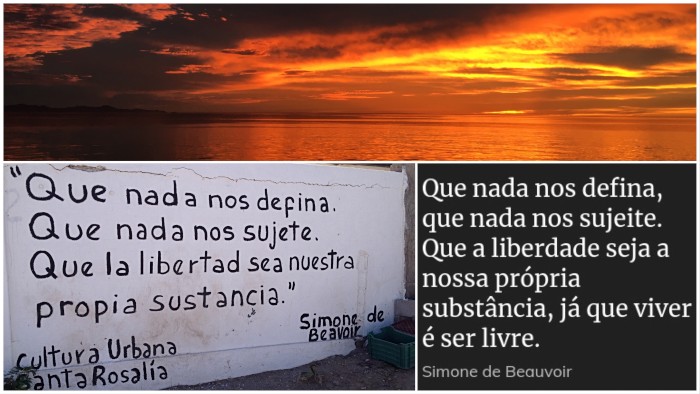
A trip like this can teach you about human nature and the human spirit.
Certainly you can learn about yourself, about how you make mistakes, how you deal with adversity. Sometimes the result is not pretty, such as my injury in rough conditions off Cape Blanco.
In a small way, the choices and the self-revelations you face when cruising mirror the challenges of living.
But when you look around, beyond yourself and the boat, you will probably see more profound evidence of human nature and the human spirit.
I saw that in Santa Rosalia. Santa Rosalia is a small town, a traditional Mexican town. Some tourists like me go there, but not many.
So walking through the residential streets of Santa Rosalia who would expect to see a big sign like the one above, a sign with a quotation from Simon de Beauvoir, a French writer and feminist.*
That surprised me. A mural in the small Mexican town of Santa Rosalia quotes a French feminist writer.
And what did the Santa Rosalia mural painter quote from Beauvoir? The quote is about eschewing subjugation and embracing freedom and self-actualization. It is about the human spirit.
So the human spirit lives in sleepy Santa Rosalia, Mexico. It's there because the human spirit lives everywhere.
And not just today. Also in Santa Rosalia, along the waterfront, near the Mexican Navy facilities, is a plague memorializing the Mexican cadets at the Battle of Veracruz in the 1914 Mexican-American war. Those young Mexican cadets fought and died, against superior force, for their ideals. For the human spirit.
A German song, "The Gedanken Sind Frei", attests eloquently to the human spirit. The song extols freedom of thought. The anti-Nazi resistence movements in Nazi Germany adopted the song, and those freedom fighters, including those in the Weisse Rose group, died for their beliefs.
But those people are not alone. People have died in so many other places standing up for the human spirit - at Veracruz in 1914, in Hungary in 1956, at Tiananmen Square in 1989, and countless more.
And in small, sleepy, Santa Rosalia, the mural I saw attests to the same universal human yearning for freedom and self-actualization. That mural connects people in Santa Rosalia to people throughout the world. It connects people through the human spirit, a spirit ubiquitous and unconquerable.
=====
*PS There are 2 errors in the Beauvoir texts in the photos. On the left Beauvoir's name is mis-spelled. On the right the last word should be "libre", not "livre."
Certainly you can learn about yourself, about how you make mistakes, how you deal with adversity. Sometimes the result is not pretty, such as my injury in rough conditions off Cape Blanco.
In a small way, the choices and the self-revelations you face when cruising mirror the challenges of living.
But when you look around, beyond yourself and the boat, you will probably see more profound evidence of human nature and the human spirit.
I saw that in Santa Rosalia. Santa Rosalia is a small town, a traditional Mexican town. Some tourists like me go there, but not many.
So walking through the residential streets of Santa Rosalia who would expect to see a big sign like the one above, a sign with a quotation from Simon de Beauvoir, a French writer and feminist.*
That surprised me. A mural in the small Mexican town of Santa Rosalia quotes a French feminist writer.
And what did the Santa Rosalia mural painter quote from Beauvoir? The quote is about eschewing subjugation and embracing freedom and self-actualization. It is about the human spirit.
So the human spirit lives in sleepy Santa Rosalia, Mexico. It's there because the human spirit lives everywhere.
And not just today. Also in Santa Rosalia, along the waterfront, near the Mexican Navy facilities, is a plague memorializing the Mexican cadets at the Battle of Veracruz in the 1914 Mexican-American war. Those young Mexican cadets fought and died, against superior force, for their ideals. For the human spirit.
A German song, "The Gedanken Sind Frei", attests eloquently to the human spirit. The song extols freedom of thought. The anti-Nazi resistence movements in Nazi Germany adopted the song, and those freedom fighters, including those in the Weisse Rose group, died for their beliefs.
But those people are not alone. People have died in so many other places standing up for the human spirit - at Veracruz in 1914, in Hungary in 1956, at Tiananmen Square in 1989, and countless more.
And in small, sleepy, Santa Rosalia, the mural I saw attests to the same universal human yearning for freedom and self-actualization. That mural connects people in Santa Rosalia to people throughout the world. It connects people through the human spirit, a spirit ubiquitous and unconquerable.
=====
*PS There are 2 errors in the Beauvoir texts in the photos. On the left Beauvoir's name is mis-spelled. On the right the last word should be "libre", not "livre."
Postmortem, 2016-2018 Sailboat Cruise From Portland to Mexico: The Adventure, Challenge, and Punishment of the Seas
17 May 2018 | Portland, Oregon

The adventure gives another reason to do such a cruise, but recognizing the possible challenges.
The photo above left shows a squall at sunset off of the Northern California coast. Luckily that squall missed S/V Ubiquity. The middle photo shows large following sea rushing past S/V Ubiquity as she runs in 30 knot winds south of Cape Mendocino. The right photo shows Cape Falso punishing S/V Ubiquity and her captain and crew.
Providing the boat, captain, and crew can handle the challenge and punishment, the adventure provides great reward.
The photo above left shows a squall at sunset off of the Northern California coast. Luckily that squall missed S/V Ubiquity. The middle photo shows large following sea rushing past S/V Ubiquity as she runs in 30 knot winds south of Cape Mendocino. The right photo shows Cape Falso punishing S/V Ubiquity and her captain and crew.
Providing the boat, captain, and crew can handle the challenge and punishment, the adventure provides great reward.
Postmortem, 2016-2018 Sailboat Cruise From Portland to Mexico: The Beauty
17 May 2018 | Portland, Oregon

The beauty is certainly one reason to do such a cruise.
The beauty comes in many ways: the beauty of the anchorages, the beauty of the wildlife, the beauty of the vistas sailing in the Sea of Cortez, the beauty of vastness of the seas, and more.
The beauty comes in many ways: the beauty of the anchorages, the beauty of the wildlife, the beauty of the vistas sailing in the Sea of Cortez, the beauty of vastness of the seas, and more.
Postmortem, 2016-2018 Sailboat Cruise From Portland to Mexico: People I Met, New Friends
17 May 2018 | Portland, Oregon
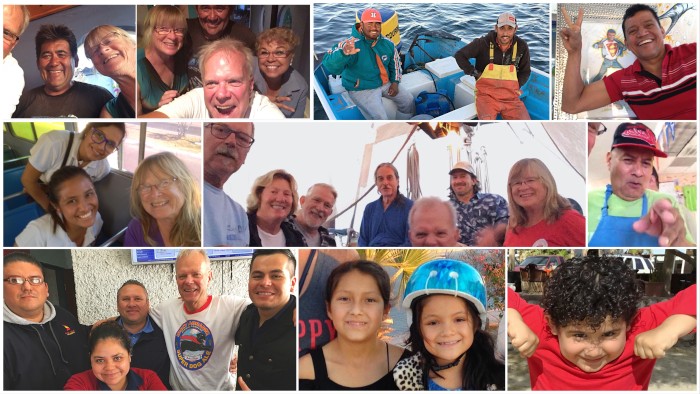
I've heard other cruisers characterize cruising as all about the people you meet. I feel the same.
Cruising down the west coast and in the Sea of Cortez I met so many different people who I enjoyed. The collage above shows some of the friends I met, but I could not post here a collage photo that would show them all. It would be too big. I made so many friends, and met so many people I liked.
Friends I met cruising include lots of people cruising like me, mainly from the U.S. and Canada. You already have a connection because you are doing the same thing, and have gone through similar experiences. You meet new friends at an anchorage or in port, and then you will likely see them again, perhaps somewhere far away. Some you will keep in contact with via email. Some, like my friend Laurin, might even visit you at home in the summer.
I also really enjoyed making friends with local people, especially in the Sea of Cortez. My Spanish language facility is still rudimentary, but that did not stop me from making friends. I found it easy to connect and to joke with the Mexican people. My jokes in Spanish were stupid (¿Cuántas esposas tiene, señor?), but they almost always got a laugh. In some of my prior blog posts I tried to convey the positive experiences I had getting to know, and making friends, with some of the Mexican people.
So thank you my new friends - my friends who are fellow cruisers, and my friends from Mexico - for adding so much to my cruise to Mexico.
Cruising down the west coast and in the Sea of Cortez I met so many different people who I enjoyed. The collage above shows some of the friends I met, but I could not post here a collage photo that would show them all. It would be too big. I made so many friends, and met so many people I liked.
Friends I met cruising include lots of people cruising like me, mainly from the U.S. and Canada. You already have a connection because you are doing the same thing, and have gone through similar experiences. You meet new friends at an anchorage or in port, and then you will likely see them again, perhaps somewhere far away. Some you will keep in contact with via email. Some, like my friend Laurin, might even visit you at home in the summer.
I also really enjoyed making friends with local people, especially in the Sea of Cortez. My Spanish language facility is still rudimentary, but that did not stop me from making friends. I found it easy to connect and to joke with the Mexican people. My jokes in Spanish were stupid (¿Cuántas esposas tiene, señor?), but they almost always got a laugh. In some of my prior blog posts I tried to convey the positive experiences I had getting to know, and making friends, with some of the Mexican people.
So thank you my new friends - my friends who are fellow cruisers, and my friends from Mexico - for adding so much to my cruise to Mexico.
Postmortem, 2016-2018 Sailboat Cruise From Portland to Mexico: Friends who Helped
17 May 2018 | Portland, Oregon

"No Man is an Island" - John Donne, English metaphysical poet, 1624
Romanticism tempts us to imagine the captain of a sailboat as a stalwart loner, completely self-sufficient, imperturbable. That probably never fits reality because we all depend on others in different ways. Two of my friends I want to especially acknowledge for their help to me.
Dave Mancini (above right, with his wife Rhonda), is an accomplished sailing friend who was always there to encourage me when trying to sail south in late Fall 2016, against the early-arrival winter weather. His texts (to my satellite messenger) and phone calls (when we had cell service) encouraged me and my crew at critical times. He conveyed to us weather updates, and he felt to me and my crew like our guardian angel. Thanks, Dave!
Sandy Edmonson (above left, front left in photo, with her husband Chris on the right side) was a friend I knew from sailing, and from US Power Squadron classes, in Portland. She sailed her boat to Mexico before me and gave me the benefit of lots of advice from her cruising in the Sea of Cortez. When I had a question (for example, about hauling the boat out for the summer in San Carlos) I just emailed her. She always replied right away with a long email with lots of good information. She never tired of my questions and was always patient, even when I asked the same question twice. Thanks, Sandy!
Other friends helped too, both Portland friends and friends we made on the way. Thanks, Tammy for the great fender covers you sewed for S/V Ubiquity. Thanks Rich (La Paz Cruisers Supply) for helping set up the yacht transport from La Paz to Victoria. Thanks to everyone else I met on the voyage who helped with their conversation, advice, and friendship.
Romanticism tempts us to imagine the captain of a sailboat as a stalwart loner, completely self-sufficient, imperturbable. That probably never fits reality because we all depend on others in different ways. Two of my friends I want to especially acknowledge for their help to me.
Dave Mancini (above right, with his wife Rhonda), is an accomplished sailing friend who was always there to encourage me when trying to sail south in late Fall 2016, against the early-arrival winter weather. His texts (to my satellite messenger) and phone calls (when we had cell service) encouraged me and my crew at critical times. He conveyed to us weather updates, and he felt to me and my crew like our guardian angel. Thanks, Dave!
Sandy Edmonson (above left, front left in photo, with her husband Chris on the right side) was a friend I knew from sailing, and from US Power Squadron classes, in Portland. She sailed her boat to Mexico before me and gave me the benefit of lots of advice from her cruising in the Sea of Cortez. When I had a question (for example, about hauling the boat out for the summer in San Carlos) I just emailed her. She always replied right away with a long email with lots of good information. She never tired of my questions and was always patient, even when I asked the same question twice. Thanks, Sandy!
Other friends helped too, both Portland friends and friends we made on the way. Thanks, Tammy for the great fender covers you sewed for S/V Ubiquity. Thanks Rich (La Paz Cruisers Supply) for helping set up the yacht transport from La Paz to Victoria. Thanks to everyone else I met on the voyage who helped with their conversation, advice, and friendship.
Postmortem, 2016-2018 Sailboat Cruise From Portland to Mexico: Captain and Crew
17 May 2018 | Portland, Oregon

Making a significant offshore cruise puts demands on the boat, captain, and crew. Like the boat, the captain and crew must meet those demands.
Older age does not preclude success. Ubiquity's captain is now 70, and the crew is 71. Together they showed the capacity to handle the boat in a range of adverse conditions.
As we get older, our capacity to handle the boat in adverse conditions becomes less. Ubiquity's regular crew member, for example, has limited agility because of multiple past orthopedic injuries. But the captain still has the physical capability to do the hard jobs, like going forward to reef the mainsail in rough conditions. So as long as someone can do the difficult jobs, you can successfully sail the boat.
One example of adverse conditions happened at night about 2:00 a.m. when sailing from San Carlos to Isla Tiburon. Unexpectedly the wind increased into the high 20's, and there was no reef in the mainsail. The captain woke up the sleeping crew and had the crew take the helm as the captain went forward to put in a reef, headlamp on, spray and water coming over the boat, the boat pitching and rolling.
Another example was handling a squall with winds in the mid-30's after leaving Coos Bay. The mainsail had one reef in already, and when the captain spotted the approaching squall he worked hard to put in the second reef, sometimes swinging from the boom as the boat rolled.
Having more crew, and younger crew, could add to the capacity to handle the boat and perhaps increase safety.
But the experience of S/V Ubiquity on this cruise shows that two people in their 70's can handle the boat in a range of sometimes adverse conditions.
Older age does not preclude success. Ubiquity's captain is now 70, and the crew is 71. Together they showed the capacity to handle the boat in a range of adverse conditions.
As we get older, our capacity to handle the boat in adverse conditions becomes less. Ubiquity's regular crew member, for example, has limited agility because of multiple past orthopedic injuries. But the captain still has the physical capability to do the hard jobs, like going forward to reef the mainsail in rough conditions. So as long as someone can do the difficult jobs, you can successfully sail the boat.
One example of adverse conditions happened at night about 2:00 a.m. when sailing from San Carlos to Isla Tiburon. Unexpectedly the wind increased into the high 20's, and there was no reef in the mainsail. The captain woke up the sleeping crew and had the crew take the helm as the captain went forward to put in a reef, headlamp on, spray and water coming over the boat, the boat pitching and rolling.
Another example was handling a squall with winds in the mid-30's after leaving Coos Bay. The mainsail had one reef in already, and when the captain spotted the approaching squall he worked hard to put in the second reef, sometimes swinging from the boom as the boat rolled.
Having more crew, and younger crew, could add to the capacity to handle the boat and perhaps increase safety.
But the experience of S/V Ubiquity on this cruise shows that two people in their 70's can handle the boat in a range of sometimes adverse conditions.
Postmortem, 2016-2018 Sailboat Cruise From Portland to Mexico: Equipment
15 May 2018 | Portland, Oregon
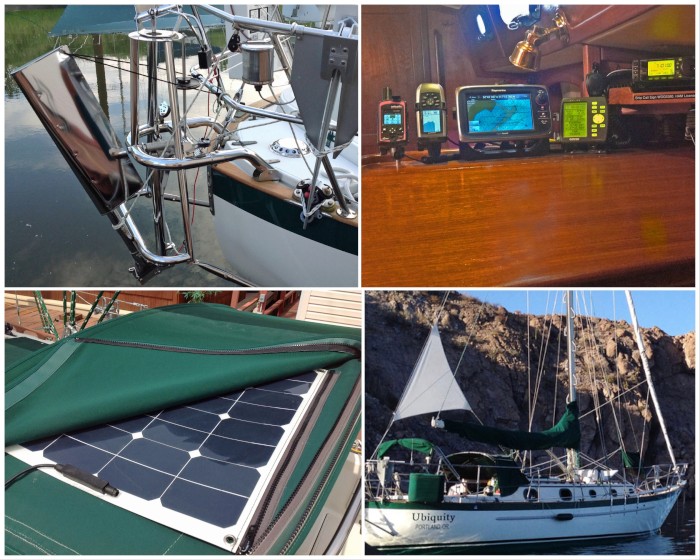
The first postmortem post, this post, focuses on equipment and will interest mainly sailors.
I prepared carefully over several years for this cruise, and the careful preparation paid off. The boat and the equipment generally performed well and as I expected.
For more specifics than I provide here about the equipment on my boat, see my Pacific Seacraft 34 web site.
The Pacific Seacraft 34 design proved seaworthy and versatile. Although most cruisers today choose bigger cruising boats, she served me well. On my Pacific Seacraft 34 web site you can see videos of the boat sailing in different conditions and configurations.
Mainsail and Jib: I found the heavily-made 110 jib quite versatile. In strong conditions her foam luff helped her perform well when reefed way down. The heavily-made mainsail, with a hollow leach and without roach, I found similarly versatile. In heavy weather reefed down the mainsail was very solid and the boat hove to well on the main alone. In light air I coaxed more performance from the main by easing the outhaul and the luff tension, giving the sail more draft.
Staysail: In strong conditions I found running with the staysail alone provided the most stable ride, and when sailing to weather in strong conditions the staysail with a reefed main could punch through rough seas and keep the boat moving.
Fuel: I rejected stowing multiple five gallon diesel containers on the side deck, as almost all cruisers do who sail to Mexico. My experience vindicated my choice. I did carry one five gallon container under the helmsman's seat, but I never needed even that. Sailing from Ensenada down the Baja, then north into the Sea of Cortez to La Paz, I used only half of my 30 gallon fuel tank, and I could have used less. So you can cruise to Mexico without carrying lots of extra fuel, if you prefer.
Anchoring: The 20 kg Rocna anchor with 5/16 high test chain never dragged - ever, in all of my cruising in Mexico and the Pacific NW. Although I sometimes sail onto the anchor, I always start the engine to back down and test the anchor. In windy conditions I use a riding sail, and I never saw another cruiser in Mexico using a riding sail. I find that the riding sail quiets the boat greatly in windy conditions at anchor.
Electronics: The satellite messenger (an inReach Explorer) that I added to my nav station gave me, for a modest cost, texting, weather forecasting, and on-line tracking capabilities. AIS (a receiver in the VHF radio and a separate transceiver) worked great and insured I always knew about the big ships. I used my HF ham radio (now an old technology) to download weather information (forecasts and grib files). I often listened to the HF nets, especially the Sonrisa Net, and a number of times I asked the Sonrisa weather expert, Geary, specific weather questions about where I was cruising and he replied personally to those questions.
No Refrigeration: Almost all cruisers would think me crazy for removing the refrigeration on my boat. Amazingly, I always had ice, so the happy hour margaritas never lacked ice. Even in the Sea of Cortez, in warm weather, the block ice plus crushed ice always lasted for the several weeks between ports. And without refrigeration, it was easy to meet the electrical needs.
Solar Panels: Two flexible 50W solar panels almost always satisfied my electrical needs, even when I sailed on and off the anchor and used the autopilot.
Self-Steering: On longer passages the Monitor wind vane handled the steering well. When conditions were rough the Monitor was especially important, because in rougher conditions the vane has the necessary power and uses no electricity. When sailing for shorter periods in lighter conditions, and when motoring, the below deck hydraulic autopilot performed well.
Because I keep my boat fairly simple and well-maintained, I had no noteworthy equipment failures. Mainly I just did maintenance and fixed minor problems.
I prepared carefully over several years for this cruise, and the careful preparation paid off. The boat and the equipment generally performed well and as I expected.
For more specifics than I provide here about the equipment on my boat, see my Pacific Seacraft 34 web site.
The Pacific Seacraft 34 design proved seaworthy and versatile. Although most cruisers today choose bigger cruising boats, she served me well. On my Pacific Seacraft 34 web site you can see videos of the boat sailing in different conditions and configurations.
Mainsail and Jib: I found the heavily-made 110 jib quite versatile. In strong conditions her foam luff helped her perform well when reefed way down. The heavily-made mainsail, with a hollow leach and without roach, I found similarly versatile. In heavy weather reefed down the mainsail was very solid and the boat hove to well on the main alone. In light air I coaxed more performance from the main by easing the outhaul and the luff tension, giving the sail more draft.
Staysail: In strong conditions I found running with the staysail alone provided the most stable ride, and when sailing to weather in strong conditions the staysail with a reefed main could punch through rough seas and keep the boat moving.
Fuel: I rejected stowing multiple five gallon diesel containers on the side deck, as almost all cruisers do who sail to Mexico. My experience vindicated my choice. I did carry one five gallon container under the helmsman's seat, but I never needed even that. Sailing from Ensenada down the Baja, then north into the Sea of Cortez to La Paz, I used only half of my 30 gallon fuel tank, and I could have used less. So you can cruise to Mexico without carrying lots of extra fuel, if you prefer.
Anchoring: The 20 kg Rocna anchor with 5/16 high test chain never dragged - ever, in all of my cruising in Mexico and the Pacific NW. Although I sometimes sail onto the anchor, I always start the engine to back down and test the anchor. In windy conditions I use a riding sail, and I never saw another cruiser in Mexico using a riding sail. I find that the riding sail quiets the boat greatly in windy conditions at anchor.
Electronics: The satellite messenger (an inReach Explorer) that I added to my nav station gave me, for a modest cost, texting, weather forecasting, and on-line tracking capabilities. AIS (a receiver in the VHF radio and a separate transceiver) worked great and insured I always knew about the big ships. I used my HF ham radio (now an old technology) to download weather information (forecasts and grib files). I often listened to the HF nets, especially the Sonrisa Net, and a number of times I asked the Sonrisa weather expert, Geary, specific weather questions about where I was cruising and he replied personally to those questions.
No Refrigeration: Almost all cruisers would think me crazy for removing the refrigeration on my boat. Amazingly, I always had ice, so the happy hour margaritas never lacked ice. Even in the Sea of Cortez, in warm weather, the block ice plus crushed ice always lasted for the several weeks between ports. And without refrigeration, it was easy to meet the electrical needs.
Solar Panels: Two flexible 50W solar panels almost always satisfied my electrical needs, even when I sailed on and off the anchor and used the autopilot.
Self-Steering: On longer passages the Monitor wind vane handled the steering well. When conditions were rough the Monitor was especially important, because in rougher conditions the vane has the necessary power and uses no electricity. When sailing for shorter periods in lighter conditions, and when motoring, the below deck hydraulic autopilot performed well.
Because I keep my boat fairly simple and well-maintained, I had no noteworthy equipment failures. Mainly I just did maintenance and fixed minor problems.
Postmortem Blog Posts, 2016-2018 Sailboat Cruise From Portland to Mexico
15 May 2018 | Portland, Oregon
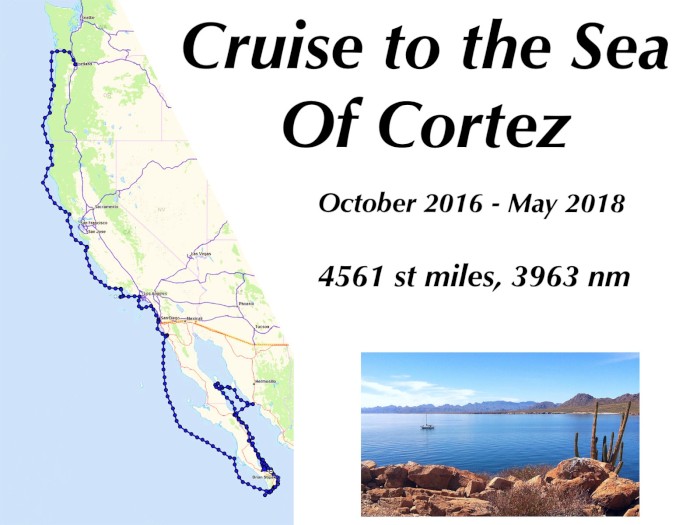
In late Fall 2016 I pointed S/V Ubiquity south after crossing the Columbia River Bar, beginning the 2016-2018 cruise to Mexico. That cruise ended when I loaded S/V Ubiquity onto a freighter steaming for Victoria, Canada.
Photos and videos from the trip you can find here.
It is time to reflect on the 2016-2018 cruise to Mexico. I will reflect on various topics in several upcoming “postmortem” blog posts.
Photos and videos from the trip you can find here.
It is time to reflect on the 2016-2018 cruise to Mexico. I will reflect on various topics in several upcoming “postmortem” blog posts.
Loading my Sailboat on a Freighter: The Easy Way for Gentlemen to Sail to Windward
15 May 2018 | Portland, Oregon
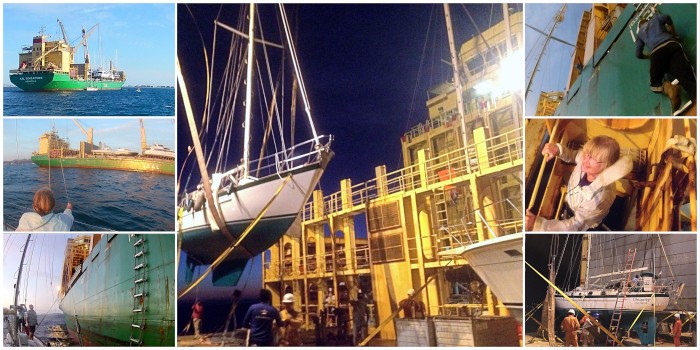
An earlier blog post explained that although “Gentlemen Don’t Sail to Windward”, S/V Ubiquity has sailed much to windward and her captain is not a gentleman. Then a more recent blog post, “Change of Plans After an Epiphany”, explained how I decided to ship S/V Ubiquity north on a freighter instead of sailing to windward up the west coast.
So S/V Ubiquity will go to windward up the west coast at 13-15 knots, and with no wear and tear on the boat or on her captain and crew. Plus we unload the boat in Victoria in May, ready to enjoy the beautiful summer sailing in the Pacific Northwest.
The photos above show Ubiquity loading on the freighter AAL Singapore two days ago at La Paz. Although the experience caused Ubiquity’s captain some anxiety, we successfully loaded Ubiquity with no damage. She now is making 13 knots to weather off of Bahia Santa Marina, which she visited with captain and crew in March 2017.
More photos of Ubiquity’s loading and our last days in La Paz are available on-line.
So S/V Ubiquity will go to windward up the west coast at 13-15 knots, and with no wear and tear on the boat or on her captain and crew. Plus we unload the boat in Victoria in May, ready to enjoy the beautiful summer sailing in the Pacific Northwest.
The photos above show Ubiquity loading on the freighter AAL Singapore two days ago at La Paz. Although the experience caused Ubiquity’s captain some anxiety, we successfully loaded Ubiquity with no damage. She now is making 13 knots to weather off of Bahia Santa Marina, which she visited with captain and crew in March 2017.
More photos of Ubiquity’s loading and our last days in La Paz are available on-line.
One Last Night at El Molinito Restaurante
11 May 2018 | La Paz, Baja, Mexico
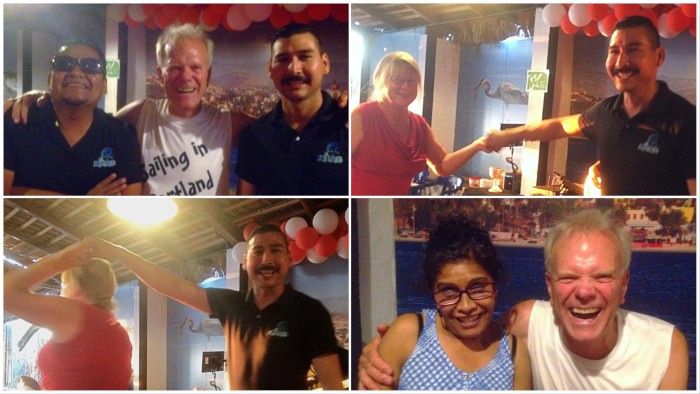
Yesterday was El Dia de la Madre, Mother’s Day, in Mexico. So El Molinito was especially busy, and they even had the band playing live music.
It was therefore a good night to say goodbye to El Molinito.
Jesus, our usual waiter at El Molinito, always encourages me and my friend Leslie to dance when we come. But this time I prevailed on him to take a few dance steps himself (See photos above).
It was therefore a good night to say goodbye to El Molinito.
Jesus, our usual waiter at El Molinito, always encourages me and my friend Leslie to dance when we come. But this time I prevailed on him to take a few dance steps himself (See photos above).
My Crazy Friends who Work at Marina Palmira
10 May 2018 | La Paz, Baja, Mexico

Above I am with two friends who work at Marina Palmira, Arturo and Salvador. They like to call me crazy (loco), but I think they are crazy too - look at Arturo on the left.
Tonight I am meeting my friend Hugo, who also works at Marina Palmira, at El Molinito for drinks and dinner.
It’s time to start saying goodbye (again), since we are scheduled to load S/V Ubiquity on a freighter on Saturday for transport to Victoria.
Friends here are easy to make, and I appreciate them, whether they are loco or not.
Tonight I am meeting my friend Hugo, who also works at Marina Palmira, at El Molinito for drinks and dinner.
It’s time to start saying goodbye (again), since we are scheduled to load S/V Ubiquity on a freighter on Saturday for transport to Victoria.
Friends here are easy to make, and I appreciate them, whether they are loco or not.
Hot in La Paz - No Problem!
10 May 2018 | La Paz, Baja, Mexico
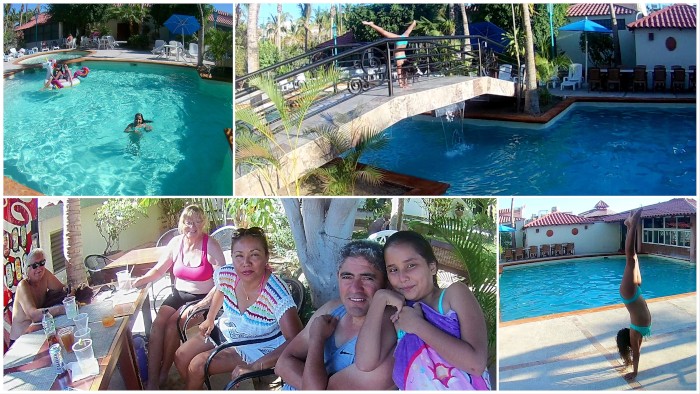
It was a hot day in La Paz yesterday, so that made it perfect for spending the afternoon at the pool.
Abigail (10 years old) spent hours in the pool and showed her dexterity doing hand stands and cartwheels.
The adults did not spend as much time in the pool as Abigail, but we did swim, and had fun tossing the frisbee and the beach ball in the pool. For me it was good to practice swim strokes again after years of not swimming much.
Abigail (10 years old) spent hours in the pool and showed her dexterity doing hand stands and cartwheels.
The adults did not spend as much time in the pool as Abigail, but we did swim, and had fun tossing the frisbee and the beach ball in the pool. For me it was good to practice swim strokes again after years of not swimming much.
A Peek into Family Life in Mexico
09 May 2018 | La Paz, Baja, Mexico
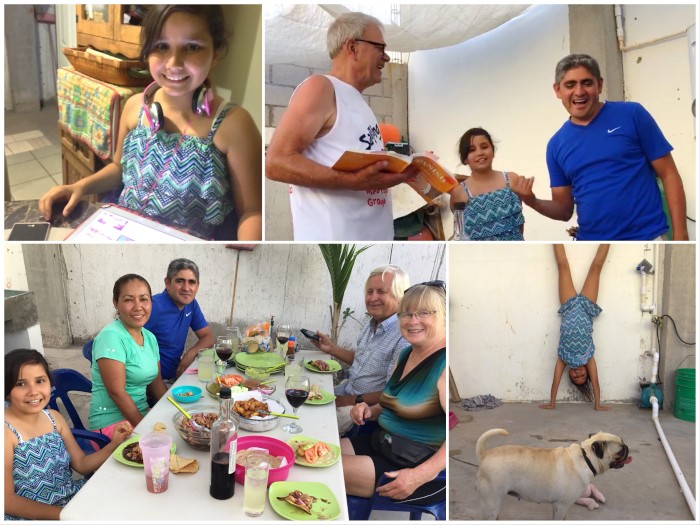
As my cruising friend Laurin commented, it's not too often when traveling abroad that local people you meet invite you to their home. But last night I and my sailing friends Laurin and Leslie shared the evening with Julio and Abigail's family, and you can share it also.
Above you see some photos from last night. Julio is the father, Abigail the mother, and Abigail (yes, same name), the ten-year-old daughter. Plus there is Mia the doggie.
Food, drink, and camaraderie were bountiful. Abigail (daughter) loves her doggie and her electronic devices, just like kids in the States, and demonstrates her youthful agility with her handstands (lower right).
Since we Americans came with limited Spanish ability, I brought some Spanish exercises for levity and for language practice. First, I asked silly questions I had written out on index cards, such as "¿Quién habla más, mujeres o hombres?" That one provoked some light-hearted discussion.
In the above right photo we are acting out a dialogue in an introductory Spanish book. Abigail was the lady driving the car too fast; I was the policeman, and Julio was the auto mechanic. Plus I had Abigail (daughter) help we out (not shown in photos) with my Spanish word flash cards, and it was really good practice for me to repeat the words right after her while trying to mimic exactly her accent. Partway through she decided she wanted to do the equivalent English words too, so we were both mimicking each other.
So that was our delightful visit last night to the home of a Mexican family. I hope you enjoyed coming along. You can also see a few more photos on-line, and also a short video showing just the ending of the dialogue reading.
Above you see some photos from last night. Julio is the father, Abigail the mother, and Abigail (yes, same name), the ten-year-old daughter. Plus there is Mia the doggie.
Food, drink, and camaraderie were bountiful. Abigail (daughter) loves her doggie and her electronic devices, just like kids in the States, and demonstrates her youthful agility with her handstands (lower right).
Since we Americans came with limited Spanish ability, I brought some Spanish exercises for levity and for language practice. First, I asked silly questions I had written out on index cards, such as "¿Quién habla más, mujeres o hombres?" That one provoked some light-hearted discussion.
In the above right photo we are acting out a dialogue in an introductory Spanish book. Abigail was the lady driving the car too fast; I was the policeman, and Julio was the auto mechanic. Plus I had Abigail (daughter) help we out (not shown in photos) with my Spanish word flash cards, and it was really good practice for me to repeat the words right after her while trying to mimic exactly her accent. Partway through she decided she wanted to do the equivalent English words too, so we were both mimicking each other.
So that was our delightful visit last night to the home of a Mexican family. I hope you enjoyed coming along. You can also see a few more photos on-line, and also a short video showing just the ending of the dialogue reading.
Another El Molinito Restaurante Blowout!
07 May 2018 | La Paz, Baja, Mexico
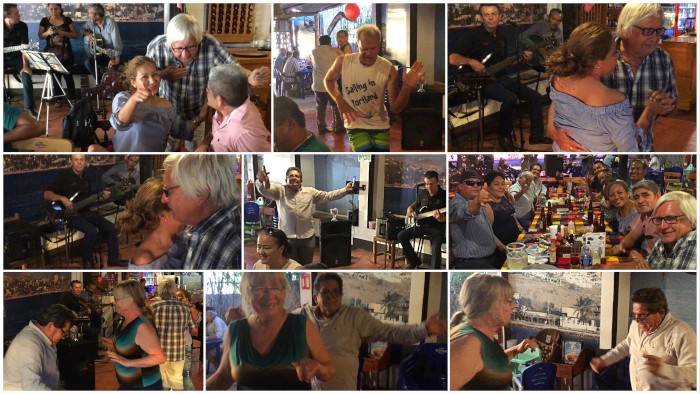
This blowout was even bigger than last week's blowout!
The key was that next to us was a huge, long, family table, with 20+ people sitting beside us. They were celebrating the birthday of a 16 year old. Teenagers are teenagers, and after the dinner and cake the teenagers at their table drifted away. So the adults at the table invited us to join them at their table. And then the real party began!
The photos above give you the idea. But videos can be even better:
Here is a video of my sailing friends Leslie and Laurin dancing with some of the adults from the party group.
Then the musicians started blasting out their one go-to swing song, which they always play when I am there - Cotton Fields.
So I grabbed one of the gals at the table and we tore the place up.
And then....we did it again.
And with all of the encouragement from the festivity at our table (plus several margaritas), I had to ham it up a little on my own.
If you want to see all of the photos and videos, you can see them all and more on-line.
The key was that next to us was a huge, long, family table, with 20+ people sitting beside us. They were celebrating the birthday of a 16 year old. Teenagers are teenagers, and after the dinner and cake the teenagers at their table drifted away. So the adults at the table invited us to join them at their table. And then the real party began!
The photos above give you the idea. But videos can be even better:
Here is a video of my sailing friends Leslie and Laurin dancing with some of the adults from the party group.
Then the musicians started blasting out their one go-to swing song, which they always play when I am there - Cotton Fields.
So I grabbed one of the gals at the table and we tore the place up.
And then....we did it again.
And with all of the encouragement from the festivity at our table (plus several margaritas), I had to ham it up a little on my own.
If you want to see all of the photos and videos, you can see them all and more on-line.
Studying Spanish over Margaritas
02 May 2018 | La Paz, Baja, Mexico

Above left are my friends Hugo and Leslie, and above right Conchita joins us too. Hugo, Leslie, and I drank margaritas, served by Conchita in her restaurant at the marina.
I put both Hugo and Conchita to work helping me to understand the lyrics in a song I had videoed at El Molinito the night before. Frankly, I could not understand hardly anything. But with their help we identified the song and found the lyrics. Like most songs, the lyrics lacked great significance, and I might even enjoy the songs more when I don’t understand the lyrics.
But studying the lyrics with Hugo and Conchita’s help was a good learning experience, a good people experience, and enhanced by great margaritas (made from scratch of course - tequila, Controy, and fresh-squeezed lime juice).
I put both Hugo and Conchita to work helping me to understand the lyrics in a song I had videoed at El Molinito the night before. Frankly, I could not understand hardly anything. But with their help we identified the song and found the lyrics. Like most songs, the lyrics lacked great significance, and I might even enjoy the songs more when I don’t understand the lyrics.
But studying the lyrics with Hugo and Conchita’s help was a good learning experience, a good people experience, and enhanced by great margaritas (made from scratch of course - tequila, Controy, and fresh-squeezed lime juice).
Blowout in El Molinito Restaurante
01 May 2018 | La Paz, Baja, Mexico

In a prior post I featured the El Molinito restaurant, and linked to a video showing the music and my dancing with a young girl.
When I go there on music nights I try to liven it up by getting others dancing. The waiters and the musicians seem to like our arrival and the added liveliness.
Sunday I went there and we had a blowout! The photo above right shows one of the waiters going crazy and dancing with a beer can. I tried to get an older guy to get up to dance and he declined, but his wife was all excited and dragged him up, then the little kids at their table got up, plus a young couple at another table - the most we’ve ever got up dancing.
Plus when the band blasted out for us their one go-to swing song I did a big swing-out and some kicks and everyone started yelling.
We all had a good time, including the dancing waiter (If you can’t find a partner get a wooden chair....or a beer can).
And you too can listen to a sample of the music from last Sunday (just click!).
When I go there on music nights I try to liven it up by getting others dancing. The waiters and the musicians seem to like our arrival and the added liveliness.
Sunday I went there and we had a blowout! The photo above right shows one of the waiters going crazy and dancing with a beer can. I tried to get an older guy to get up to dance and he declined, but his wife was all excited and dragged him up, then the little kids at their table got up, plus a young couple at another table - the most we’ve ever got up dancing.
Plus when the band blasted out for us their one go-to swing song I did a big swing-out and some kicks and everyone started yelling.
We all had a good time, including the dancing waiter (If you can’t find a partner get a wooden chair....or a beer can).
And you too can listen to a sample of the music from last Sunday (just click!).
The Toil of Sailing
26 April 2018 | La Paz, Baja, Mexico
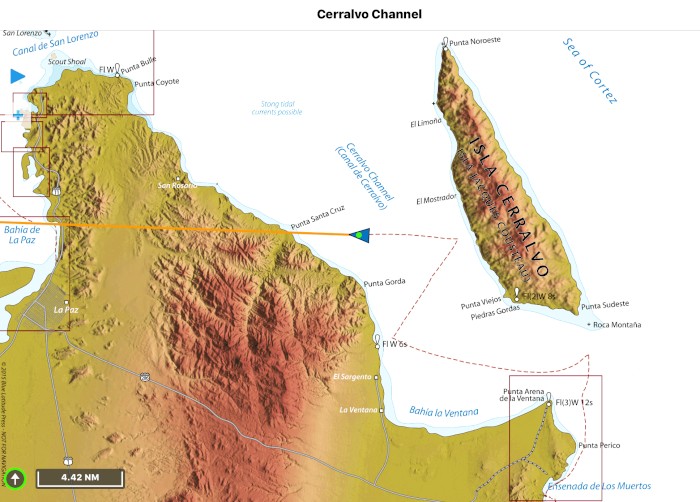
My prior post discussed how sailing can enthrall us with beauty, discomfort us, punish us, slam us around, and even injure us. But that's not all.
Sailing can wear us out. We work, we toil when we sail, and when conditions are harder, we toil harder.
The graphic above shows the track of S/V Ubiquity several days ago sailing north through the Canal de Cerralvo (the Cerralvo Channel). Sailors dread the Cerralvo Channel for its strong winds, seas, and currents. The old U.S. Sailing Directions publication advised not to attempt the channel in a headwind. But the zigzag course of Ubiquity's track tells any sailor that Ubiquity was sailing against a headwind, because tacking, zigzaging, is how sailboats progress upwind.
That track represents hours of sailing: at first easy, then becoming rough against increasingly strong winds and seas in the worst part of the channel, then gradually easier. When the wind increased into the 20's and the seas steepened, S/V Ubiquity punched through the rough seas with a reefed main and a reefed headsail, healed far over, spray coming off the bow and over the whole boat. But even with the rough seas against her, slamming her with steep waves to try to stop her, she could make four knots or more. Four knots or more sailing, not motoring. Motoring she might average a knot against such seas, stopped by the impact of each wave. Ubiquity's designer, William Crealock, designed her as a cruising sailboat that in rough conditions can harness the power of the wind (increasing fourfold with each doubling of wind speed), heal over as if gripping the sea, and slice through the tempestuous water with her v-shaped hull.
Here is a graphic showing Ubiquity's tracks years ago sailing up the Principe Channel, British Columbia, just south of Alaska. Here is a second graphic. Those tracks represent a day's work of tacking, zigzagging.
Few do this kind of sailing and few would want to do it, especially in rough conditions - tacking back and forth circuitously, healed over, punished if conditions are rough.
It's work, toil, the toil of sailing.
Sailing can wear us out. We work, we toil when we sail, and when conditions are harder, we toil harder.
The graphic above shows the track of S/V Ubiquity several days ago sailing north through the Canal de Cerralvo (the Cerralvo Channel). Sailors dread the Cerralvo Channel for its strong winds, seas, and currents. The old U.S. Sailing Directions publication advised not to attempt the channel in a headwind. But the zigzag course of Ubiquity's track tells any sailor that Ubiquity was sailing against a headwind, because tacking, zigzaging, is how sailboats progress upwind.
That track represents hours of sailing: at first easy, then becoming rough against increasingly strong winds and seas in the worst part of the channel, then gradually easier. When the wind increased into the 20's and the seas steepened, S/V Ubiquity punched through the rough seas with a reefed main and a reefed headsail, healed far over, spray coming off the bow and over the whole boat. But even with the rough seas against her, slamming her with steep waves to try to stop her, she could make four knots or more. Four knots or more sailing, not motoring. Motoring she might average a knot against such seas, stopped by the impact of each wave. Ubiquity's designer, William Crealock, designed her as a cruising sailboat that in rough conditions can harness the power of the wind (increasing fourfold with each doubling of wind speed), heal over as if gripping the sea, and slice through the tempestuous water with her v-shaped hull.
Here is a graphic showing Ubiquity's tracks years ago sailing up the Principe Channel, British Columbia, just south of Alaska. Here is a second graphic. Those tracks represent a day's work of tacking, zigzagging.
Few do this kind of sailing and few would want to do it, especially in rough conditions - tacking back and forth circuitously, healed over, punished if conditions are rough.
It's work, toil, the toil of sailing.
The Beauty of Sailing
25 April 2018 | La Paz, Baja, Mexico
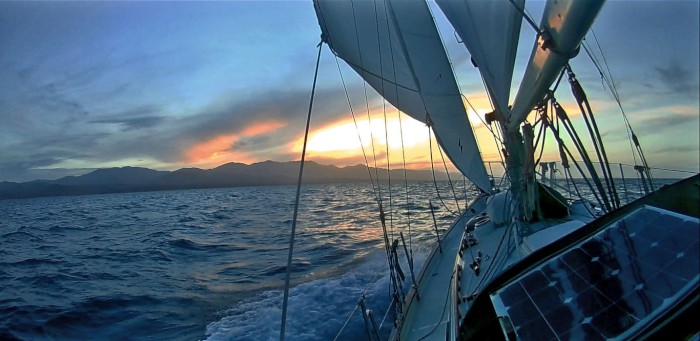
Sailing can do different things to us. Sailing can punish us and discomfort us (See my recent post on Cape Falso). Sailing can slam us around and even injure us (See my past post on first aid at sea). But sometimes sailing enthralls us with beauty.
The photo above shows one of those beauty-of-sailing moments several days ago on the Sea of Cortez. Earlier in the day the wind and seas were bigger and sailing was more punishing. But nearing sunset the wind and seas had diminished, S/V Ubiquity was sailing beautifully as a cutter and was several hours from her night arrival at the Los Muertos anchorage, and captain and crew could relax and savor the beauty of sailing.
You can view video from this moment on S/V Ubiquity and also savor the beauty of sailing.
The photo above shows one of those beauty-of-sailing moments several days ago on the Sea of Cortez. Earlier in the day the wind and seas were bigger and sailing was more punishing. But nearing sunset the wind and seas had diminished, S/V Ubiquity was sailing beautifully as a cutter and was several hours from her night arrival at the Los Muertos anchorage, and captain and crew could relax and savor the beauty of sailing.
You can view video from this moment on S/V Ubiquity and also savor the beauty of sailing.
Change of Plans after an Epiphany
15 April 2018 | Puerto Los Cabos Marina, San Jose del Cabo, Mexico
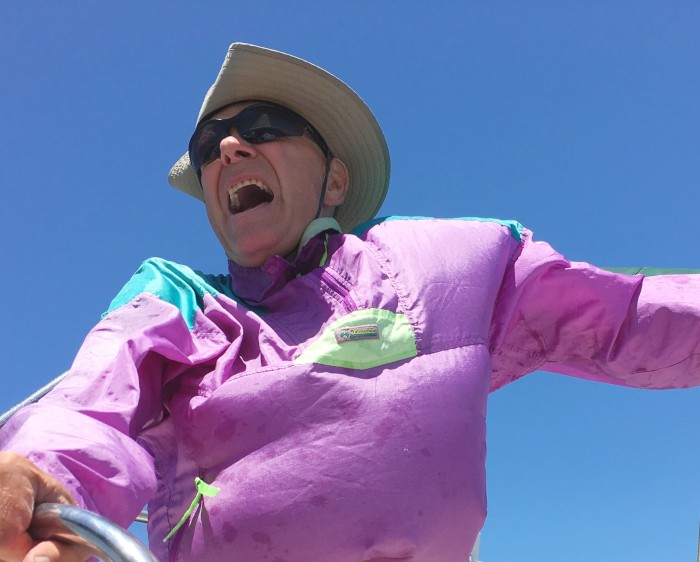
(Above photo shows S/V Ubiquity's Captain as Ubiquity crashed through the waves off Cabo Falso.)
Cape Falso beat us up, but also caused us to realize that we really did not want to beat our way around all of the capes sailing from Ensenada to Portland.
Until dealing with Falso I had focused on the idea of sailing far offshore to make Isla Guadalupe, then cross over to the Baja and make Ensenada. But after we were past our beating from Falso, Leslie (my crew) and I talked and we realized we did not want to spend the next few months beating our way around all the other capes. When we sailed south in 2016 we left late in the season, got into winter weather, and had to beat our way around Capes Blanco and Mendocino. Going north in the summer we would have to beat against the wind around all of the capes - Conception, Mendocino, Blanco, and all the smaller ones.
After realizing we did not want to do that now, then sailing the offshore route to Ensenada no longer made sense. We had already decided we did not want to sail to Hawaii, since we had heard how it is not cruiser friendly. My backup option has been to ship the boat to Victoria on a freighter from La Paz. Since we like Victoria and the summer sailing options nearby, and since paying for the freighter transport is not an issue for me, we decided to enjoy the Sea of Cortez a little more, then prepare the boat in La Paz to ship to Victoria.
So that's basically what happened: Getting beat up by Cabo Falso led us to realize we did not want to spend the next several months beating all the way up the west coast around all of the other capes, and we decided to ship S/V Ubiquity to Victoria and use her in the summer in the Pacific Northwest.
I am sorry if I have disappointed some of my blog readers by not doing the offshore route to Isla Guadalupe. I still think it is a viable, although hard, sailing route. Perhaps I have inspired some of my readers, and perhaps one will try it some day.
Cape Falso beat us up, but also caused us to realize that we really did not want to beat our way around all of the capes sailing from Ensenada to Portland.
Until dealing with Falso I had focused on the idea of sailing far offshore to make Isla Guadalupe, then cross over to the Baja and make Ensenada. But after we were past our beating from Falso, Leslie (my crew) and I talked and we realized we did not want to spend the next few months beating our way around all the other capes. When we sailed south in 2016 we left late in the season, got into winter weather, and had to beat our way around Capes Blanco and Mendocino. Going north in the summer we would have to beat against the wind around all of the capes - Conception, Mendocino, Blanco, and all the smaller ones.
After realizing we did not want to do that now, then sailing the offshore route to Ensenada no longer made sense. We had already decided we did not want to sail to Hawaii, since we had heard how it is not cruiser friendly. My backup option has been to ship the boat to Victoria on a freighter from La Paz. Since we like Victoria and the summer sailing options nearby, and since paying for the freighter transport is not an issue for me, we decided to enjoy the Sea of Cortez a little more, then prepare the boat in La Paz to ship to Victoria.
So that's basically what happened: Getting beat up by Cabo Falso led us to realize we did not want to spend the next several months beating all the way up the west coast around all of the other capes, and we decided to ship S/V Ubiquity to Victoria and use her in the summer in the Pacific Northwest.
I am sorry if I have disappointed some of my blog readers by not doing the offshore route to Isla Guadalupe. I still think it is a viable, although hard, sailing route. Perhaps I have inspired some of my readers, and perhaps one will try it some day.
Cabo Falso - I Falsely Estimated You
15 April 2018 | Puerto Los Cabos Marina, San Jose del Cabo, Mexico
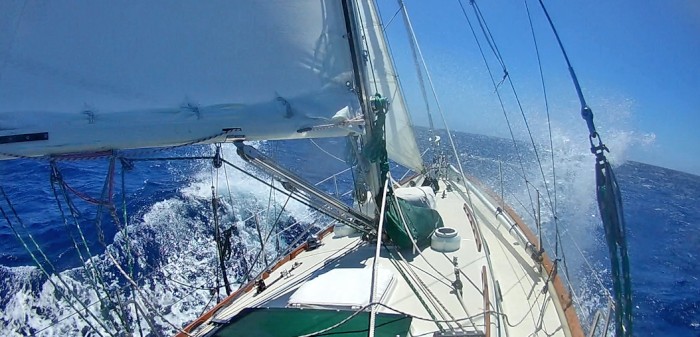
(Above photo shows S/V Ubiquity, under reefed mainsail and the staysail, crashing through the punishment of Cabo Falso.)
Cabo Falso, the cape just west of Cabo San Lucas, does not look very pronounced or formidable on a chart. Compared to the massiveness of Cape Mendocino, or the prominence of Point Conception or Cape Blanco, Falso looks almost diminutive. Yet a formidable reputation follows this cape, even more than the other capes. Perhaps being at the end of such a long peninsula (the Baja) more than makes up for its lessor geographical prominence. Cabo Falso’s formidable reputation proved warranted when S/V Ubiquity sailed by it several days ago.
Many cruisers going north on the Baja Bash leave the Los Cabos area in the middle of the night in hopes of passing Cabo Falso during nighttime quiescence. Ubiquity left the Los Cabos marina about 6:00 am, on a day with too much wind forecasted for Bashers. Since we were not intending to go north past Cabo Falso, but rather head west out to sea, I did not expect a lot of trouble and was satisfied with our departure time. Plus unlike the Bashers we could turn left as needed to sail with the wind and make it easier to get away from the cape. Finally we needed wind to sail, unlike the Bashers who avoid wind so that they can motor better.
The first indicator that I had underestimated Cabo Falso was the heavy line of whitecaps ahead of us when passing Cabo San Lucas. When we got into the heavier wind and seas we saw that none of the forecasts we had examined modeled adequately the cape effect, as our winds were higher than any forecasted.
As planned we turned left to ease some the punishment to the boat and crew. In the worst conditions we bore off to a beam reach and were headed due south, so I didn’t want to bear off more. With waves hitting us about on the beam we were taking heavy spray over the bow and over the sides. With a reefed main and a staysail we sailed very fast, albeit in a very southerly direction. Gradually as we got further from the cape we could turn more west, but still southwest.
Yes, I had underestimated Cabo Falso, and she made the captain, crew, and boat pay for it. The Cape’s punishment also led to an epiphany for the captain and crew - see the upcoming blog post.
Video is on-line showing Ubiquity taking Cabo Falso’s punishment (although not showing the very worst conditions).
Cabo Falso, the cape just west of Cabo San Lucas, does not look very pronounced or formidable on a chart. Compared to the massiveness of Cape Mendocino, or the prominence of Point Conception or Cape Blanco, Falso looks almost diminutive. Yet a formidable reputation follows this cape, even more than the other capes. Perhaps being at the end of such a long peninsula (the Baja) more than makes up for its lessor geographical prominence. Cabo Falso’s formidable reputation proved warranted when S/V Ubiquity sailed by it several days ago.
Many cruisers going north on the Baja Bash leave the Los Cabos area in the middle of the night in hopes of passing Cabo Falso during nighttime quiescence. Ubiquity left the Los Cabos marina about 6:00 am, on a day with too much wind forecasted for Bashers. Since we were not intending to go north past Cabo Falso, but rather head west out to sea, I did not expect a lot of trouble and was satisfied with our departure time. Plus unlike the Bashers we could turn left as needed to sail with the wind and make it easier to get away from the cape. Finally we needed wind to sail, unlike the Bashers who avoid wind so that they can motor better.
The first indicator that I had underestimated Cabo Falso was the heavy line of whitecaps ahead of us when passing Cabo San Lucas. When we got into the heavier wind and seas we saw that none of the forecasts we had examined modeled adequately the cape effect, as our winds were higher than any forecasted.
As planned we turned left to ease some the punishment to the boat and crew. In the worst conditions we bore off to a beam reach and were headed due south, so I didn’t want to bear off more. With waves hitting us about on the beam we were taking heavy spray over the bow and over the sides. With a reefed main and a staysail we sailed very fast, albeit in a very southerly direction. Gradually as we got further from the cape we could turn more west, but still southwest.
Yes, I had underestimated Cabo Falso, and she made the captain, crew, and boat pay for it. The Cape’s punishment also led to an epiphany for the captain and crew - see the upcoming blog post.
Video is on-line showing Ubiquity taking Cabo Falso’s punishment (although not showing the very worst conditions).
Sailing Off and Sailing On the Anchor
08 April 2018 | Puerto Los Cabos Marina, San Jose del Cabo, Mexico
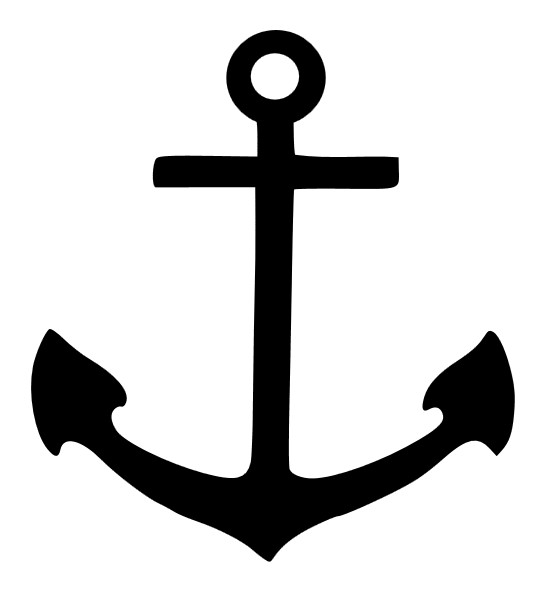
One of the traditional sailing skills that gives me pleasure when cruising is "sailing off the anchor" and "sailing on the anchor". Sailing off the anchor means leaving the anchorage without using the sailboat's engine. Sailing on the anchor means anchoring without using the sailboat's engine.
Before cruising sailboats had auxiliary engines they had no choice except to sail on and off the anchor. But today I see almost all cruising sailboats come into and leave the anchorage with all sails dropped, running the engine both ways.
One reason most cruisers today do not sail off the anchor is because they use an electrically powered windlass to raise the anchor, which requires running the engine. S/V Ubiquity has an electrically powered windlass, but I have never used it in powered mode to raise the anchor. I always raise the anchor manually by grinding (turning with a winch handle) the windlass by hand. I figure it is good arm exercise for me, saves wear on the windlass motor, saves the batteries, and does not require running the engine. Plus I can sail off the anchor.
So Ubiquity often sails off the anchor. If the wind is blowing the boat offshore, it is easy. We raise the anchor, Ubiquity starts moving offshore and gains steerage under bare poles, and we leisurely raise sail to speed up. If the wind is blowing Ubiquity onto a lee shore, or perhaps some nasty reefs, the captain and crew of Ubiquity confer first about the procedure. Typically, we raise the mainsail at anchor and then the captain grinds the anchor chain in while the crew flakes the chain in the chain locker. When most chain is in the captain calls the crew to man the helm. The captain grinds in the remaining chain and stows the anchor. After the anchor breaks loose the crew sails the boat to windward, under mainsail, following the agreed course to clear the shore hazards.
Sailing on the anchor can be harder, but is easy for an open roadstead type anchorage, especially if the wind blows offshore. Whatever the conditions we first furl the headsail to reduce speed when coming into the anchorage. Then if the wind blows offshore we will tack under mainsail until reaching the desired anchoring location. The captain will then ask the crew manning the helm to steer into the wind as the captain goes forward, quickly drops the mainsail, then drops the anchor as the boat comes to a stop and the bow starts blowing off the wind. When I stop letting out chain the ground tackle (anchor plus chain) will pull the bow back into the wind and hopefully set the anchor.
When sailing onto the anchor with the wind blowing onshore, or in a more crowded or tighter anchorage, after reaching the desired anchoring location I may either drop the mainsail and lie ahull before anchoring, or heave to (Ubiquity heaves to well under mainsail alone) with the mainsail up and then drop the mainsail before anchoring. Either lying ahull or hove to Ubiquity will lie fairly still in the water, making very slow leeway, giving time to attend to the mainsail before anchoring.
There are other ways to do it of course, as described in the sailing books. You can set the anchor more dynamically under sail, perhaps eliminating the need for what I discuss next. But these procedures we use on Ubiquity we like, and feel very calm and controlled.
Now the bad part. After sailing onto the anchor I always ask myself if I should run the engine to make sure of a good anchor set. Even if I feel great about the sailing on the anchor, when I ask myself if the anchor should drag, with some consequent problem, would I feel stupid that I did not take the precaution of backing down on the anchor with the engine, I answer yes. So I besmirch the purity of sailing on the anchor, perhaps after sailing off the anchor in the morning and not using the engine all day, by running the engine.
Hal Roth himself, a famous sailing author and cruiser, who espoused the skill of sailing on and off the anchor, said that perhaps the most important role of the sailboat auxiliary engine was to test and set the anchor. So purity is nice, but protecting your boat is nice too.
Before cruising sailboats had auxiliary engines they had no choice except to sail on and off the anchor. But today I see almost all cruising sailboats come into and leave the anchorage with all sails dropped, running the engine both ways.
One reason most cruisers today do not sail off the anchor is because they use an electrically powered windlass to raise the anchor, which requires running the engine. S/V Ubiquity has an electrically powered windlass, but I have never used it in powered mode to raise the anchor. I always raise the anchor manually by grinding (turning with a winch handle) the windlass by hand. I figure it is good arm exercise for me, saves wear on the windlass motor, saves the batteries, and does not require running the engine. Plus I can sail off the anchor.
So Ubiquity often sails off the anchor. If the wind is blowing the boat offshore, it is easy. We raise the anchor, Ubiquity starts moving offshore and gains steerage under bare poles, and we leisurely raise sail to speed up. If the wind is blowing Ubiquity onto a lee shore, or perhaps some nasty reefs, the captain and crew of Ubiquity confer first about the procedure. Typically, we raise the mainsail at anchor and then the captain grinds the anchor chain in while the crew flakes the chain in the chain locker. When most chain is in the captain calls the crew to man the helm. The captain grinds in the remaining chain and stows the anchor. After the anchor breaks loose the crew sails the boat to windward, under mainsail, following the agreed course to clear the shore hazards.
Sailing on the anchor can be harder, but is easy for an open roadstead type anchorage, especially if the wind blows offshore. Whatever the conditions we first furl the headsail to reduce speed when coming into the anchorage. Then if the wind blows offshore we will tack under mainsail until reaching the desired anchoring location. The captain will then ask the crew manning the helm to steer into the wind as the captain goes forward, quickly drops the mainsail, then drops the anchor as the boat comes to a stop and the bow starts blowing off the wind. When I stop letting out chain the ground tackle (anchor plus chain) will pull the bow back into the wind and hopefully set the anchor.
When sailing onto the anchor with the wind blowing onshore, or in a more crowded or tighter anchorage, after reaching the desired anchoring location I may either drop the mainsail and lie ahull before anchoring, or heave to (Ubiquity heaves to well under mainsail alone) with the mainsail up and then drop the mainsail before anchoring. Either lying ahull or hove to Ubiquity will lie fairly still in the water, making very slow leeway, giving time to attend to the mainsail before anchoring.
There are other ways to do it of course, as described in the sailing books. You can set the anchor more dynamically under sail, perhaps eliminating the need for what I discuss next. But these procedures we use on Ubiquity we like, and feel very calm and controlled.
Now the bad part. After sailing onto the anchor I always ask myself if I should run the engine to make sure of a good anchor set. Even if I feel great about the sailing on the anchor, when I ask myself if the anchor should drag, with some consequent problem, would I feel stupid that I did not take the precaution of backing down on the anchor with the engine, I answer yes. So I besmirch the purity of sailing on the anchor, perhaps after sailing off the anchor in the morning and not using the engine all day, by running the engine.
Hal Roth himself, a famous sailing author and cruiser, who espoused the skill of sailing on and off the anchor, said that perhaps the most important role of the sailboat auxiliary engine was to test and set the anchor. So purity is nice, but protecting your boat is nice too.
Who Has The Right Stuff?
06 April 2018 | Puerto Los Cabos Marina, San Jose del Cabo, Mexico
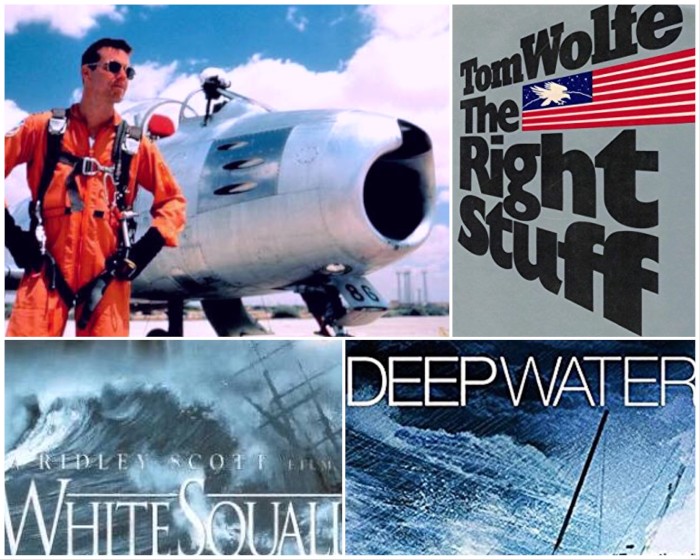
In my mind, that is me in the upper left photo above. Clearly I have “the right stuff”, just as Tom Wolfe described in his best-selling book about the test pilots who became the American astronauts.
In the past only men had the right stuff, but today we are more enlightened. Regardless of your sex, race, or whatever you too can imagine yourself like me in the upper left photo, clearly manifesting the right stuff.
As captain of S/V Ubiquity, and hence purveyor of the right stuff, I decreed two nights ago that we would watch the documentary video “Deep Water”. So at night, lying ahull ten miles off the Baja, captain and crew watched the demise of Donald Crowhurst after months at sea on the Golden Globe Race. The next night I decreed, again as purveyor of the right stuff, that we would watch “White Squall”, a scary movie based on the loss of the tall ship Albatross in the Caribbean. So at night, at anchor in Bahia Frailes, captain and crew watched the sinking of the Albatross and the deaths of some of her crew.
For someone with the right stuff, these films should cause no trepidation. They provide the perfect tonic in preparation for S/V Ubiquity’s up-coming attempt to sail a far off-shore route to Isla Guadalupe.
But Ubiquity’s crew reported that she woke up this morning reliving some of the scenes from “White Squall” with the ship breaking up and crew drowning. She says watching the movies has increased her trepidation.
So as I, captain of S/V Ubiquity, prepare the boat for leaving San Jose del Cabo shortly, I must rejoice in having the right stuff, right? As captain of S/V Ubiquity I am the apotheosis of the right stuff, right?? Watching “Deep Water” and “White Squall” would cause me no iota of anxiety, right??? Right????
In the past only men had the right stuff, but today we are more enlightened. Regardless of your sex, race, or whatever you too can imagine yourself like me in the upper left photo, clearly manifesting the right stuff.
As captain of S/V Ubiquity, and hence purveyor of the right stuff, I decreed two nights ago that we would watch the documentary video “Deep Water”. So at night, lying ahull ten miles off the Baja, captain and crew watched the demise of Donald Crowhurst after months at sea on the Golden Globe Race. The next night I decreed, again as purveyor of the right stuff, that we would watch “White Squall”, a scary movie based on the loss of the tall ship Albatross in the Caribbean. So at night, at anchor in Bahia Frailes, captain and crew watched the sinking of the Albatross and the deaths of some of her crew.
For someone with the right stuff, these films should cause no trepidation. They provide the perfect tonic in preparation for S/V Ubiquity’s up-coming attempt to sail a far off-shore route to Isla Guadalupe.
But Ubiquity’s crew reported that she woke up this morning reliving some of the scenes from “White Squall” with the ship breaking up and crew drowning. She says watching the movies has increased her trepidation.
So as I, captain of S/V Ubiquity, prepare the boat for leaving San Jose del Cabo shortly, I must rejoice in having the right stuff, right? As captain of S/V Ubiquity I am the apotheosis of the right stuff, right?? Watching “Deep Water” and “White Squall” would cause me no iota of anxiety, right??? Right????
Leaving is Hard to Do
01 April 2018 | La Paz, Baja, Mexico
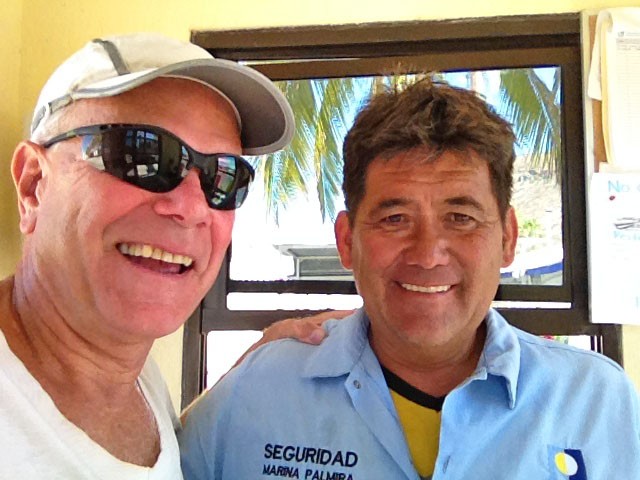
Leaving La Paz today is hard, as was leaving Santa Rosalia and leaving San Carlos.
Above is my goodbye selfie photo with Hugo, "mi buen amigo". When I went over to say goodbye I took him a cold drink, as I often do on hot days. I also gave him a present of a small, focusing, LED flashlight. I love these flashlights and brought a number of extras with me to give away (say to fishermen who stop by the boat, or to kids). So I gave one to Hugo and I think he liked my thinking to give him something.
Hugo is very "amigable", very agreeable, friendly. The first time I arrived at Marina Palmira he met me at the dock to help. Now he works at the vehicle entrance station, a promotion I think fits well his personality.
So saying goodbye to Hugo was a little sad. Leaving is hard to do.
Above is my goodbye selfie photo with Hugo, "mi buen amigo". When I went over to say goodbye I took him a cold drink, as I often do on hot days. I also gave him a present of a small, focusing, LED flashlight. I love these flashlights and brought a number of extras with me to give away (say to fishermen who stop by the boat, or to kids). So I gave one to Hugo and I think he liked my thinking to give him something.
Hugo is very "amigable", very agreeable, friendly. The first time I arrived at Marina Palmira he met me at the dock to help. Now he works at the vehicle entrance station, a promotion I think fits well his personality.
So saying goodbye to Hugo was a little sad. Leaving is hard to do.
Sailing a Far Off-Shore (“Clipper-Ship”) Route: Tactical Explication
29 March 2018 | La Paz, Baja, Mexico
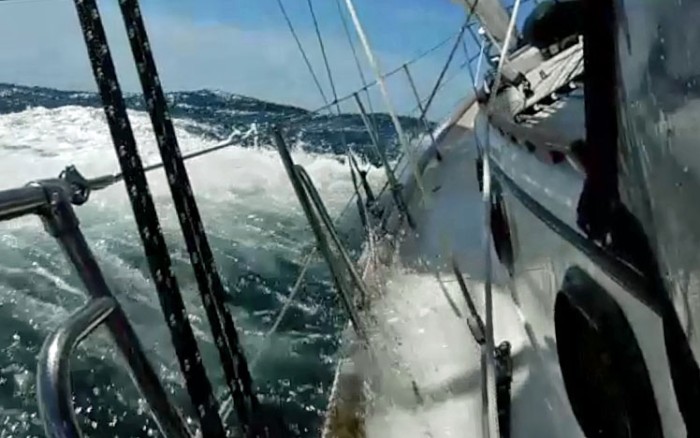
The photo above shows S/V Ubiquity sailing as a cutter off the Washington coast, beating into winds in the 20's, Yankee headsail sheeted to the inside genoa track on the side deck, toerail in the water. We took three days to sail up the Washington coast, to make the same distance that others motor-sail in two days. Sailing to Isla Guadalupe is like a big version, a very big version, of that sail up the Washington coast.
For most sailing I use a 110 headsail, sheeted to the genoa track on the toe rail. The shrouds on the Pacific Seacraft 34 design terminate on outboard chainplates which limit how high Ubiquity can sail to weather using the 110 headsail. For sailing to weather, especially in higher winds, such as off the Washington or Baja coast, Ubiquity can point higher sailing as a cutter and using a smaller high-cut Yankee as the headsail, combined with the staysail and the mainsail (often reefed), with the Yankee sheeted to the inside genoa track on the side deck.
Here is a photo showing the cut of the Yankee and the staysail, hoisted together at the dock. The Yankee is a 55 headsail, 130 square feet. The staysail is 80 square feet. Both the Yankee and staysail together have 210 square feet, compared to the 290 square feet for the 110 headsail. So sailing to weather as a cutter with the Yankee and the staysail has great flexibility, works well in higher winds, and allows tight sheeting.
Another tactical issue is showing consideration for the captain and crew by not pushing the boat too hard, too fast. Being willing to reduce sail, go slower, and fore-reach or even heave-to in stronger winds can help the captain and crew (in their 70's) to sustain the long passage in good condition.
Those are my tricks, captain of S/V Ubiquity in 2018, but those tricks surely pale compared to what the sailors of the late 1800's knew from all of their experience. So will the captain, crew, and S/V Ubiquity prove able to emulate how those sailors from a past era sailed these off-shore routes? I feel those sailors, long deceased, would wish us success, and I imagine hearing them whisper advice in my ear. With their help, we may succeed.
For most sailing I use a 110 headsail, sheeted to the genoa track on the toe rail. The shrouds on the Pacific Seacraft 34 design terminate on outboard chainplates which limit how high Ubiquity can sail to weather using the 110 headsail. For sailing to weather, especially in higher winds, such as off the Washington or Baja coast, Ubiquity can point higher sailing as a cutter and using a smaller high-cut Yankee as the headsail, combined with the staysail and the mainsail (often reefed), with the Yankee sheeted to the inside genoa track on the side deck.
Here is a photo showing the cut of the Yankee and the staysail, hoisted together at the dock. The Yankee is a 55 headsail, 130 square feet. The staysail is 80 square feet. Both the Yankee and staysail together have 210 square feet, compared to the 290 square feet for the 110 headsail. So sailing to weather as a cutter with the Yankee and the staysail has great flexibility, works well in higher winds, and allows tight sheeting.
Another tactical issue is showing consideration for the captain and crew by not pushing the boat too hard, too fast. Being willing to reduce sail, go slower, and fore-reach or even heave-to in stronger winds can help the captain and crew (in their 70's) to sustain the long passage in good condition.
Those are my tricks, captain of S/V Ubiquity in 2018, but those tricks surely pale compared to what the sailors of the late 1800's knew from all of their experience. So will the captain, crew, and S/V Ubiquity prove able to emulate how those sailors from a past era sailed these off-shore routes? I feel those sailors, long deceased, would wish us success, and I imagine hearing them whisper advice in my ear. With their help, we may succeed.
Sailing a Far Off-Shore (“Clipper-Ship”) Route: Strategic Explication
28 March 2018 | La Paz, Baja, Mexico
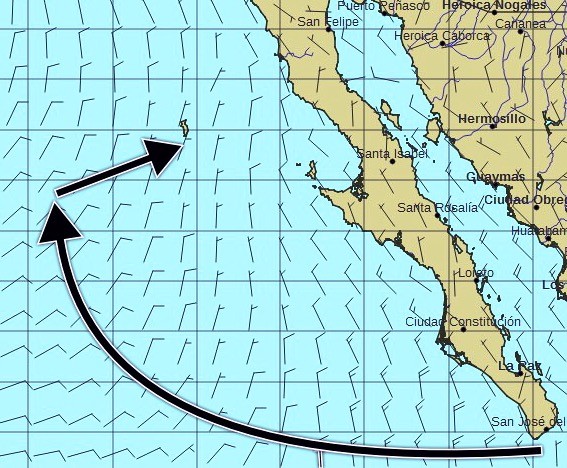
The wind graphic above explicates the strategic concept of sailing back from Mexico (Cabo to Isla Guadalupe) via a far off-shore route. The wind arrows on the graphic depict the forecasted wind direction, with the wind coming from the head (with the barbs) towards the tail (without the barbs).
Look at this graphic and trace a boating route going north following near to the west coast of Baja. The wind arrows show the wind coming pretty straight down the coast. So anyone in a boat going north along the coast will go directly into the wind and the waves. This requires motoring, not sailing, and is called fittingly the "Baja Bash". The Bash is by far the most popular way that cruisers to Mexico bring back their boats to the U.S.
Now look at my proposed route in the diagram. The wind arrows show the wind is somewhat on the side, allowing sailing on a close reach or a close haul. Further west from the Baja the wind direction changes, allowing the boat to gradually sail a more northerly course, and finally tack to make Isla Guadalupe.
So the strategic concept of the far off-shore route is quite simple. It uses the veering of the wind direction far off-shore (wind direction moves clockwise to a more easterly wind) to sail in a more northerly direction.
The wind pattern in this diagram is common, but of course the winds change. Using weather forecasts we will try to leave the Cabo area during a favorable weather window for sailing this off-shore route.
I hope some of you find this off-shore sailing route attractive and will join us vicariously. Together we will try to follow in the footsteps of sailors of a past era. Those sailors from long ago had not the engines to bash, but they had the skills to sail.
Look at this graphic and trace a boating route going north following near to the west coast of Baja. The wind arrows show the wind coming pretty straight down the coast. So anyone in a boat going north along the coast will go directly into the wind and the waves. This requires motoring, not sailing, and is called fittingly the "Baja Bash". The Bash is by far the most popular way that cruisers to Mexico bring back their boats to the U.S.
Now look at my proposed route in the diagram. The wind arrows show the wind is somewhat on the side, allowing sailing on a close reach or a close haul. Further west from the Baja the wind direction changes, allowing the boat to gradually sail a more northerly course, and finally tack to make Isla Guadalupe.
So the strategic concept of the far off-shore route is quite simple. It uses the veering of the wind direction far off-shore (wind direction moves clockwise to a more easterly wind) to sail in a more northerly direction.
The wind pattern in this diagram is common, but of course the winds change. Using weather forecasts we will try to leave the Cabo area during a favorable weather window for sailing this off-shore route.
I hope some of you find this off-shore sailing route attractive and will join us vicariously. Together we will try to follow in the footsteps of sailors of a past era. Those sailors from long ago had not the engines to bash, but they had the skills to sail.
A Voyage for Madmen
27 March 2018 | La Paz, Baja, Mexico
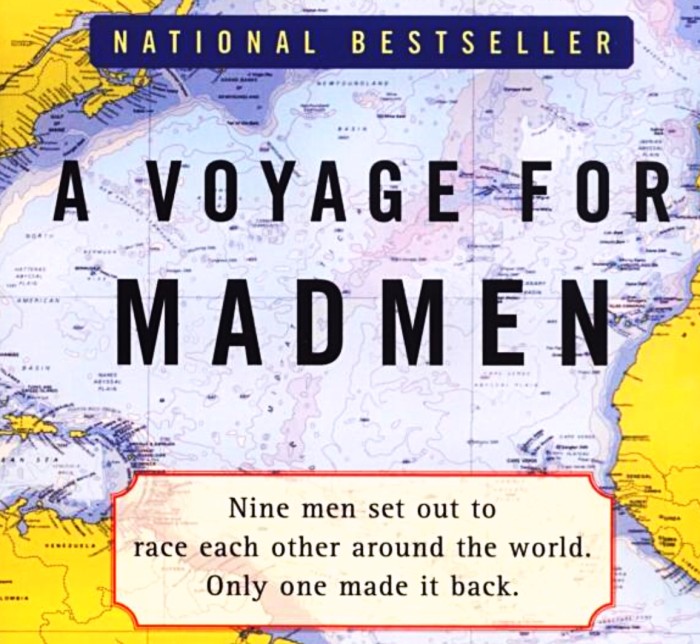
For the Golden Globe Race in 1968 nine sailors left England on nine sailboats to circumnavigate the world - alone, nonstop.* Donald Crowhurst, not fully prepared for such a race, apparently committed suicide by jumping overboard in the Atlantic, where a freighter found and recovered his boat. Bernard Moitessier, supremely competent but supremely mystical, chose not to come back to England and win the race but rather to keep sailing another two-thirds of the way around the world, eventually stopping and living in Tahiti. Robin Knox-Johnson, supremely competent and supremely normal, finished and won the race, and continues today to inspire long-distance sailors like myself.
I have decided on my own voyage for madmen. I intend to try to sail using a far off-shore (“clipper-ship”) route from the southern end of Baja to Isla Guadalupe, a remote island forming the most western point in Mexico, 200 nm southwest of Ensenada. I know of no one who has done this, although I have read about other sailors who have done far off-shore routes from Mexico to destinations on the US west coast. And many have of course sailed back via Hawaii, a longer but downwind (hence easier) route.
It will be the hardest sailing challenge I have tried, 1000 nm sailing to weather hundreds of miles west of the Baja. Can I, my boat, and my crew do it? I don’t know, but like the nine sailors on the Golden Globe Race, I will find out. It is my personal voyage for madmen.
I hope that I find out I am a Knox-Johnson, competent and normal. But what if I am a Moitessier, competent but unpredictable? Or worse yet what if I am a Crowhurst, unprepared for the challenge, resulting in madness and demise. What am I, and what fate awaits S/V Ubiquity and her crew?
There is only one way to find out.
==========
*For a riveting account of the Golden Globe Race I recommend the book, “A Voyage for Madmen”. For more on the incredible and tragic story of Donald Crowhurst, one of the competitors, see several books (“Desperate Voyage”, “The Strange Last Voyage of Donald Crowhurst”), a documentary video (“Deep Water”, available on Amazon Video and on YouTube), and a recently released movie (“The Mercy”).
I have decided on my own voyage for madmen. I intend to try to sail using a far off-shore (“clipper-ship”) route from the southern end of Baja to Isla Guadalupe, a remote island forming the most western point in Mexico, 200 nm southwest of Ensenada. I know of no one who has done this, although I have read about other sailors who have done far off-shore routes from Mexico to destinations on the US west coast. And many have of course sailed back via Hawaii, a longer but downwind (hence easier) route.
It will be the hardest sailing challenge I have tried, 1000 nm sailing to weather hundreds of miles west of the Baja. Can I, my boat, and my crew do it? I don’t know, but like the nine sailors on the Golden Globe Race, I will find out. It is my personal voyage for madmen.
I hope that I find out I am a Knox-Johnson, competent and normal. But what if I am a Moitessier, competent but unpredictable? Or worse yet what if I am a Crowhurst, unprepared for the challenge, resulting in madness and demise. What am I, and what fate awaits S/V Ubiquity and her crew?
There is only one way to find out.
==========
*For a riveting account of the Golden Globe Race I recommend the book, “A Voyage for Madmen”. For more on the incredible and tragic story of Donald Crowhurst, one of the competitors, see several books (“Desperate Voyage”, “The Strange Last Voyage of Donald Crowhurst”), a documentary video (“Deep Water”, available on Amazon Video and on YouTube), and a recently released movie (“The Mercy”).
Family Dining in La Paz
26 March 2018 | La Paz, Baja, Mexico
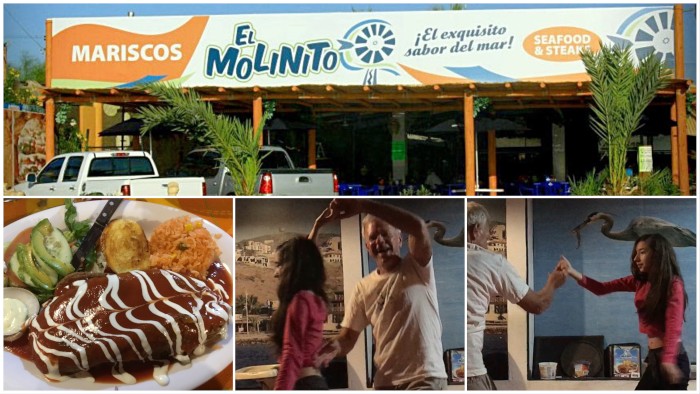
Just a short walk on the Malecón (walkway along the waterfront) from my marina is my favorite restaurant in La Paz. The top photo above shows the open dining area facing the Malecón and Bahia de La Paz. The bottom left photo shows the presentation of my chili rellenos last night. The food and margaritas are great, and so is the family atmosphere.
But the bottom right two photos show what makes El Molinito special for me, the live music on Saturdays and Sundays. The musicians play soulful and danceable Latin songs, but no one dances - except me. First I dance with my friend Leslie. Then I look at the nearby tables for any young girls, with their families, who look like they might like to dance. Sometimes the girls are too shy and giggle, but when they do dance their families love it, and I do my best to make them look their best for their families, who beam and often take pictures.
You can pretend that you are there too by watching the on-line video of the young La Paz girl above dancing with me at El Molinito.
But the bottom right two photos show what makes El Molinito special for me, the live music on Saturdays and Sundays. The musicians play soulful and danceable Latin songs, but no one dances - except me. First I dance with my friend Leslie. Then I look at the nearby tables for any young girls, with their families, who look like they might like to dance. Sometimes the girls are too shy and giggle, but when they do dance their families love it, and I do my best to make them look their best for their families, who beam and often take pictures.
You can pretend that you are there too by watching the on-line video of the young La Paz girl above dancing with me at El Molinito.
Cruisers Help Cruisers - That’s What We Do!
18 March 2018 | La Paz, Baja, Mexico
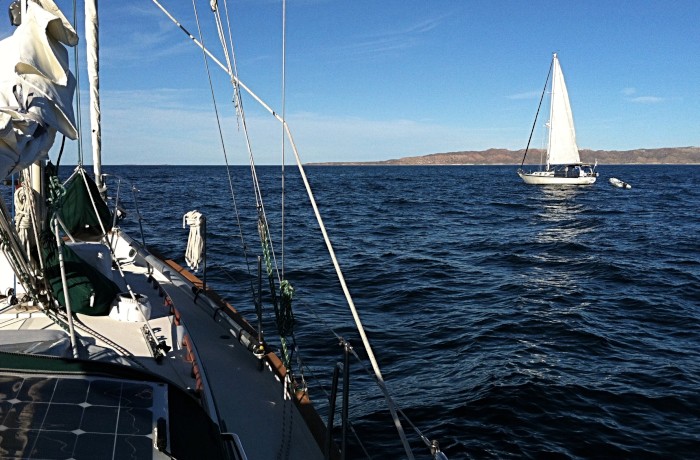
Cruisers in remote locations face potential adversities: weather, equipment failures, accidents. When cruising in the U.S. cruisers can call the U.S. Coast Guard and commercial towing services (BoatUS, Seatow) for help, but not here. So we help ourselves.
First, we strive for self-reliance. We carry lots of tools and spare parts. We know how to fix the boat when things break, fix ourselves when we get hurt, and operate and navigate the boat in all conditions.
Second, we help each other. Last year S/V Ubiquity helped a sports fishing boat (yes, cruisers will help them too) sinking in the Sea of Cortez. Although less dramatic, yesterday’s incident also shows the cruiser’s spirit of helping each other.
S/V Ubiquity was sailing slowly south from Puerto Escondido. We had started with a good sailing wind, but the wind had atrophied and Ubiquity was barely making 2 knots, with the sails slating occasionally. I watched through binoculars another cruising sailboat miles away, apparently sailing slowly towards us. I thought - a kindred spirit! Most cruisers will start the engine long before slowing to 2 knots under sail, but this boat was like us, trying to sail slowly in the diminishing conditions.
But then I saw on AIS that the boat was making only about 1/2 knot, with the direction erratic. What was she doing? Fishing, I decided. Probably people do not fish like that, but since I do not fish myself that explanation satisfied me.
Finally Ubiquity was dead in the water, sails slating, so we dropped the sails to motor the last 4 miles to our anchorage on Isla Monseratte. I turned on the electronics that were off to conserve power when sailing, including the AIS transponder which tells other boats where and who we are.
Shortly after turning on the AIS, I heard the other boat on the radio hailing S/V Ubiquity. The crew of the other boat told me they were trying to fix their engine that would not run. Ubiquity changed course towards the other boat to provide possible assistance. Cruisers help cruisers - that’s what we do.
We discussed options on the radio. The problem was that the wind had died so sailing was unreliable, and the route was near rocky islands where adrift without sail power or auxiliary engine power could be hazardous. The crew on the other boat had tried everything possible to fix the engine without success, so the services of Puerto Escondido seemed needed for the repair. We decided that the best option would be to get a power boat to tow the vessel into Puerto Escondido. Using their satellite phone, plus information I provided about whom to call, the other boat arranged for a power boat to provide a tow.
S/V Ubiquity lay ahull near the other boat (See the photo above) until we saw the power boat on its way.
The woman on the other boat told me on the radio that she had read my blog. She is a writer herself and yelled across to me when our boats were close, “I like your writing”. I beamed at the compliment. What a splendid payment for my help! But of course I needed no payment. Cruisers help cruisers - that’s what we do.
Later I thought about how I could have been more resourceful in providing assistance. A failing struck me. I never thought about the dinghy with an outboard motor that the other boat was towing. The dingy could have powered the boat, either by tying alongside or by towing, since even a small outboard motor can power a cruising boat slowly though calm seas.
So I felt I had failed. Ubiquity carries no outboard motor so I don’t have that option on my boat. But I saw that the other boat did have a dinghy with a motor, yet at the time I did not think of that nor discuss that with the other crew.
What a lost opportunity! The other boat could have motored, using the dingy, to our anchorage at Monserrate and we could have shared happy hour together (I had plenty of tequila, Controy, and limes). And we could have shared sailing stories (Cruisers do that too).
But I’m being selfish. The other boat was better off getting towed the other direction to Puerto Escondido where they could fix the engine.
So feeling bad for my gap in resourcefulness and for the loss of additional revelers at happy hour, I needed consoling. A second margarita helped. But what helped the most was knowing that despite my gap in resourcefulness I had lived up to the cruiser’s ethos.
Cruisers help cruisers - that’s what we do.
First, we strive for self-reliance. We carry lots of tools and spare parts. We know how to fix the boat when things break, fix ourselves when we get hurt, and operate and navigate the boat in all conditions.
Second, we help each other. Last year S/V Ubiquity helped a sports fishing boat (yes, cruisers will help them too) sinking in the Sea of Cortez. Although less dramatic, yesterday’s incident also shows the cruiser’s spirit of helping each other.
S/V Ubiquity was sailing slowly south from Puerto Escondido. We had started with a good sailing wind, but the wind had atrophied and Ubiquity was barely making 2 knots, with the sails slating occasionally. I watched through binoculars another cruising sailboat miles away, apparently sailing slowly towards us. I thought - a kindred spirit! Most cruisers will start the engine long before slowing to 2 knots under sail, but this boat was like us, trying to sail slowly in the diminishing conditions.
But then I saw on AIS that the boat was making only about 1/2 knot, with the direction erratic. What was she doing? Fishing, I decided. Probably people do not fish like that, but since I do not fish myself that explanation satisfied me.
Finally Ubiquity was dead in the water, sails slating, so we dropped the sails to motor the last 4 miles to our anchorage on Isla Monseratte. I turned on the electronics that were off to conserve power when sailing, including the AIS transponder which tells other boats where and who we are.
Shortly after turning on the AIS, I heard the other boat on the radio hailing S/V Ubiquity. The crew of the other boat told me they were trying to fix their engine that would not run. Ubiquity changed course towards the other boat to provide possible assistance. Cruisers help cruisers - that’s what we do.
We discussed options on the radio. The problem was that the wind had died so sailing was unreliable, and the route was near rocky islands where adrift without sail power or auxiliary engine power could be hazardous. The crew on the other boat had tried everything possible to fix the engine without success, so the services of Puerto Escondido seemed needed for the repair. We decided that the best option would be to get a power boat to tow the vessel into Puerto Escondido. Using their satellite phone, plus information I provided about whom to call, the other boat arranged for a power boat to provide a tow.
S/V Ubiquity lay ahull near the other boat (See the photo above) until we saw the power boat on its way.
The woman on the other boat told me on the radio that she had read my blog. She is a writer herself and yelled across to me when our boats were close, “I like your writing”. I beamed at the compliment. What a splendid payment for my help! But of course I needed no payment. Cruisers help cruisers - that’s what we do.
Later I thought about how I could have been more resourceful in providing assistance. A failing struck me. I never thought about the dinghy with an outboard motor that the other boat was towing. The dingy could have powered the boat, either by tying alongside or by towing, since even a small outboard motor can power a cruising boat slowly though calm seas.
So I felt I had failed. Ubiquity carries no outboard motor so I don’t have that option on my boat. But I saw that the other boat did have a dinghy with a motor, yet at the time I did not think of that nor discuss that with the other crew.
What a lost opportunity! The other boat could have motored, using the dingy, to our anchorage at Monserrate and we could have shared happy hour together (I had plenty of tequila, Controy, and limes). And we could have shared sailing stories (Cruisers do that too).
But I’m being selfish. The other boat was better off getting towed the other direction to Puerto Escondido where they could fix the engine.
So feeling bad for my gap in resourcefulness and for the loss of additional revelers at happy hour, I needed consoling. A second margarita helped. But what helped the most was knowing that despite my gap in resourcefulness I had lived up to the cruiser’s ethos.
Cruisers help cruisers - that’s what we do.
Weather Forecasting - A Bit of Humor in a Sea of Cortez Hurricane Hole
12 March 2018 | Puerto Escondido, Sea of Cortez, Mexico
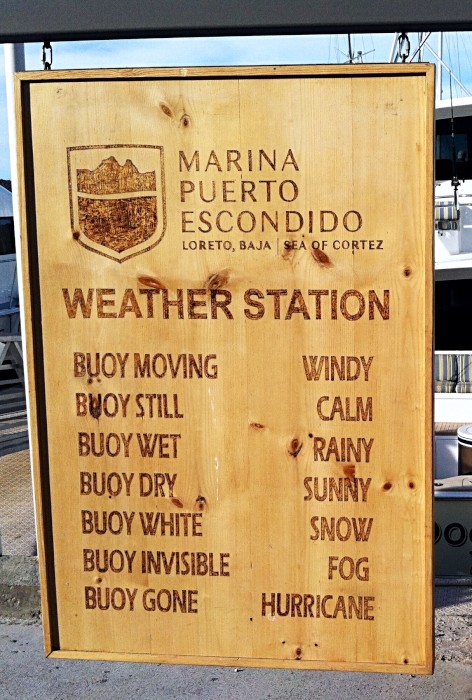
Like Puerto Don Juan in the northern Sea of Cortez (See my "Hail the Hole" blog post), Puerto Escondido serves as a "hurricane hole" for cruisers seeking shelter from severe weather.
Puerto Escondido has many mooring balls (floats boats can tie to instead of anchoring), and the marina made use of that to add a bit of humor with the sign you can see above.
When do you know there is a hurricane? Well, see the sign above.
Puerto Escondido has many mooring balls (floats boats can tie to instead of anchoring), and the marina made use of that to add a bit of humor with the sign you can see above.
When do you know there is a hurricane? Well, see the sign above.
Ghost Towns in the Sea of Cortez, Part 2
12 March 2018 | Puerto Escondido, Sea of Cortez, Mexico
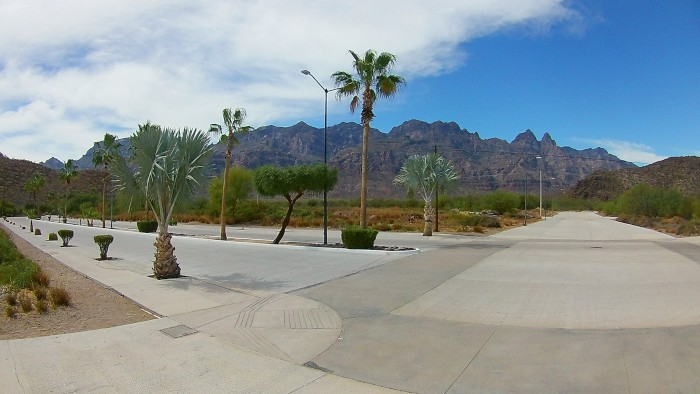
The second ghost town I visited, and am at now, in the Sea of Cortez differs greatly from Bahia Salinas, the ghost town I described in my last blog post.
Whereas Bahia Salinas was once a town where poor salt miners lived, and is now abandoned, Puerto Escondido was conceived as a town for rich development, and is now also abandoned.
In the photo above you can see the wide boulevards the Mexican government built decades ago at Puerto Escondido. It looks like the wide boulevards in parts of Los Angeles, perhaps Westwood. Two or three lanes of traffic could flow in each direction. The government built street lights and installed water and electric service for the fancy condos and other development that would come.
Build it and they will come!
But they never came.
The condos did not come. The businesses did not come. The luxury hotels, the shopping center, the golf course, did not come. What came is only the streets and infrastructure that the government built.
At night the street lights come on and light the wide multi-lane streets on which there is no traffic. The water meters are all in place along the street to service the non-existent buildings. There are planter boxes built into the street, and the plants are maintained and each has a separate irrigation line for watering. The street lights go on at night as if it is Westwood with lots of cars on the wide streets, and lots of people on the wide sidewalks, all needing the lights. Except there is almost no traffic or people, and no buildings line the streets.
It is a ghost town, a ghost town of wide boulevards, wide sidewalks, planter boxes with watered plants, streets lined with palm trees, and nothing else.
This ghost town of lavish boulevards stands adjacent to the marina of Puerto Escondido. The marina is doing great. The port captain and his staff provide great service to the visiting boaters, like myself. There are new docks, great facilities, and more boaters are coming there. There is now a nice tienda (store) at the marina, and a restaurant that serves great pizza and other food.
Nearby there is great hiking and other recreation.
Plus the town of Loreto is nearby, and the marina staff can arrange for boaters to get an inexpensive rental car to drive to Loreto or other locations.
So the marina is doing well, and is a great stop for cruisers like me cruising in the Sea of Cortez.
But adjacent to the marina is the ghost town of boulevards. I walk through it when I leave the marina to go hiking. It's pleasant. You can walk on the nice sidewalks. Or you can walk in the middle of the multi-lane boulevards, since there is no traffic. It's like being in Westwood with all of the cars, people, and buildings gone. Plus add palm trees. Plus add great vistas of mountains in the distance.
So like Salinas this is a ghost town also, but a very different type. Salinas is a ghost town with decaying buildings where poor people once lived. Puerto Escondido is a ghost town without buildings where rich people were supposed to live but never came.
Whereas Bahia Salinas was once a town where poor salt miners lived, and is now abandoned, Puerto Escondido was conceived as a town for rich development, and is now also abandoned.
In the photo above you can see the wide boulevards the Mexican government built decades ago at Puerto Escondido. It looks like the wide boulevards in parts of Los Angeles, perhaps Westwood. Two or three lanes of traffic could flow in each direction. The government built street lights and installed water and electric service for the fancy condos and other development that would come.
Build it and they will come!
But they never came.
The condos did not come. The businesses did not come. The luxury hotels, the shopping center, the golf course, did not come. What came is only the streets and infrastructure that the government built.
At night the street lights come on and light the wide multi-lane streets on which there is no traffic. The water meters are all in place along the street to service the non-existent buildings. There are planter boxes built into the street, and the plants are maintained and each has a separate irrigation line for watering. The street lights go on at night as if it is Westwood with lots of cars on the wide streets, and lots of people on the wide sidewalks, all needing the lights. Except there is almost no traffic or people, and no buildings line the streets.
It is a ghost town, a ghost town of wide boulevards, wide sidewalks, planter boxes with watered plants, streets lined with palm trees, and nothing else.
This ghost town of lavish boulevards stands adjacent to the marina of Puerto Escondido. The marina is doing great. The port captain and his staff provide great service to the visiting boaters, like myself. There are new docks, great facilities, and more boaters are coming there. There is now a nice tienda (store) at the marina, and a restaurant that serves great pizza and other food.
Nearby there is great hiking and other recreation.
Plus the town of Loreto is nearby, and the marina staff can arrange for boaters to get an inexpensive rental car to drive to Loreto or other locations.
So the marina is doing well, and is a great stop for cruisers like me cruising in the Sea of Cortez.
But adjacent to the marina is the ghost town of boulevards. I walk through it when I leave the marina to go hiking. It's pleasant. You can walk on the nice sidewalks. Or you can walk in the middle of the multi-lane boulevards, since there is no traffic. It's like being in Westwood with all of the cars, people, and buildings gone. Plus add palm trees. Plus add great vistas of mountains in the distance.
So like Salinas this is a ghost town also, but a very different type. Salinas is a ghost town with decaying buildings where poor people once lived. Puerto Escondido is a ghost town without buildings where rich people were supposed to live but never came.
Ghost Towns in the Sea of Cortez, Part 1
12 March 2018 | Puerto Escondido, Sea of Cortez, Mexico
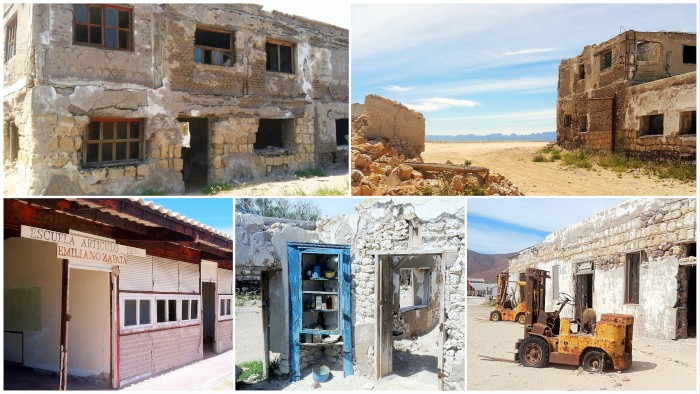
Bahia Salinas on Isla Carmen, Sea of Cortez, once had a bustling salt mining business. It was so successful it shipped salt world-wide, and it had a small town on the bay front to provide for the needs of the mining operation and for the needs of the workers and their families. Then several decades ago the business shut down, and the town became a ghost town.
Above are some photos I took of this ghost town on Bahia Salinas today.
The bottom right photo shows a piece of the old salt mining equipment, rusting in place as it was abandoned.
The bottom middle photo shows a cabinet with glassware inside it, still intact despite most of the house around it having fallen down. How could these artifacts still stand there, unmolested, after decades? They are protected by their remoteness. Only a few cruisers, like myself, and a few Mexican fishermen, find their way to this remote location in the Sea of Cortez. In a ghost town like Bodie, California, without protection from the state the town and artifacts would become defaced and stolen. But in Bahia Salinas, the remains of this town remain unmolested. The artifacts representing the life and hopes of poor workers and their families remain un-defaced.
On the bottom left you can see the school that once served the children of the miners. The school was named after a Mexican revolutionary, a contemporary of Poncho Villa but more of an exponent of the common, poor Mexican. Emiliano Zapata became a hero for many of the poor, and to this day some revolutionaries in Mexico take the name Zapatista. Marlon Brando portrayed Zapata in a movie, “Viva Zapata!” I doubt that any of the salt miners’ children who attended the Escuela Emiliano Zapata ever saw that Marlon Brando film, but I bet that those children learned that Zapata was a hero who had fought for poor people like them. The name on the school still stands today, as does the Zapatista spirit in parts of poor Mexico.
When I walked through the town I walked carefully, not disturbing, with respect for those who had lived there. I felt a commonality, for although those people had much poorer lives than have had I, we all have shared having hopes and dreams for something better.
When I walked back again past the Emiliano Zapata school, I stopped. I felt a kinship to all the children and their families who once were there.
Viva La Escuela Emiliano Zapata!
Above are some photos I took of this ghost town on Bahia Salinas today.
The bottom right photo shows a piece of the old salt mining equipment, rusting in place as it was abandoned.
The bottom middle photo shows a cabinet with glassware inside it, still intact despite most of the house around it having fallen down. How could these artifacts still stand there, unmolested, after decades? They are protected by their remoteness. Only a few cruisers, like myself, and a few Mexican fishermen, find their way to this remote location in the Sea of Cortez. In a ghost town like Bodie, California, without protection from the state the town and artifacts would become defaced and stolen. But in Bahia Salinas, the remains of this town remain unmolested. The artifacts representing the life and hopes of poor workers and their families remain un-defaced.
On the bottom left you can see the school that once served the children of the miners. The school was named after a Mexican revolutionary, a contemporary of Poncho Villa but more of an exponent of the common, poor Mexican. Emiliano Zapata became a hero for many of the poor, and to this day some revolutionaries in Mexico take the name Zapatista. Marlon Brando portrayed Zapata in a movie, “Viva Zapata!” I doubt that any of the salt miners’ children who attended the Escuela Emiliano Zapata ever saw that Marlon Brando film, but I bet that those children learned that Zapata was a hero who had fought for poor people like them. The name on the school still stands today, as does the Zapatista spirit in parts of poor Mexico.
When I walked through the town I walked carefully, not disturbing, with respect for those who had lived there. I felt a commonality, for although those people had much poorer lives than have had I, we all have shared having hopes and dreams for something better.
When I walked back again past the Emiliano Zapata school, I stopped. I felt a kinship to all the children and their families who once were there.
Viva La Escuela Emiliano Zapata!
"Getting Pooped": Fill'er Up! Pump'er Out!
06 March 2018 | Isla Coronados, Sea of Cortez, Mexico
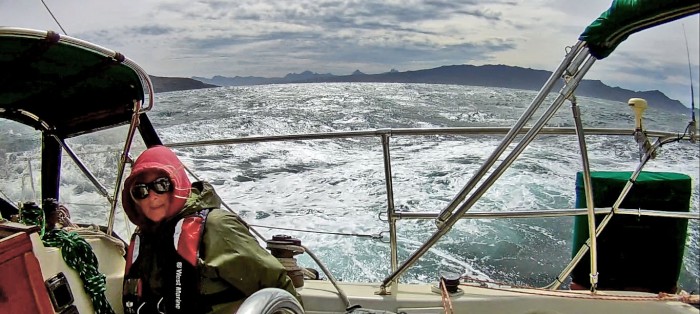
Fill her up, not with gas, with water! That's what The Sea sometimes does to cruising boats sailing the Sea of Cortez. The oceans and other large bodies of water do it too. Perhaps it's their way of keeping us sailors, who cruise in small boats these sometimes tempestuous large bodies of water, humble. Humble and occasionally wet.
When The Sea, or other body of water, decides to "Fill'er Up!" sailors call it "getting pooped". When you've gotten pooped, clothes soaked and maybe water below in the cabin, "getting pooped" seems to describe the result. It's as if The Sea squatted over your boat and....[enough said].
Here's how S/V Ubiquity got pooped yesterday. Geary (The Sea's weather forecaster, who gives weather forecasts on the Mexico HF radio cruisers' nets) had commented that morning that it was a bad day to sail The Sea, as it was the day with the strongest northerly winds. But Ubiquity's captain saw it as a good day to sail south, fast, from their protected anchorage behind Punta Pulpito to the shelter of the south side of Isla Coronados. The crew expressed her nervousness. We sailed Ubiquity off the anchor in winds in the 20's, and were sailing at hull speed (as fast as a boat can theoretically go) with only a headsail. The Monitor windvane was steering well. The seas were kicking up, but not as big as the captain had expected, but they were building. It was fast, exhilarating, and beautiful. We saw no other boats - maybe they had listened to Geary.
The waves on The Sea, the Sea of Cortez, differ from the ocean because The Sea does not have ocean swells which originate from thousands of miles away. But The Sea is still huge, 800 miles long, so she cooks up her own brew. In strong conditions the brew The Sea cooks up is short and steep. The waves are not as high as large ocean swells, but they are much closer together. Ocean swells of 8 feet in 14 seconds (the time between the swells) are not very steep and the boat rides those swells up and down. Seas on The Sea in a "Norther", strong northerly winds that rake The Sea this time of year, could be 7 feet in 4 seconds, very steep. Ocean meterologists at the U.S. NOAA will sometimes warn about "square seas", such as 10 feet in 10 seconds. NOAA's forecast for our location yesterday was for seas of 4-7 feet, period 6 seconds. 6 feet at 6 seconds is square, 7 feet at 6 seconds is steeper than square. Short period and steep, which unlike a long-period ocean wave is hard for the boat to ride up and down.
But that's not the total problem. Ubiquity was sailing fine in those waves. A little rough. Some spray would splash into the cockpit when a wave slapped the hull, once to my irritation getting several pages wet on a book I am currently reading (The Admirals by Walter Borneman, a great read that I recommend). But Ubiquity was sailing fine.
Add in a random component, also called "bad luck" or "being in the wrong place at the wrong time". Waves form complex patterns, and when the tops start breaking that happens unpredictably. In such conditions an excellent helmsmen can look back at the waves and steer away from anticipated problems. But steering for hours is tiring, and neither Ubiquity's captain nor crew could do that for long. But Ubiquity's Monitor windvane steering can. "Monty" does not get tired, and when the waves get bigger and the wind stronger, Monty gets stronger too. So Ubiquity's captain trusts Monty to steer well in rough following seas like we had yesterday.
But like human beings, Monty has limitations. Monty has no eyes. Monty could not see when the top of that threatening wave looming over Ubiquity's stern started to break. So Monty could not react. But the captain did see it and did react. He jumped up onto the cockpit benches, stradling both, held firmly onto the boom (sheeted firmly to centerline as the mainsail was not hoisted), and shouted the warning "It's going to get us!"
It got us. The thundering spray and foam filled Ubiquity's cockpit, and water went down below into the cabin. The crew was sitting in a bath tub. The captain was just as wet, as the effort of jumping up on the benches did not save him from getting soaked. As the captain watched how long it would take the cockpit scuppers to drain the cockpit, he heard the bilge pump come on below. The pump pumped, the scuppers drained. The captain went below to clean up the cabin, instructing the crew to insert the companionway boards (the need for which the captain had not perceived before) to prevent further water intrusion.
That's how you get pooped. Steep seas, and maybe some bad luck.
I have no photos of the steep seas that pooped Ubiquity, but the photo above shows Ubiquity after the pooping, in diminished seas. On the left you see the companionway boards now in place, the crew looking - well, less happy than later at happy hour after reaching a protected anchorage - and the peaks of the Baja in the background.
So The Sea humbled Ubiquity's captain and crew yesterday. The Sea surprised them. They did not anticipate the pooping. The damage was minor. The soaked clothes, shoes, and charts are drying out. So maybe the pooping was a needed warning against complacency, a minor chastisement, an admonishment to greater vigilance - a lesson from The Sea.
When The Sea, or other body of water, decides to "Fill'er Up!" sailors call it "getting pooped". When you've gotten pooped, clothes soaked and maybe water below in the cabin, "getting pooped" seems to describe the result. It's as if The Sea squatted over your boat and....[enough said].
Here's how S/V Ubiquity got pooped yesterday. Geary (The Sea's weather forecaster, who gives weather forecasts on the Mexico HF radio cruisers' nets) had commented that morning that it was a bad day to sail The Sea, as it was the day with the strongest northerly winds. But Ubiquity's captain saw it as a good day to sail south, fast, from their protected anchorage behind Punta Pulpito to the shelter of the south side of Isla Coronados. The crew expressed her nervousness. We sailed Ubiquity off the anchor in winds in the 20's, and were sailing at hull speed (as fast as a boat can theoretically go) with only a headsail. The Monitor windvane was steering well. The seas were kicking up, but not as big as the captain had expected, but they were building. It was fast, exhilarating, and beautiful. We saw no other boats - maybe they had listened to Geary.
The waves on The Sea, the Sea of Cortez, differ from the ocean because The Sea does not have ocean swells which originate from thousands of miles away. But The Sea is still huge, 800 miles long, so she cooks up her own brew. In strong conditions the brew The Sea cooks up is short and steep. The waves are not as high as large ocean swells, but they are much closer together. Ocean swells of 8 feet in 14 seconds (the time between the swells) are not very steep and the boat rides those swells up and down. Seas on The Sea in a "Norther", strong northerly winds that rake The Sea this time of year, could be 7 feet in 4 seconds, very steep. Ocean meterologists at the U.S. NOAA will sometimes warn about "square seas", such as 10 feet in 10 seconds. NOAA's forecast for our location yesterday was for seas of 4-7 feet, period 6 seconds. 6 feet at 6 seconds is square, 7 feet at 6 seconds is steeper than square. Short period and steep, which unlike a long-period ocean wave is hard for the boat to ride up and down.
But that's not the total problem. Ubiquity was sailing fine in those waves. A little rough. Some spray would splash into the cockpit when a wave slapped the hull, once to my irritation getting several pages wet on a book I am currently reading (The Admirals by Walter Borneman, a great read that I recommend). But Ubiquity was sailing fine.
Add in a random component, also called "bad luck" or "being in the wrong place at the wrong time". Waves form complex patterns, and when the tops start breaking that happens unpredictably. In such conditions an excellent helmsmen can look back at the waves and steer away from anticipated problems. But steering for hours is tiring, and neither Ubiquity's captain nor crew could do that for long. But Ubiquity's Monitor windvane steering can. "Monty" does not get tired, and when the waves get bigger and the wind stronger, Monty gets stronger too. So Ubiquity's captain trusts Monty to steer well in rough following seas like we had yesterday.
But like human beings, Monty has limitations. Monty has no eyes. Monty could not see when the top of that threatening wave looming over Ubiquity's stern started to break. So Monty could not react. But the captain did see it and did react. He jumped up onto the cockpit benches, stradling both, held firmly onto the boom (sheeted firmly to centerline as the mainsail was not hoisted), and shouted the warning "It's going to get us!"
It got us. The thundering spray and foam filled Ubiquity's cockpit, and water went down below into the cabin. The crew was sitting in a bath tub. The captain was just as wet, as the effort of jumping up on the benches did not save him from getting soaked. As the captain watched how long it would take the cockpit scuppers to drain the cockpit, he heard the bilge pump come on below. The pump pumped, the scuppers drained. The captain went below to clean up the cabin, instructing the crew to insert the companionway boards (the need for which the captain had not perceived before) to prevent further water intrusion.
That's how you get pooped. Steep seas, and maybe some bad luck.
I have no photos of the steep seas that pooped Ubiquity, but the photo above shows Ubiquity after the pooping, in diminished seas. On the left you see the companionway boards now in place, the crew looking - well, less happy than later at happy hour after reaching a protected anchorage - and the peaks of the Baja in the background.
So The Sea humbled Ubiquity's captain and crew yesterday. The Sea surprised them. They did not anticipate the pooping. The damage was minor. The soaked clothes, shoes, and charts are drying out. So maybe the pooping was a needed warning against complacency, a minor chastisement, an admonishment to greater vigilance - a lesson from The Sea.
Hunting the Grey Whales - Again
28 February 2018 | Santa Rosalia, Baja, Mexico
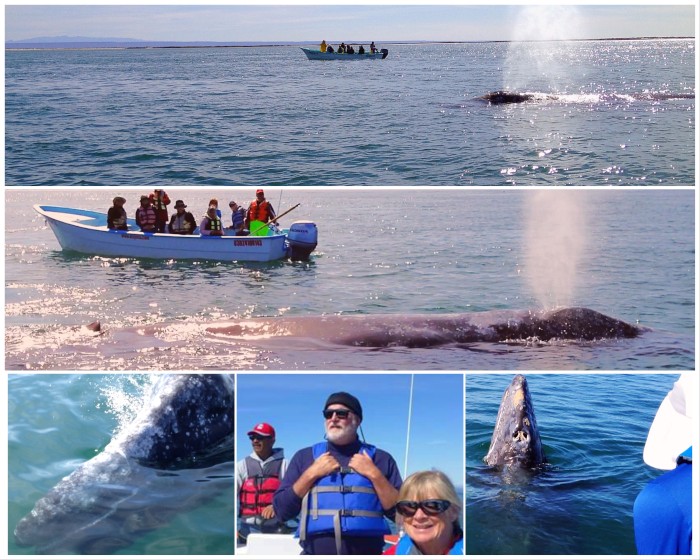
In the past two centuries humans hunted the Atlantic Grey Whale to extinction, and decimated the Western Pacific Grey Whale to near extinction today. Although the Eastern Pacific Grey Whales were severely diminished, they have re-bounded from near extinction to about 25,000 today, a fourth of their pre-whaling population.
Today it is easy to see Grey Whales if you sail a small boat on the west coast of Mexico, the U.S., and Canada, because the Eastern Pacific Grey Whales migrate between the Bering Sea off of Alaska and the huge lagoons and bays on the west coast of Baja Mexico. This annual migration, a round trip of over 10,000 miles, is one of the longest migrations of any animal.
Why do they migrate? The warm lagoons on the west coast of Baja provide protective waters for giving birth and for the baby whales to mature before making the long migration north to the Bering Sea. The Bering Sea provides a food-rich environment for the summer.
In the past the Grey Whales were hunted and killed in the lagoons of Mexico. Whaleman Charles Melville Scammon discovered the lagoons in the 1850's and harvested the Greys there with great success. After that the Baja lagoons were no longer filled with whales.
But once again this time of year the Baja lagoons are filled with whales, thanks to conservation measures that led to a rebound of the Eastern Pacific Grey Whale population.
And today those whales are hunted again in those lagoons - I did it yesterday. But we hunt not as whalers to kill the whales, but as fellow mammals to see, appreciate, photograph, relate, and sometimes even touch the whales. In turn, the whales coexist amicably with us, apparently taking care not to upset our small boats. They sometimes appear curious about us, especially the calves, the babies, and will "spyhop" with their heads straight up to look at us.
The bottom right photo above shows a baby "spyhopping" several feet from our boat, and the bottom left shows an adult swimming at the boat before diving below it.
You can see video of a mother and her baby calf surfacing between two tour boats. They have been feeding, which you can tell when the baby expels a large quantity of muddy water from his mouth. Grey whales are baleen whales, not toothed whales, and feed on small organisms, mainly krill. Grey whales are primarily bottom feeders, plowing furrows in the sand and mud on the sea floor, then using their tongue to force the water out through the baleen (like a strainer), leaving the krill for the whale to swallow. That's what the baby is doing when you see the muddy water spurt from his mouth. He is still nursing (and will for months), so he is probably still learning how to effectively bottom feed.
Another video shows an adult coming straight at our boat, then diving at the last minute and going under our boat.
A third video shows an adult in the distance spyhopping, and then conveys the excitement on our boat as whales surround us and dive beneath us.
Today it is easy to see Grey Whales if you sail a small boat on the west coast of Mexico, the U.S., and Canada, because the Eastern Pacific Grey Whales migrate between the Bering Sea off of Alaska and the huge lagoons and bays on the west coast of Baja Mexico. This annual migration, a round trip of over 10,000 miles, is one of the longest migrations of any animal.
Why do they migrate? The warm lagoons on the west coast of Baja provide protective waters for giving birth and for the baby whales to mature before making the long migration north to the Bering Sea. The Bering Sea provides a food-rich environment for the summer.
In the past the Grey Whales were hunted and killed in the lagoons of Mexico. Whaleman Charles Melville Scammon discovered the lagoons in the 1850's and harvested the Greys there with great success. After that the Baja lagoons were no longer filled with whales.
But once again this time of year the Baja lagoons are filled with whales, thanks to conservation measures that led to a rebound of the Eastern Pacific Grey Whale population.
And today those whales are hunted again in those lagoons - I did it yesterday. But we hunt not as whalers to kill the whales, but as fellow mammals to see, appreciate, photograph, relate, and sometimes even touch the whales. In turn, the whales coexist amicably with us, apparently taking care not to upset our small boats. They sometimes appear curious about us, especially the calves, the babies, and will "spyhop" with their heads straight up to look at us.
The bottom right photo above shows a baby "spyhopping" several feet from our boat, and the bottom left shows an adult swimming at the boat before diving below it.
You can see video of a mother and her baby calf surfacing between two tour boats. They have been feeding, which you can tell when the baby expels a large quantity of muddy water from his mouth. Grey whales are baleen whales, not toothed whales, and feed on small organisms, mainly krill. Grey whales are primarily bottom feeders, plowing furrows in the sand and mud on the sea floor, then using their tongue to force the water out through the baleen (like a strainer), leaving the krill for the whale to swallow. That's what the baby is doing when you see the muddy water spurt from his mouth. He is still nursing (and will for months), so he is probably still learning how to effectively bottom feed.
Another video shows an adult coming straight at our boat, then diving at the last minute and going under our boat.
A third video shows an adult in the distance spyhopping, and then conveys the excitement on our boat as whales surround us and dive beneath us.
Mi Amigo Diminuto
23 February 2018 | Santa Rosalia, Baja, Mexico

He's not big, but he is big in spunk. There he is in the photos above. In the photo on the right you can see him pretending to fight me; he even got in a kick (see photo here).
He is only four years old, but he can count to twenty. You can watch video online of him counting (with a little help from his grandmother).
He is only four years old, but he can count to twenty. You can watch video online of him counting (with a little help from his grandmother).
Do You Feel Lucky, Punk?
21 February 2018 | Santa Rosalia, Baja, Mexico

Yes, the captain of S/V Ubiquity faced another Dirty Harry moment when he looked at the kayak.
That kayak had transported Ubiquity’s captain and crew from their anchorage to the beach-side restaurant where they had been enjoying margaritas. The captain and crew depended on the kayak to return later to the boat. But the inflatable kayak was now deflated, flat.
The photo above, on left, shows the predicament. The kayak in the foreground looks not seaworthy in its deflated state. S/V Ubiquity in the background appears a long way away.
Knowing that cruisers must depend on their resourcefulness to overcome adversity, the captain opened the kayak’s repair kit and found glue, patches, and instructions. The instructions promised likely success for repairs up to 1/2 inch. The ripped seam on the kayak was open a full 4 inches.
Undaunted, the captain attempted the repair, and pronounced satisfaction with the result (See above photo, right).
Captain and crew now returned to their original intention of walking around the town and seeing the small museum. Before they launched the kayak the captain insisted on margaritas (two for him, one for the crew) to alleviate anxiety about the upcoming test of the repair - paddling the kayak out to S/V Ubiquity at anchor.
Another small point: there was one life jacket for the two paddlers. The captain insisted the crew wear the life jacket, but the crew nonetheless attempted to abandon the kayak trip by soliciting a ride to the sailboat on a ponga.
But the captain would not abide by the crew’s mutiny. It was a Dirty Harry moment, the captain explained. Captain and crew must find out together, paddling the long distance to the sailboat, if feeling lucky (the captain) or not feeling lucky (the crew) was correct.
Do you feel lucky, punk? Do you?
That kayak had transported Ubiquity’s captain and crew from their anchorage to the beach-side restaurant where they had been enjoying margaritas. The captain and crew depended on the kayak to return later to the boat. But the inflatable kayak was now deflated, flat.
The photo above, on left, shows the predicament. The kayak in the foreground looks not seaworthy in its deflated state. S/V Ubiquity in the background appears a long way away.
Knowing that cruisers must depend on their resourcefulness to overcome adversity, the captain opened the kayak’s repair kit and found glue, patches, and instructions. The instructions promised likely success for repairs up to 1/2 inch. The ripped seam on the kayak was open a full 4 inches.
Undaunted, the captain attempted the repair, and pronounced satisfaction with the result (See above photo, right).
Captain and crew now returned to their original intention of walking around the town and seeing the small museum. Before they launched the kayak the captain insisted on margaritas (two for him, one for the crew) to alleviate anxiety about the upcoming test of the repair - paddling the kayak out to S/V Ubiquity at anchor.
Another small point: there was one life jacket for the two paddlers. The captain insisted the crew wear the life jacket, but the crew nonetheless attempted to abandon the kayak trip by soliciting a ride to the sailboat on a ponga.
But the captain would not abide by the crew’s mutiny. It was a Dirty Harry moment, the captain explained. Captain and crew must find out together, paddling the long distance to the sailboat, if feeling lucky (the captain) or not feeling lucky (the crew) was correct.
Do you feel lucky, punk? Do you?
Hail the Hole!
21 February 2018 | Santa Rosalia, Baja, Mexico
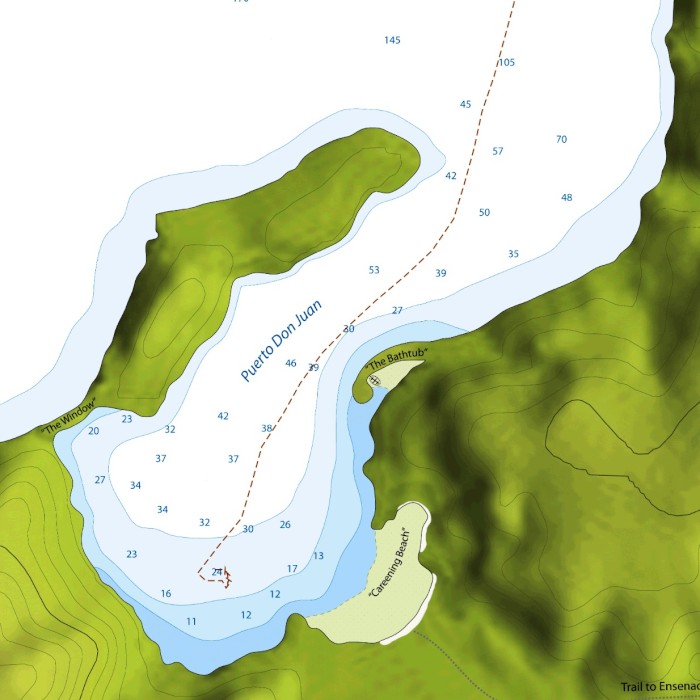
Some holes are not welcome, potholes for example.
“Hurricane holes” are welcome to cruisers, especially when high winds are forecast. And so S/V Ubiquity waited at anchor in Puerto Don Juan, shown above, when a gale warning was issued for the northern Sea of Cortez.
The chart above shows what makes a good hurricane hole. You can see on the chart S/V Ubiquity’s track into Puerto Don Juan to the place where she anchored. Once a boat is anchored inside, Puerto Don Juan offers protection from seas entering from any direction. Plus steep hills on the Baja side offer wind protection.
My friends Dave and Rhonda survived a hurricane, undamaged, in Puerto Don Juan on their sister ship to S/V Ubiquity, S/V Swan.
S/V Ubiquity faced nothing so ominous as did S/V Swan. So after a comfortable stay at anchor in Puerto Don Juan, after the strongest winds had abated, S/V Ubiquity thanked Puerto Don Juan for her good shelter and departed.
So for cruisers hurricane holes provide comfort, and sometimes survival.
“Hurricane holes” are welcome to cruisers, especially when high winds are forecast. And so S/V Ubiquity waited at anchor in Puerto Don Juan, shown above, when a gale warning was issued for the northern Sea of Cortez.
The chart above shows what makes a good hurricane hole. You can see on the chart S/V Ubiquity’s track into Puerto Don Juan to the place where she anchored. Once a boat is anchored inside, Puerto Don Juan offers protection from seas entering from any direction. Plus steep hills on the Baja side offer wind protection.
My friends Dave and Rhonda survived a hurricane, undamaged, in Puerto Don Juan on their sister ship to S/V Ubiquity, S/V Swan.
S/V Ubiquity faced nothing so ominous as did S/V Swan. So after a comfortable stay at anchor in Puerto Don Juan, after the strongest winds had abated, S/V Ubiquity thanked Puerto Don Juan for her good shelter and departed.
So for cruisers hurricane holes provide comfort, and sometimes survival.
In The Remote Midriff Islands
14 February 2018 | Isla Partida, near Bahia de Los Angeles
Brian Stipak
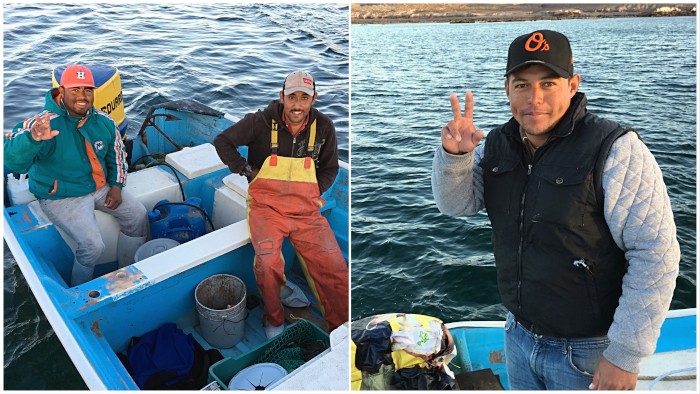
- Now anchored at Isla Partida north (Near Bahia de Los Angeles, not near La Paz), N 28 deg 53.5 min, W 113 deg 2.6 min -
We left San Carlos six days ago headed north, not south like most cruisers. South is towards warm weather and water; north is towards remoteness. We sailed towards Isla Tiburon and the Midriff Islands, at first slowly in light winds, wishing for more wind, and then a brisk sailing wind developed.
But be careful what you wish for: by 2:00 am the winds had increased into the 20's with steep seas for which the Sea of Cortez is notorious, and S/V Ubiquity was then hit by winds gusting into the 30's. I called for my crew, asleep below, to join me, and I struggled to put in a reef with water hitting me on the foredeck, and spray hitting my crew in the cockpit. Not long after getting in the reef conditions moderated, so we could have forgone the reef, but at the moment I felt we needed to prepare for worse or risk loosing control. Those of you who have sailed in such conditions can empathize.
In the morning I thought for a moment that dolphins had joined us, but they were sea lions. These sea lions appear smaller than ours in Oregon, and move gracefully more like dolphins, with a dolphin-like jump out of the water.
Isla Tiburon is the largest island in Mexico, but uninhabited. Arriving at the Los Perros anchorage on the southeast corner of the island we joined several large shrimp boats at the anchorage, anchoring inside of them in shallower water.
The sail around the south of the island the next day was scenic and delightful, anchoring on the west side of the island north of Punta Willard. Fishermen on a ponga visited us, wanting cigarettes and cigars, which we did not have. Instead I gave them a small, focusing LED flashlight, of the type I like and use (I brought some extras to give away). The fishermen offered us either shrimp or scallops, but I responded "Somos vegetarianos". I then asked if I could take their photos instead, and they gladly agreed (see photos above).
We sailed off the anchor Tuesday and after a leisurely sail in light wind reached Isla Partida, a beautiful anchorage. It is remote here. No other boats. Beautiful, large anchorage to ourselves. The waterfowl here are plentiful, and serenade us at night. Some sound like songbirds, others make a "caw" sound, probably the gulls. One bird stayed on the sidedeck of the boat at night; apparently using it as shelter to rest.
Are we really in Mexico? I ask because it rained yesterday and last night, and is now. Not a lot, but light rain, off and on. Here rain is a rarity, and this is the first rain we have seen in Mexico since Ensenada in February 2017, a year ago.
Although in a remote location, we have lots of comforts and technology. I sometimes watch at night episodes of the gold miners TV program I enjoy, which I downloaded for playback later on my iPad. I like my new Kindle reader, and am reading now the war memoirs of a German field marshal. We have printed books, too. We spend quite a bit of time studying guidebooks, charts, and weather. I have downloaded movies I could show on the iPad, with sound coming through the boat's stereo speakers, but so far we have not had time for such urban indulgences.
After doing some boat projects yesterday I kayaked ashore in the afternoon and hiked up to the summit of one of the two peaks forming Isala Partida. There was a cairn and a metal box with a register inside, just like on the many peaks of the mountains of the High Sierra that I have climbed. I signed the summit register. I was the first person to sign the register this year.
The last signature in the summit register was in July 2017. That is how remote it is here.
We left San Carlos six days ago headed north, not south like most cruisers. South is towards warm weather and water; north is towards remoteness. We sailed towards Isla Tiburon and the Midriff Islands, at first slowly in light winds, wishing for more wind, and then a brisk sailing wind developed.
But be careful what you wish for: by 2:00 am the winds had increased into the 20's with steep seas for which the Sea of Cortez is notorious, and S/V Ubiquity was then hit by winds gusting into the 30's. I called for my crew, asleep below, to join me, and I struggled to put in a reef with water hitting me on the foredeck, and spray hitting my crew in the cockpit. Not long after getting in the reef conditions moderated, so we could have forgone the reef, but at the moment I felt we needed to prepare for worse or risk loosing control. Those of you who have sailed in such conditions can empathize.
In the morning I thought for a moment that dolphins had joined us, but they were sea lions. These sea lions appear smaller than ours in Oregon, and move gracefully more like dolphins, with a dolphin-like jump out of the water.
Isla Tiburon is the largest island in Mexico, but uninhabited. Arriving at the Los Perros anchorage on the southeast corner of the island we joined several large shrimp boats at the anchorage, anchoring inside of them in shallower water.
The sail around the south of the island the next day was scenic and delightful, anchoring on the west side of the island north of Punta Willard. Fishermen on a ponga visited us, wanting cigarettes and cigars, which we did not have. Instead I gave them a small, focusing LED flashlight, of the type I like and use (I brought some extras to give away). The fishermen offered us either shrimp or scallops, but I responded "Somos vegetarianos". I then asked if I could take their photos instead, and they gladly agreed (see photos above).
We sailed off the anchor Tuesday and after a leisurely sail in light wind reached Isla Partida, a beautiful anchorage. It is remote here. No other boats. Beautiful, large anchorage to ourselves. The waterfowl here are plentiful, and serenade us at night. Some sound like songbirds, others make a "caw" sound, probably the gulls. One bird stayed on the sidedeck of the boat at night; apparently using it as shelter to rest.
Are we really in Mexico? I ask because it rained yesterday and last night, and is now. Not a lot, but light rain, off and on. Here rain is a rarity, and this is the first rain we have seen in Mexico since Ensenada in February 2017, a year ago.
Although in a remote location, we have lots of comforts and technology. I sometimes watch at night episodes of the gold miners TV program I enjoy, which I downloaded for playback later on my iPad. I like my new Kindle reader, and am reading now the war memoirs of a German field marshal. We have printed books, too. We spend quite a bit of time studying guidebooks, charts, and weather. I have downloaded movies I could show on the iPad, with sound coming through the boat's stereo speakers, but so far we have not had time for such urban indulgences.
After doing some boat projects yesterday I kayaked ashore in the afternoon and hiked up to the summit of one of the two peaks forming Isala Partida. There was a cairn and a metal box with a register inside, just like on the many peaks of the mountains of the High Sierra that I have climbed. I signed the summit register. I was the first person to sign the register this year.
The last signature in the summit register was in July 2017. That is how remote it is here.
Cruising Friends - Let’s Celebrate!
10 February 2018 | San Carlos, Sonora, Mexico
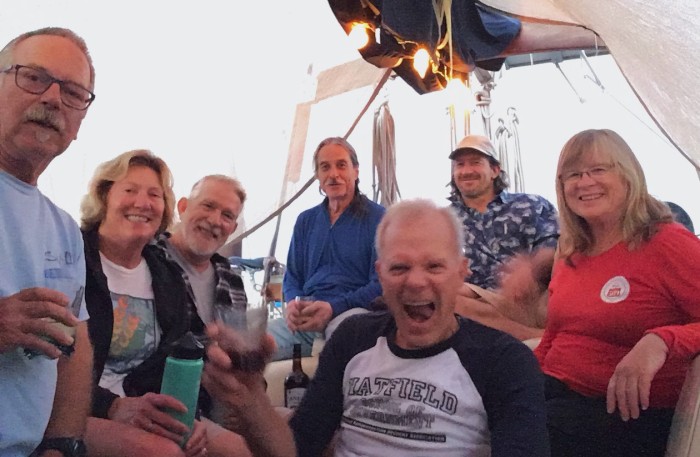
It takes only a little excuse for cruisers to celebrate together, typically enjoying happy hour on one of their boats. And the captain and crew of S/V Ubiquity do it too!
You may have gotten the wrong impression from some of my earlier posts, the posts about "eschewing the big happy hour dinghy raft-ups" down south when we choose instead to cruise north into the wilderness of the Midriff Islands. Yes, we are leaving in the morning for the Midriff Islands. But no, we do not eschew happy hours with our fellow cruisers when we get the chance.
See the photo above. We are enjoying happy hour on our friend Chuck's boat with some of our other cruising friends in Marina San Carlos. Do we have an excuse to celebrate? Of course, there is always an excuse ready. Our excuse last evening was to celebrate the imminent departure of S/V Ubiquity.
So thank you friends, fellow cruisers, for your friendship and support in San Carlos. Thank you for your happy hour last evening. Thank you for the light-hearted revelry, and the sometimes more thoughtful discussions of American history. Thank you for your wishes of good luck. The whales and other wildlife, and the wilderness, we hope to see sailing to the Midriff Islands and Bahia de Los Angeles can not replace you. But neither can you replace the whales. So despite that we will miss you and your camaraderie, S/V Ubiquity sails north in the morning.
When we sail north, we celebrate the upcoming adventures, but we also celebrate our cruising friends in San Carlos. And that is a great excuse for happy hour when S/V Ubiquity reaches her first anchorage in the Midriff Islands.
You may have gotten the wrong impression from some of my earlier posts, the posts about "eschewing the big happy hour dinghy raft-ups" down south when we choose instead to cruise north into the wilderness of the Midriff Islands. Yes, we are leaving in the morning for the Midriff Islands. But no, we do not eschew happy hours with our fellow cruisers when we get the chance.
See the photo above. We are enjoying happy hour on our friend Chuck's boat with some of our other cruising friends in Marina San Carlos. Do we have an excuse to celebrate? Of course, there is always an excuse ready. Our excuse last evening was to celebrate the imminent departure of S/V Ubiquity.
So thank you friends, fellow cruisers, for your friendship and support in San Carlos. Thank you for your happy hour last evening. Thank you for the light-hearted revelry, and the sometimes more thoughtful discussions of American history. Thank you for your wishes of good luck. The whales and other wildlife, and the wilderness, we hope to see sailing to the Midriff Islands and Bahia de Los Angeles can not replace you. But neither can you replace the whales. So despite that we will miss you and your camaraderie, S/V Ubiquity sails north in the morning.
When we sail north, we celebrate the upcoming adventures, but we also celebrate our cruising friends in San Carlos. And that is a great excuse for happy hour when S/V Ubiquity reaches her first anchorage in the Midriff Islands.
Opulence in San Carlos
09 February 2018 | San Carlos, Sonora, Mexico
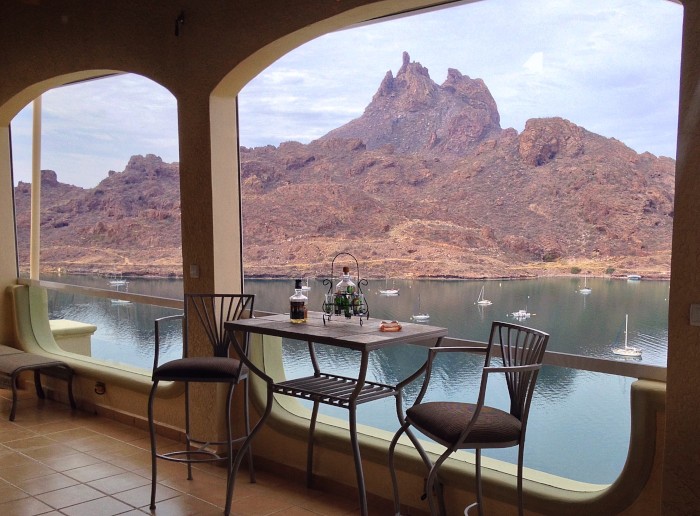
San Carlos, Sonora, is a suburb of the working class city of Guaymas. It developed as an upper class resort area for mainly Americans and Canadians. This week I did a tour of homes in the San Carlos area, a tour that displayed well the opulence of the area. Just look at the photo above.
The more opulent housing is mainly waterfront property, or else view property higher up and overlooking the water and the two marinas. If you are interested, I have photos you can see on-line of properties I viewed on the tour.
Do any of you feel distaste for the opulent indulgence? Perhaps sympathy for the working class centered in Guaymas, and perhaps even disapproval of the comparatively wealthy North American interlopers?
If so, not so quick! When was the last time you were helping the poor in Guaymas, because that is exactly what all those people were doing - the hundreds of Americans and Canadians participating in the San Carlos tour of homes.
The tour of homes is an annual event for raising money to send many Mexican children to high school, who would otherwise be too poor to attend (High school education is not publicly funded here). The 430 people on the tour each paid 400 pesos, which goes to funding the children. The people showing their homes freely did so for the cause. And afterwards, at the country club on the golf course, as margaritas were served en masse, the participants spent money liberally at the auctions also in support of the children's education.
Americans and Canadians, mostly elderly and retired, have organized widely to develop and support charitable causes here to benefit the locals, including education, vocational training, senior care, and a women's shelter.
I admire the many people here who devote countless hours, and money, to helping the less fortunate. I admire their selflessness - even if they live in opulent homes.
The more opulent housing is mainly waterfront property, or else view property higher up and overlooking the water and the two marinas. If you are interested, I have photos you can see on-line of properties I viewed on the tour.
Do any of you feel distaste for the opulent indulgence? Perhaps sympathy for the working class centered in Guaymas, and perhaps even disapproval of the comparatively wealthy North American interlopers?
If so, not so quick! When was the last time you were helping the poor in Guaymas, because that is exactly what all those people were doing - the hundreds of Americans and Canadians participating in the San Carlos tour of homes.
The tour of homes is an annual event for raising money to send many Mexican children to high school, who would otherwise be too poor to attend (High school education is not publicly funded here). The 430 people on the tour each paid 400 pesos, which goes to funding the children. The people showing their homes freely did so for the cause. And afterwards, at the country club on the golf course, as margaritas were served en masse, the participants spent money liberally at the auctions also in support of the children's education.
Americans and Canadians, mostly elderly and retired, have organized widely to develop and support charitable causes here to benefit the locals, including education, vocational training, senior care, and a women's shelter.
I admire the many people here who devote countless hours, and money, to helping the less fortunate. I admire their selflessness - even if they live in opulent homes.
Heading North in the Sea of Cortez - Watch the Midriff!
03 February 2018 | San Carlos, Sonora, Mexico
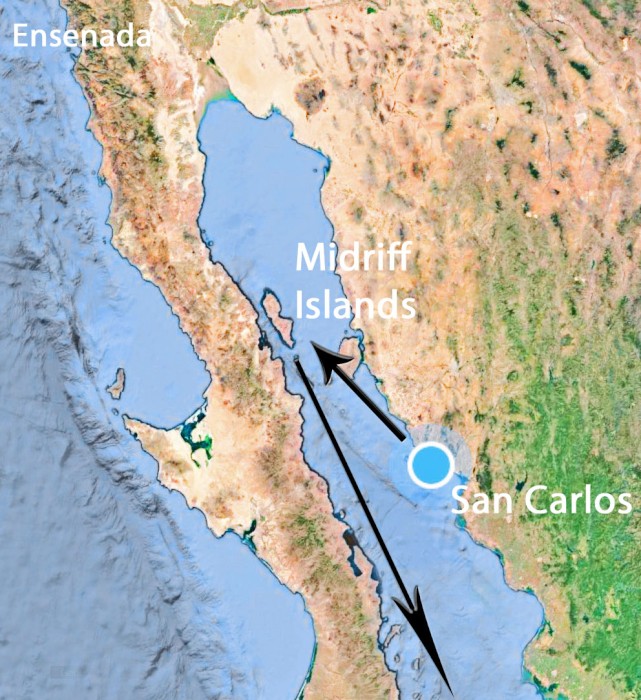
No, not your midriff, but instead the Midriff Islands in the Sea of Cortez. Aptly named, the Midriff Islands cross the Sea about one half to two thirds of the way up from the Sea's entrance, and cruisers seldom visit them because of their remoteness and their cold temperatures and high winds in winter.
John Steinbeck called the Midriff Islands the "Galapagos of Mexico". Imagine over 30 pristine islands with unique and rare marine and desert animals. Envision countless birds, sea lions, mountains, white sand beaches and clear skies perfect for nighttime star gazing.
This region harbors great biodiversity, adapted to the conditions of the Sonoran Desert. Hundreds of thousands of marine birds come here to nest. Half of the world's population of California Brown Pelicans nest in the Midriff Islands. In the surrounding waters are twenty-three species of marine mammals and five species of turtles. Among marine visitors are eight species of whales, including the largest three in the world - Blue, Fin, and Sperm Whales.
As the captain and crew of S/V Ubiquity prepare to say goodbye to the San Carlos area and to resume cruising in the Sea of Cortez, they look forward to seeing the midriff - no, not your midriff, the Midriff Islands! From San Carlos they intend to head north to the Midriffs, cross to the Baja, and continue exploring the Baja in the Bahia de Los Angeles area and southward.
John Steinbeck called the Midriff Islands the "Galapagos of Mexico". Imagine over 30 pristine islands with unique and rare marine and desert animals. Envision countless birds, sea lions, mountains, white sand beaches and clear skies perfect for nighttime star gazing.
This region harbors great biodiversity, adapted to the conditions of the Sonoran Desert. Hundreds of thousands of marine birds come here to nest. Half of the world's population of California Brown Pelicans nest in the Midriff Islands. In the surrounding waters are twenty-three species of marine mammals and five species of turtles. Among marine visitors are eight species of whales, including the largest three in the world - Blue, Fin, and Sperm Whales.
As the captain and crew of S/V Ubiquity prepare to say goodbye to the San Carlos area and to resume cruising in the Sea of Cortez, they look forward to seeing the midriff - no, not your midriff, the Midriff Islands! From San Carlos they intend to head north to the Midriffs, cross to the Baja, and continue exploring the Baja in the Bahia de Los Angeles area and southward.
Marco Polo Travels Across Cultures, and Across Generations
01 February 2018 | San Carlos, Sonora, Mexico
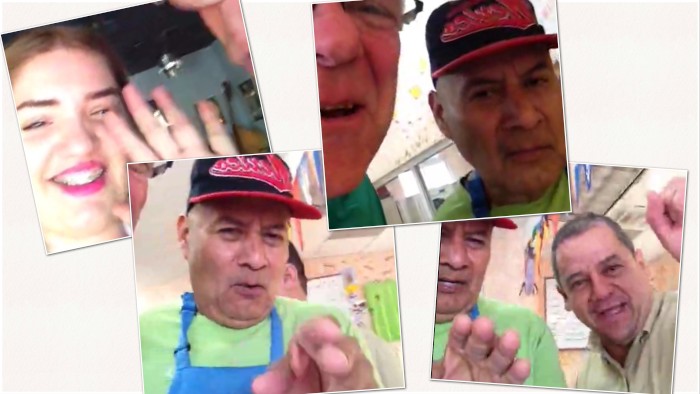
No, not Marco Polo the eleventh century explorer, but Marco Polo the iPhone app. Marco Polo the app makes video-texting easy, and I use it now while in Mexico to video-text with my grandkids (actually, my friend Lisa's grandkids, but I've seen them since they were really small so I'm like a grandfather to them). But how does this transcend cultures and generations?
In Mexico, I've been enlisting my Mexican friends to join in with my video-texts to the grandkids, and everyone loves to do it. The culture here is family-oriented, so all I need to do is show a bit of the video clip of Mila (seven years old) counting to ten in Spanish, and the adults fall all over themselves joining in the videos and helping. So the Marco Polo video clips are connecting people across countries, cultures, and generations.
And that's what Marco Polo the explorer did too. So the "app" was "aptly" named!
If you would like to see my friends in Mexico falling all over themselves to "Marco Polo" across countries, cultures, and generations, here are some Marco Polo videos I sent:
Elena instructs Mila on counting to ten in Spanish.
Fernando jokes and instructs Mila.
Fernando, with the help of Caeser, instructs Buggy.
Keman helps Mila with counting, but acts like she does not know how to count.
In Mexico, I've been enlisting my Mexican friends to join in with my video-texts to the grandkids, and everyone loves to do it. The culture here is family-oriented, so all I need to do is show a bit of the video clip of Mila (seven years old) counting to ten in Spanish, and the adults fall all over themselves joining in the videos and helping. So the Marco Polo video clips are connecting people across countries, cultures, and generations.
And that's what Marco Polo the explorer did too. So the "app" was "aptly" named!
If you would like to see my friends in Mexico falling all over themselves to "Marco Polo" across countries, cultures, and generations, here are some Marco Polo videos I sent:
Elena instructs Mila on counting to ten in Spanish.
Fernando jokes and instructs Mila.
Fernando, with the help of Caeser, instructs Buggy.
Keman helps Mila with counting, but acts like she does not know how to count.
The Rape of the Sea of Cortez and the Theft of the Water of the West
01 February 2018 | San Carlos, Sonora, Mexico
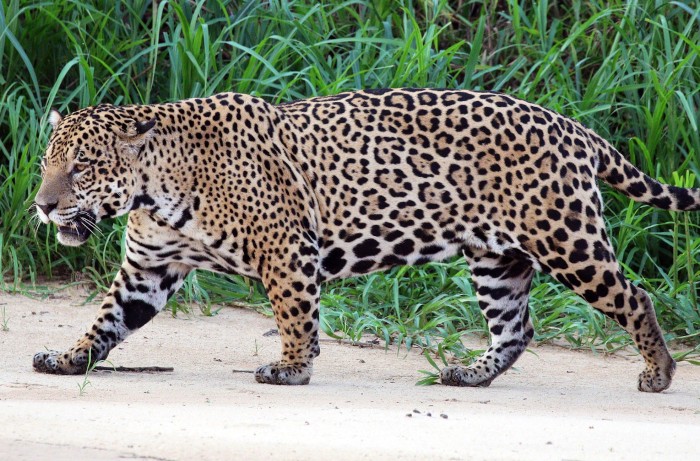
Until the early 20th century the Colorado River ran free from the Rocky Mountains to the Gulf of California, the Sea of Cortez. The water and the silt deposits from the river nourished one of the largest and lushest estuaries in the world, supporting a large population of plant, bird, aquatic, and terrestrial life. Beaver, deer, coyotes, and even jaguar - the third largest cat in the world (after the lion and tiger) - lived in the delta at the head of the Sea of Cortez.
The diversion of water by dams in the U.S. has today reduced the delta to a remnant of residual wetlands and brackish mudflats. The abundant animals and plants native to the original delta are largely gone. Do not expect to see a jaguar there today.
At one of my many happy hours in Mexico I once had a Mexican man I was talking to, feeling the drink as was I, become incited about the injustice to Mexico brought by American politics - but not the contemporary American politics of President Trump, but rather the injustice of the Mexican-American war that took from Mexico California, Texas, and more. I mollified him by pointing out that my ancestors migrated from Europe to the United States fifty years after the Mexican-American war, so he could not hold me responsible!
But my Mexican drinking friend erred. He cited the wrong injustice. My father worked for years for the Bureau of Reclamation that runs the dams that robbed the water from the Sea of Cortez. But my friend probably did not know of that injustice. And you probably do not either.
If you want to learn about the fascinating history of the development of water resource policy in the American west, read The Cadillac Desert, an excellent polemical book developed later into a PBS documentary series.
For something less intellectual and more entertaining watch the movie Chinatown. You must watch that movie if you have not, if only for the outstanding performances of Jack Nicholson and Faye Dunaway.
But besides a great entertaining movie, in the background of the movie Chinatown is part of the story of the theft of the water of the west, the theft of the water from California's Owens Valley. That theft denuded the valley and it's agriculture, dried up Owen's Lake and partly dried up Mono Lake, leaving the dried lake beds to cause dust storms to destroy the once pristine air quality. The ranchers of Owens Valley took up arms and dynamited the aqueduct being built to steal their water. But the ranchers were far to weak to resist the thousand-man army sent in by the thief, the City of Los Angeles.
The Mexicans did not know that their natural allies, to fight the theft of the water for the estuary at the head of the Gulf of California, were the Owens Valley ranchers. But even allied with them their power would have been far too weak to stop the rape of the Sea of Cortez.
The diversion of water by dams in the U.S. has today reduced the delta to a remnant of residual wetlands and brackish mudflats. The abundant animals and plants native to the original delta are largely gone. Do not expect to see a jaguar there today.
At one of my many happy hours in Mexico I once had a Mexican man I was talking to, feeling the drink as was I, become incited about the injustice to Mexico brought by American politics - but not the contemporary American politics of President Trump, but rather the injustice of the Mexican-American war that took from Mexico California, Texas, and more. I mollified him by pointing out that my ancestors migrated from Europe to the United States fifty years after the Mexican-American war, so he could not hold me responsible!
But my Mexican drinking friend erred. He cited the wrong injustice. My father worked for years for the Bureau of Reclamation that runs the dams that robbed the water from the Sea of Cortez. But my friend probably did not know of that injustice. And you probably do not either.
If you want to learn about the fascinating history of the development of water resource policy in the American west, read The Cadillac Desert, an excellent polemical book developed later into a PBS documentary series.
For something less intellectual and more entertaining watch the movie Chinatown. You must watch that movie if you have not, if only for the outstanding performances of Jack Nicholson and Faye Dunaway.
But besides a great entertaining movie, in the background of the movie Chinatown is part of the story of the theft of the water of the west, the theft of the water from California's Owens Valley. That theft denuded the valley and it's agriculture, dried up Owen's Lake and partly dried up Mono Lake, leaving the dried lake beds to cause dust storms to destroy the once pristine air quality. The ranchers of Owens Valley took up arms and dynamited the aqueduct being built to steal their water. But the ranchers were far to weak to resist the thousand-man army sent in by the thief, the City of Los Angeles.
The Mexicans did not know that their natural allies, to fight the theft of the water for the estuary at the head of the Gulf of California, were the Owens Valley ranchers. But even allied with them their power would have been far too weak to stop the rape of the Sea of Cortez.
Sailboat Owners Have Low IQ’s - More Evidence
23 January 2018 | San Carlos, Sonora, Mexico
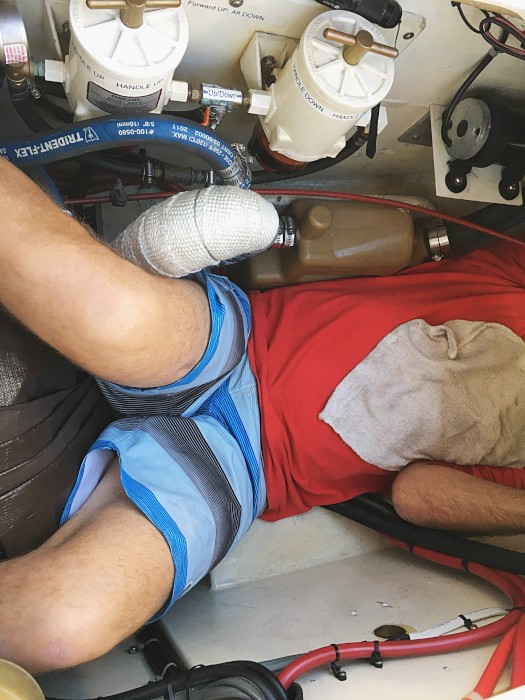
The evidence is visual, above. There I am lying in the engine compartment, contorted, tormented, inspecting and greasing the steering cables and the idler pulleys. My legs rest on top of the engine and the cockpit sole is above my head. Basically, I am trapped. The last time I did this my crew had to pull on my legs to try to get me back out. This time I managed to wiggle my head into the opening, and do a tricip extension (like the second half of a bar dip) to push myself into freedom. At 70 years old I felt good I could do that; can you other 70 year olds do that?
But the more fundamental point is why did I choose to put myself into that tormented position, chosen at my own free will and at great expense (all the money spent on the boat), anyway?
Do sailboat owners have low IQ's? Q.E.D.
But the more fundamental point is why did I choose to put myself into that tormented position, chosen at my own free will and at great expense (all the money spent on the boat), anyway?
Do sailboat owners have low IQ's? Q.E.D.
Whether? Depends on Whither the Weather.
23 January 2018 | San Carlos, Sonora, Mexico
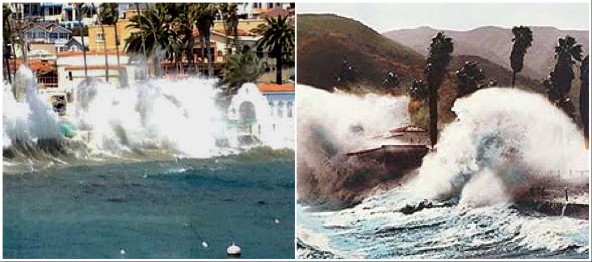
Cruising sailors understand the imperative of informing our decisions with study of the up-coming weather. Hence the importance of deciding whether based on whither the weather.
The photos above show Avalon Harbor, Catalina Island, California, which was so serene and calm when we were there in January. But these photos shows the ferocity of strong Santa Ana winds hitting Avalon, sometimes killing people caught in those conditions on their boats.
The same weather phenomenon is happening here, in The Sea, right now, except here we call it not a "Santa Ana" like they do in Southern California, but instead a "Norther". The fierce "Norther" winds, blowing south and raking The Sea right now, originate just like the "Santa Ana" winds from high pressure in the southwestern U.S. plateau region. That high pressure spills into Southern California and the Sea of Cortez, creating Santa Ana's and Norther's.
In both places, boaters must seek shelter. In The Sea cruisers seek shelter behind islands or in bays offering protection from the north. One of my experienced cruising friends, thinking S/V Ubiquity was already cruising again in The Sea, messaged me today, "I see you are having a strong northerly. Where did you seek shelter?" Luckily, I could respond, "In Marina San Carlos", since we had not yet left to resume cruising.
As we come closer to Ubiquity being ready again to cruise, I find myself watching more the weather. Prudence demands such attention this time of year from any sailors heading northward and crossing The Sea.
Prudent sailors understand that whether depends on whither the weather.
The photos above show Avalon Harbor, Catalina Island, California, which was so serene and calm when we were there in January. But these photos shows the ferocity of strong Santa Ana winds hitting Avalon, sometimes killing people caught in those conditions on their boats.
The same weather phenomenon is happening here, in The Sea, right now, except here we call it not a "Santa Ana" like they do in Southern California, but instead a "Norther". The fierce "Norther" winds, blowing south and raking The Sea right now, originate just like the "Santa Ana" winds from high pressure in the southwestern U.S. plateau region. That high pressure spills into Southern California and the Sea of Cortez, creating Santa Ana's and Norther's.
In both places, boaters must seek shelter. In The Sea cruisers seek shelter behind islands or in bays offering protection from the north. One of my experienced cruising friends, thinking S/V Ubiquity was already cruising again in The Sea, messaged me today, "I see you are having a strong northerly. Where did you seek shelter?" Luckily, I could respond, "In Marina San Carlos", since we had not yet left to resume cruising.
As we come closer to Ubiquity being ready again to cruise, I find myself watching more the weather. Prudence demands such attention this time of year from any sailors heading northward and crossing The Sea.
Prudent sailors understand that whether depends on whither the weather.
Parsimony versus Complexity - Which Fits Reality?
20 January 2018 | San Carlos, Sonora, Mexico

The graphic above I first posted on the web many decades ago (hence the low resolution). Putting aside the issue of explicating male-female differences, for which transgressions I am surely already on the radical feminists' hit list, the issue this graphic raises is timeless and profound - parsimony versus complexity.
Let me explain how I came to this profundity today. I begrudgingly lowered myself into the engine compartment of Ubiquity to investigate the hydraulic oil leak I had observed in the hydraulic autopilot. To my delight I found that the "leak" I had observed was only from grease that had dripped from the hydraulic ram in the hot summer heat. That, plus my misreading the fluid level in the hydraulic reservoir, led me to the false conclusion that I had an hydraulic leak in the ram, the piston that drives the autopilot. I then shirked for a week looking further at the problem.
My investigation today once again affirmed my humanity, that I err. There was no leak at all. Of course, to figure that out I suffered contortions for an hour in the engine compartment, checking and testing, but the end result delighted me. Hurrah for no hydraulic leaks and for our humanity!
Luckily I was an empiricist, not a deductionist like Aristotle. Aristotle proffered that women had fewer teeth than men. But not believing in empiricism he never looked into his wife's mouth to count her teeth and discover his error.
But I did crawl into the engine compartment, endured discomfort for my belief in anti-Aristotelian empiricism, and discovered my error.
So Ubiquity's autopilot is fine.
But what about parsimony versus complexity?
In discomfort today crammed into Ubiquity's engine compartment, I marveled at the Rube Goldberg complexity of the autopilot: I push buttons and the electronics sends electricity to an electric motor; the motor operates a pump, the pump pumps hydraulic fluid, the hydraulic fluid pushes out or brings in an hydraulic ram, the ram connects to the steering quadrant, the steering quadrant turns the rudder shaft, and the rudder shaft turns the rudder.
The complexity sounds like Rube Goldberg, if you know the complexity is there, but most people don't understand enough to know that complexity exists. So maybe Rube Goldberg complexity is always there when you know enough to realize it.
BUT. In science scientists always value PARSIMONY - the simplest explanation is the best. Choose the simplest explanation that fits the evidence!
By the principle of parsimony you can dismiss, for example, most conspiracy theories. Who killed JFK? Oswald, that is the simplest answer that fits the evidence. Of course, sometimes there are real conspiracies, like the assassination of President Lincoln, and the evidence will require a more complex explanation.
And dear reader, for those of you still here with this blog post, how do you explain THIS, this post? Invoke parsimony. After my contortions in the engine compartment today, I mollified myself, and celebrated my glad discoveries about the autopilot, with margaritas at Club de Capitans. You need no more complex explanation.
Let me explain how I came to this profundity today. I begrudgingly lowered myself into the engine compartment of Ubiquity to investigate the hydraulic oil leak I had observed in the hydraulic autopilot. To my delight I found that the "leak" I had observed was only from grease that had dripped from the hydraulic ram in the hot summer heat. That, plus my misreading the fluid level in the hydraulic reservoir, led me to the false conclusion that I had an hydraulic leak in the ram, the piston that drives the autopilot. I then shirked for a week looking further at the problem.
My investigation today once again affirmed my humanity, that I err. There was no leak at all. Of course, to figure that out I suffered contortions for an hour in the engine compartment, checking and testing, but the end result delighted me. Hurrah for no hydraulic leaks and for our humanity!
Luckily I was an empiricist, not a deductionist like Aristotle. Aristotle proffered that women had fewer teeth than men. But not believing in empiricism he never looked into his wife's mouth to count her teeth and discover his error.
But I did crawl into the engine compartment, endured discomfort for my belief in anti-Aristotelian empiricism, and discovered my error.
So Ubiquity's autopilot is fine.
But what about parsimony versus complexity?
In discomfort today crammed into Ubiquity's engine compartment, I marveled at the Rube Goldberg complexity of the autopilot: I push buttons and the electronics sends electricity to an electric motor; the motor operates a pump, the pump pumps hydraulic fluid, the hydraulic fluid pushes out or brings in an hydraulic ram, the ram connects to the steering quadrant, the steering quadrant turns the rudder shaft, and the rudder shaft turns the rudder.
The complexity sounds like Rube Goldberg, if you know the complexity is there, but most people don't understand enough to know that complexity exists. So maybe Rube Goldberg complexity is always there when you know enough to realize it.
BUT. In science scientists always value PARSIMONY - the simplest explanation is the best. Choose the simplest explanation that fits the evidence!
By the principle of parsimony you can dismiss, for example, most conspiracy theories. Who killed JFK? Oswald, that is the simplest answer that fits the evidence. Of course, sometimes there are real conspiracies, like the assassination of President Lincoln, and the evidence will require a more complex explanation.
And dear reader, for those of you still here with this blog post, how do you explain THIS, this post? Invoke parsimony. After my contortions in the engine compartment today, I mollified myself, and celebrated my glad discoveries about the autopilot, with margaritas at Club de Capitans. You need no more complex explanation.
| Vessel Name: | Ubiquity |
| Vessel Make/Model: | Pacific Seacraft 34 sailboat, 1987, hull #67 |
| Hailing Port: | Portland, Oregon |
| Crew: | Brian Stipak, Leslie Sawyer, sometimes others |
| About: | |
| Home Page: | http://web.pdx.edu/~stipakb/Ubiquity-Cruising.html |
| Social: |
Ubiquity's Photos - Puerto Escondido to La Paz

